

The SPIEL '15 Games Convention |
|
Right, so here we go. As Frank has already given you impressions of the press conference and the news show, we can go directly to the halls to play the first games. Just one thought about the news show: it is amazing and almost crazy how many new games find their way to Essen year after year. I really hope, that my and our preselection was quite successful, so that we can present you some of the gems from SPIEL2015. Entering the halls on Wednesday is new for me, because in former years I was always still working for my daily job on this day. So I stood there, nearly awestruck at the entrance of Hall 1. It is quite amazing seeing the passages without being surged by a wild horde of players looking for the next game table: only exhibitors and some other journalists. But also still frantic preparations at the one or other booth. Difficult to imagine, that tomorrow SPIEL will really open its gates for the public. ![[SPIEL]](ess15066.jpg) ![[SPIEL]](ess15067.jpg) I still had some time before my first date, so I took the opportunity for a first walk-through the various halls. A lot of publishers have booths at the same locations like last year, but there are also some changes and I also found a lot of new booths I have not seen so far. So in passing I already made myself a plan of how I can reach the booths I want to attend most efficiently. A date by a publisher takes me about 1-1,5 hours and as we want to present you as many games as possible, there is not much time for sticking in the crowd. First stop for me was the booth of REBEL. Well at least it should have been. I was heading for their new Termites but they had some problems with the production, so they could not show it to me today. They still hope that they will have it by tomorrow, so we made a new appointment for tomorrow afternoon. So I quickly went over to the booth of the Polish Publishing league, which is a group of 9 smaller Polish publishers. We will be back here the days to come, but for today I only had one appointment with Alex Biela from GAME FABRICA. Review: Trash'n Roll (Game Fabrica, Booth 2-B110)
Who has not dreamed of being part of a successful Heavy Metal band back in the eighties of the last century. OK, probably the younger of you, have not. But for all those people who grew up with bands like Led Zeppelin, Deep Purple, Metallica and Iron Maiden and who have played some kind of musical instrument that could have been used in a band, there was only one dream. At least that was one of my dreams when I was about 15 years old and played the guitar. This is now long ago, but when I heard that GAME FABRICA would release Trash'n Roll, a game in which players try to hit the charts with a Heavy metal band, I at once approached the author and scheduled a demo session for this convention. And so I am sitting here at the booth of GAME FABRICA and send my band to concerts and let them record singles and albums. This works pretty straightforward: eight different locations can be found on the huge game board. In our turn we can send our band to one location with the help of dice. So each round begins with a rolling of our available six dice. To go to a location a specific number of dice is necessary, but if you need more than one die, it is necessary to use dice of the same value or dice that form an increasing progression. Also at most locations, the more dice you spent the better the result of the action. This goes on clockwise until all players have passed. ![[SPIEL]](../../../bilder/tranrol2.jpg) Possible outcomes of the visits vary from improving your equipment of the band, gaining levels of experience or fame, drawing special fan, scandal or character cards that can compensate dice results and will help you at special locations and situations, and sending your band recording singles or albums. Finally some locations let you use your recorded albums to gain even more fame. At the end of the turn, there is a scoring for the success of the recorded albums and singles. The success depends on the chart positions. This in turn is a result of your experience, your hardware and the success of already published singles and a factor of luck, represented by a die. ![[SPIEL]](../../../bilder/tranrol3.jpg) At the end of the game all bands are invited for a final concert, the Trash'oScare ceremony. This results in a final scoring for all those different albums and the best artists. Of course it is fame we are heading for, because this is what the real Heavy Metal artists are longing for. I pretty much liked my first game of Trash'n Roll, although the element of the dice for choosing your location is not exactly what you would call ground-breaking. And you also need some time to get really used doing metal with your dice. But I liked the funny cards, the really great and unique theme (it doesn't have to be Star Wars, fantasy or Middle-age all the time). In fact Alex Biela told me that Trash'n Roll is the only game worldwide focusing on a heavy metal band. The game evokes your desire to record an even more successful album and this thought kept me quite happy all the time. So, if you have a tiny predilection for Heavy Metal or at least for music in general I would recommend to have a look for this game. After that first game experience I went back to the news show were I had my next appointment. On my way I found many publishers still quite busy unpacking their games and arranging their booths. But in contrast to the situation this morning, you already could see much more people playing games and now you can imagine, that this here will truly be the place of game's capital the next four days. ![[SPIEL]](ess15068.jpg) In the press-room I met Thibaut Quintens from BLACKROCK GAMES where he awaited me with quite a bundle of new games. I was most interested in Piratoons, because I had seen some interesting pictures and had already read a lot about the game, so let us start with this. Introduction: Piratoons (Blackrock Games, Booth 3-P104)
In Piratoons players compete to recruit pirates and assemble the best ship to look for the legend of Pelican's Tooth. The game caught my attention, because I love pirate games and the design of the game material looked attractive and funny to me. What I did not expect after my first glimpse was the fact that Piratoons is a game of speed in which players are asked to choose crew members and equipment for their ships from a treasure chest simultaneously and as soon as possible. But OK, why not, it does not have to be a complicated, high strategic game all the time. Each round begins with supplying the treasure chest with new, randomly chosen equipment and boat tiles. At the beginning our ship really looks poorly, consisting only of the bow and stern. No impressive masts, sails or gun. Not even reasonable middle parts. All these must be acquired from the treasure chest. For this, at a command, the chest is turned over and all players simultaneously place their crew-members on the tiles they want to add to their boat. Once a sand-timer runs out, each player may cry out Stop which puts an end to this phase and no other player may add another crew member. ![[SPIEL]](../../../bilder/piraton2.jpg) In the following plunder phase, the players take the equipment tiles on which they have the most crew members. In case of a tie, all of the tied crew-members are removed from the tile, so a third player with less crew members could win the tile. After another auction phase for left over equipment, all the boat and equipment tiles must be placed on each player's boat (if that is possible). In the end various scoring for different majorities and matching equipment take place. ![[SPIEL]](../../../bilder/piraton3.jpg) Piratoons reminded me faintly on Galaxy Trucker. Well it is not that complex and the ships are not tested in mining field and other annoyances. But you have the same time factor for expanding your ship. Of course, Piratoons is much more a game for the whole family, especially because the placement phase is without a time limit. At the moment I would say next to a family it can also serve as a nice filler game for adults, especially because of the easy rules and the beautiful graphics. If you are attending the fair and are interested in Piratoons you should not miss a tombola BLACKROCK GAMES starts every day at 6 pm for all people who either played or bought the game at their booth on that day. They raffle an impressive version of the treasure chest in wood and cork as you can see in the photo I have shot for you. Additionally there comes a small expansion with this goodie, captain meeples, that can be placed on several boat and equipment tiles. ![[SPIEL]](../../../bilder/piraton4.jpg) After we had spoken about Piratoons, Thibaut also showed me another, really great looking domino game, called Aya. It is fully cooperate and together the players build a chain of dominos. This chain of dominos represents a river that connects different landscape tiles. It is the player`s aim to take pictures of wild animals along this river by placing these photo tokens on top of the dominos. But players also must place the dominos and photo tokens wisely, because at the end, the domino chain will be launched and only photos that are still on top of the corresponding dominos count as victory points. I pretty muched liked the design of the game and the great material. Here in Essen they only have prototypes, but Thibaut explained, that they plan to release the game in the next month. ![[SPIEL]](../../../bilder/aya1.jpg) So my first day at the fair ends here, well at least almost. I still had to meet Frank for discussing our experiences for today. And where did I find him? Right, drinking some mead at Fragor Games, where they were giving a gnome party for celebrating the release of their new board game A game of Gnomes. ![[SPIEL]](ess15069.jpg) ![[SPIEL]](ess15070.jpg) |
The Lamonts and the SPIEL - wasn't there some kind of tradition? YES, OF COURSE, and so let me start this year's
![[SPIEL]](ess15071.jpg)
Once again, I am happy to announce that the Lamonts have sponsored a copy of their new game A Game of Gnomes for the annual SPIEL PRIZE DRAW! All you have to do to get a copy is…
![[SPIEL]](ess15072.jpg)
After this gnomical experience Ralf and I left the halls, but we actuallz returned once more in the evening, attending the awards ceremonz and the dinner of the DEUTSCHER SPIELE PREIS. The first place was won by Simone Luciani's and Daniele Tascini's The Voyages of Marco Polo which has been published by HANS IM GLÜCK. Ralf and I enjoyed a quite nice evening, sharing a table with my long time friends Dagmar and Ferdinand DeCassan and Petr Murmak and Matus Kotry from CZECH GAMES EDITION who had been attending the show because Matus' Alchemists had won the ESSENER FEDER for the best-structured rulebook.
![[SPIEL]](ess15073.jpg)
![[SPIEL]](ess15074.jpg)
![[SPIEL]](ess15075.jpg)
![[SPIEL]](ess15076.jpg)
Overall, it has been a long, enjoyable day, and now I am really looking forwards to get some sleep!
Wow, so far the week has passed incredibly fast! And here we go: SPIEL '15 - first public opening day.
Actually, the first opening day always sees some kind of small organizational problems, and it has been the same this year. Trying to enter ahead of the opening times with my Press Pass, I was stopped at the publishers gate and being told that no press people were allowed to enter until the official opening time of 10 AM. Well, I was told later by a representative of the MERZ VERLAG that this won't happen again tomorrow, but due to this unforeseen stop I was able to experience entering the SPIEL from a quite different perspective. So, I joined the crowd, eagerly waiting for the gates to open. In the end, I ended up entering the halls at about 9.50 AM, 10 minutes ahead of the regular opening time. Outside was quite abit of rain, and since the lobby was too crowded the security service wanted the crowed to disperse and opened up the gates…
![[SPIEL]](ess15077.jpg)
Like every year, I had a bit of free time before my first meeting on this first opening day, and so I used the time to check whether my friends from SMOOTHIE GAMES finally had arrived, and indeed I met Jerry Wong and his team setting up the booth. They are attening the SPIEL for the first time, presenting their new Zombie-game Dark Age Z which I has presented you on tuesday. At the moment they are also doing a manga-like witchcraft cardgame called MageCraft in cooperation with CRIMSON DESIGN, and I will be meeting the designer tomorrow morning for a demo session.
![[SPIEL]](ess15078.jpg)
With these worries being put at ease, I made my way through the crowd for the first playtesting sessions of the morning. Another friend of mine, Vangelis Bagiartakis from Greece, actually has designed and edited games for several companies this year, and so we will be meeting not once but twice. Tomorrow I will be checking some games at the booth of DESYLLAS GAMES, a Greek company which is also making its first appearance here at the SPIEL, but today I was actually heading for ARTIPIA> GAMES.
![[SPIEL]](ess15079.jpg)
Arriving at the booth a few minutes ahead of Vangelis, I was able to spay into a running game of The PURSUIT OF HAPPINESS, and when Vangelis arrived it turned out that he had done the editing of the game. Since no table was free to launch a game of his new design DICE CITY, Vangelis first gave me an intro to The Pursuit if Happiness to shorten the waiting time.
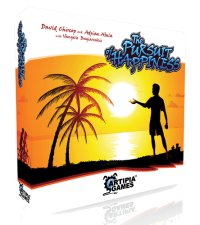
A topic which has not yet been exploited in dozens of boardgames is the simulation of a person's way of life. Of course everybody will know MILTON BRADLEY's classic The Game of Life, but over the last few years there only have been some few tries to design games following the topic. The games which spring to my mind are Filip Milunski's CV, a light-footed tactical dice rolling game from 2013, and the more strategic and humorous Fiese Freunde, Fette Feten (aka Funny Friends) which has been created by Friedemann Friese in 2005. However, I have always felt that this topic needed to be explored further, and so I was quite happy when I first heard about the upcoming release of The Pursuit of Happiness at the SPIEL 15. The year before ARTIPIA GAMES had released Lap Dance, proving that Konstantinos Kokkinis and his crew have a good hand for games with unusual topics, and now he has given designers Adrian Abela and David Chircop a possibility to present their take on a boardgame simulation of a person's way of life.
In its basic orientation, The Pursuit of Happiness is a classic resource management game where the players have to manage their available resources in form of Knowledge, Creativity, Influence and Money. More unusual is the fact that the players also have to manage Time in form of Hourglass Markers, but more about this later. During the game the players will strive to collect Long Term Happiness points, and the player who has lived the happiest life will be declared the winner. The game runs for a minimum of 5 rounds (1 round of Adolescence, 4 rounds of Adulthood), but for some players it may continue for up to three more rounds of Old Age, provided the players have managed to live healthy enough to grow that old.
At the beginning of the game each player will receive a Childhood card, listing the starting resources and also a special ability which the player may use throughout the game. In addition, each player will receive a reservoir of six Hourglasses, and in the course of a round these will be used by the players to mark their chosen actions. As hinted earlier, the amount of time (= Hourglasses) available to a player is not fixed, but instead the number of available Hourglasses depends on a player's individual Stress Level. Many actions during the game (splitting up from a partner, giving up on a job etc.) cause a player to gain stress, possibly loosing him one or more Hourglasses at the beginning of the next round. Through certain card actions the players have a chance to regain their balance or, even more positively, get relaxed, and sooner or later they will have to take care if their Stress Level rises. Quite fittingly, the game associates a player's death with the Stress Level getting too high, and in coherence with this stands the mechanism that the Stress Level will be given an additional rise for each round of Old Age. As can be guessed, only a well-balanced player will stand a chance against an ever-rising Stress level.
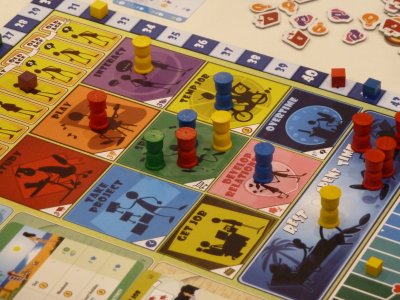
During each round, the players can spend their Hourglasses for a range of possible actions, with some actions like getting a job being unavailable during Adolescence and the taking of overtime being banned once the game reaches Old Age. Some of the available actions simply are focused on gaining some resources (studying, playing, interacting), whereas others allow the players to gain a card from one of the categories available on the gameboard. During their "lives", the players can get a job, take on projects, spend money for items and activities and develop a relationship, and for all these alternatives a quite wide range of cards is available on the gameboard, with the display being renewed at the beginning of each round.
Of course, the successful taking of such a card will require a player to spend some of his resources, and most of the cards then will provide new resources and either Short or Long Term Happiness. Long Term Happiness are the game's Victory Points, whereas the shifting of Short Term Happiness will begin anew at the beginning of each round. A good value of Short Term Happiness will give a player a benefit whenever he has to fulfil the requirements of some cards, and so the players will try to work out a fitting action sequence for each round of play, structuring their lives in the most fulfilling (or efficient) way.
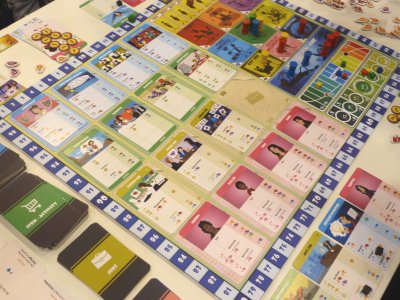
So far the spending and gaining of resources through different card types doesn't seem too innovative, but in The Pursuit of Happiness the designers have found some rather good mechanisms for integrating each category of cards into the flow of the game. Whereas some Project and Activity cards operate on a basic mechanism of giving and receiving, other cards like Jobs or Long-term Project's require a player's continuing dedication, costing Hourglasses and other resources if the player wants to keep the card and possibly advance to a higher level (as indicated by a token placed on the individual card). For example, a player may take up a certain Job card by spending an amount of resources, and from now on he will receive an income at the beginning of each round, but at the same time the player also will have to spend Hourglasses each round to stay devoted to the job. The development of a relationship is similar, with the player needing to spend ever more time to keep his partner happy, and if the player does not fulfil the continuing requirements of a card, the card will be discarded, causing a small rise of the Stress Level and a loss of Short Term Happiness. As indicated, many of the cards can also be upgraded, and so a relationship goes from dating to the raising of a family, whereas job cards possibly can be exchanged for higher-ranking job cards of the same type if the player qualifies for a promotion.
The different approach chosen for each card type is the element which makes the game quite variable, giving the players - within the restrictions of a family boardgame - the valid option to develop a quite unique vita. The game doesn't give the players any specific parameters how they should organize their lives, and so they can chose any available partner of their liking (or even multiple partners), or try to make a living without any kind of permanent job. In addition, many of the cards approach activities with a quite humorous undertone, and this neatly increases the game's entertainment value. However, the game's mechanisms respond quite well in terms of a rising Stress Level if the way of life chosen by a player gets too frantic, and that's the point where the players possibly have to react to prevent an early death.
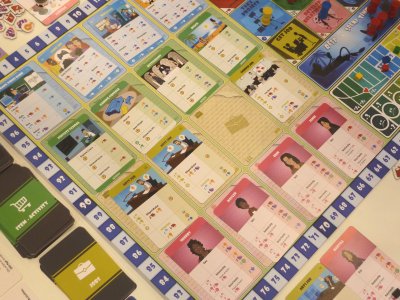
Indeed, The Pursuit of Happiness is a game where everybody will die in the end, and in this aspect the game certainly goes a bit further than the already named older games dealing with the same topic. This final note will leave the players a bit pensive when the game is over, looking at all the things which will have happened during their 2nd life. Nonetheless, I like the thought provoking approach which has been chosen by the designers, especially since the game itself operates on a quite intelligent implementation of the resource management mechanism.
A factor which the game is lacking is player interaction. Yes, there is competition for the available cards, and there are also some unique Life Goals which can only be fulfilled by a single player, but apart from these and some Projects which can be taken by two or more players together there is no way to directly interact with another player. The Pursuit of Happiness is a game of balancing and optimizing which draws its attractiveness from the fact that each player will be left with his own vita when the game is over. In this respect the game is quite fascinating, in my view even counterbalancing the low level of player interaction. If played with a group of good friends, there is deemed to happen some secondary kind of interaction, since the players probably will discuss the differences between their real and their in-game vita.
After about 20 minutes Vangelis and I finally got a chance to sit down in order to try Dice City, and since I had read the rules of the game ahead of the show we were able to start right away!
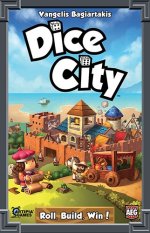
With the cuddly citizens printed on the box cover, the new ARTIPIA game Dice City certainly reminds of the happy farmer on the cover of Imperial Settlers. Indeed, both games share not only the rather cute graphics, but both of them are focusing on the players developing their cities/empires by constructing new buildings which will give them new abilities. However, that's the point where the major similarities end, since - as suggested by the game's name and the subtitle "Roll, Build, Win!" - Dice City is all about rolling dice!
So, once again we are seeing a game employing a dice placement mechanism, and I must confess that I am always quite eager to try games from this category. Usually modern dice games like Nations: The Dice Game, Ancient Terrible Things or Kingsburg all share a somewhat lighter strategic approach and a manageable playing time, and from my perspective these are factors which greatly increase a game's replayability. But let's now turn towards Dice City…
In Dice City every player possesses his own City board, featuring a gridwork of 5 rows with 6 locations each. The locations initially printed on the board form an outer ring of resource-producing locations which is arranged around an inner cluster of city locations which may provide military strength, victory points and re-rolls. During the course of the game the players will use resources to purchase new Location cards with better abilities, and the newly purchased locations will be placed on the buyer's City board, always covering an already existing location.
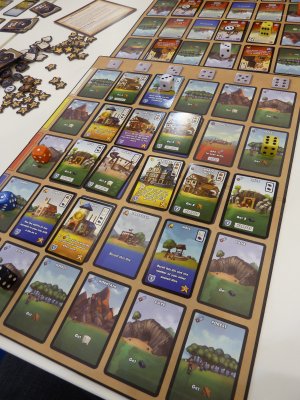
The namegiving dice come into the city as a means for activating the locations. Each player possesses a total of 5 different coloured dice, and each of these colours corresponds to one row of locations on the player's City board. So, during setup every player will roll his hand of dice for the first time, placing each dice on the location which can be identified by the dice's colour and the number rolled. Then the players start taking turns, and during a turn a player activates the functions of the buildings which have received a dice in an order of his choice, generating resources, military power and using some other special functions.
The intelligent usage of the locations is the key element of the game, since the relatively high pace on which the game advances does not really pardon major timewasting. So, the players need to generate resources in order to purchase new location cards from an open, partly random display, and as explained these newly bought locations then will be used to cover already existing locations on a player's City board. As a rule, the new locations have better abilities than the starting locations, so that the players may produce more resources etc.. In addition, the new locations usually will count for some victory points which the owning player can take into his calculation when the game is over
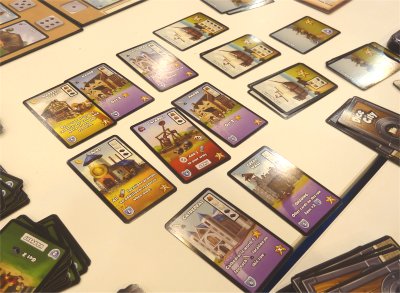
The military strength generated by the players can be used in three different ways, and it can even be split up in order to use two or three of these options together. So, a player may use his military to attack bandits (gaining a card worth some victory points), to attack another player's building(s) (gaining victory points and deactivating that building) and to steal resources from other players. The deactivation of buildings may seem to be a quite harsh way of direct player interaction, but the effects of such an attack are well balanced with other elements of the game, and a player actually can re-activate a building just by spending one dice.
The game is over when most bandits have been defeated, when most trading ships (to which resources can be delivered for victory points) have left the harbor, or when the deck of Location cards has been exhausted. Now the players will add up their victory points from locations, ships, bandits and tokens gained during the game to determine the winner.
Vangelis Bagiartakis has done a great job in streamlining this cute little game, keeping the buildings functions quite straightforward but still giving the players some more interesting options in comparison to a game like Machi Koro.There are several possible ways to win the game, following either economic or militaristic strategies. The whole design of Dice City shows that Vangelis has designed quite a few games over the last year, since he successfully smoothened away some minor effects which would have been harmful for the game's balance. For example, each turn a player may opt not to use one of his dice, and instead he will receive a Pass token which can be collected for later turns. In later turns two Pass tokens can be used repeatedly to gain one resource or one military strength or to force another player to re-roll one of his dice, and so Vangelis turned a possible waste of time due to an unfitting roll into a nice compensatory effect. Mind you, the future mayor of Dice City still needs a bit of a lucky hand, but nobody should be deterred from trying this game just by fear of surrendering himself to uncontrollable luck. A good choice of buildings and their positioning on the gameboard is essential!
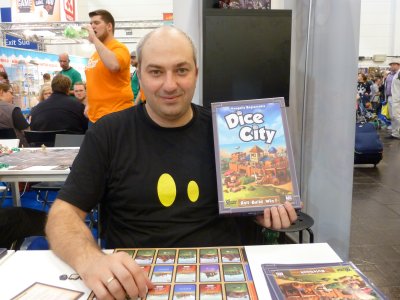
This did not quite finish my visit to ARTIPIA GAMES, since Konstantinos Kokkinis wanted to present me an additional prize for this year's prize draw. Returning from the games cabinet, Konstantinos brought along a rather big box, and so I am delighted to announce…
![[SPIEL]](ess15080.jpg)
Project Elite, Konstantinos' own design, is a cooperative real-time speed dicegame in which the players have to defend Earth against Alien invaders. The game has been realized through a quite successful crowdfunding project, and now one box of can be won just by …
Having a bit of free time left before my lunch break back at home, I went to Hall 3 where I had seen the rather cute looking Wild West decorations on the booth of PRETZEL GAMES during setup. I had heard that Flick'em Up actually is supposed to be a dexterity game, and with these games being among the current gaming trends I wanted to learn more about the game. Arriving at the booth, I was happy to get a demo game with one of the rather stunningly looking super.size games, and I was also given the fitting outfit to pose as one of the bad guys…
![[SPIEL]](ess15081.jpg)
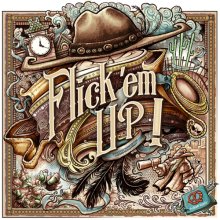
The basic rules of Flick'em Up! were explained to me in a matter of 2 or 3 minutes. In the chosen setting I took control of the bad guys, riding into town with the aim to kill at least three citizens. The Citizen player on the other hand had to shoot one of my outlaws out of the saddle, steal the horse and gallop through the Canyon at the end of the board to get the Cavalry. Sounds a bit like High Noon, doesn't it?
Movement and shooting of the individual cowboys is done by shooting (snipping) wooden disks on the table, with the disk being replaced once more by the playing figures at their final stopping place. When the disks hit an obstacle, the player's turn is over, but otherwise he might have another action, using a smaller disk which is placed next to his cowboy to shoot someone. The shot is successful if the target meeple is knocked over, loosing him a precious lifepoint.
![[SPIEL]](ess15082.jpg)
The horses actually come with the Flick'em Up! Stallion Canyon expansion, and to shoot a rider the shooter actually may use a small ramp to get is shot flying. If the rider is thrown from the saddle, another player may try to shoot his movement disk right under (or through) the legs of the horse, and if successful the player is allowed to claim the horse for his own, offering him higher movement capabilities due to double movement actions.
![[SPIEL]](ess15083.jpg)
The game components like the building fronts, the barrels and the cacti do not only look cute, but many playing components actually serve an in-game purpose. So, the clock on one of the buildings is used as a turn marker, and the displays for the Character tiles of both opposing sides are a rather good method for keeping the player order and for keeping an overview of the Life points of each cowboy, since markers for lost Life points will be taken from there and are inserted into the display by a slot. Even the coloured hat rings of each cowboy serve a purpose, since they are turned around if the cowboy has taken a turn, marking that this cowboy has to wait until the next round for his next activation.
A lot of care and love seems to have gone into the design of Flick'em Up!, and the outcome is an incredibly fun and rather addictive game which will appeal to families and hobbyists alike. Although the price is high (100 Euros for the basic game plus the expansion), you will not only get lots of premium components and a wooden box for your money, but a game as thrilling as the best western movies!!!

But now it's lunchtime. Let's see what Ralf has been doing all day!
|
Today we had perfect weather for the SPIEL here in Essen: rain everywhere you were looking. There is no better place to be than in the convention halls. And look, doesn't this red thing I saw from my car window look like one of the gnomes of the new FRAGOR game? ![[SPIEL]](ess15093.jpg) Only the way to the convention halls had still to be mastered by many, many people. Luckily enough I had the instinctive not to take the autobahn, because there was a huge queue waiting for the parking areas. ![[SPIEL]](ess15094.jpg) It is good to be a local in such a situation, so I could take a secret path (I will not tell on the internet) and safely arrived at SPIEL fast and dry after about 15 minutes of car driving from my home. I arrived at the entrance 5 minutes before ten, so I thought to be one of the first ones to enter the halls. But of course this was a mistake. In contrast to yesterday, all passages were already blocked. What always surprises me, are the people who - right after entering the halls - have nothing better to do than queue up for buying or looking for games they want to buy. Look at the huge queue at the booth where HEIDELBERGER is selling some older games for bargain. The people you see in the picture still have to go around the corner right at the edge of the picture. I would guess that these are about 30 metres or more. This is almost crazy due to the fact that the people not even know which game they will find behind the booth screens. ![[SPIEL]](ess15095.jpg) But this in fact is the SPIEL. Of course there are also people who are running for free tables at their favourite publishers. That is more to my taste, although I was lucky to have arranged the demo meetings, so I was not forced to run myself. So first stop will be at HORRIBLE GAMES. I hope you also love more or less crazy games? And perhaps you also like Dungeon Fighter (still one of my favourite games), Co-Mix or Steam Park? Then you will be right at the booth of Horrible Games and Lorenzo Silva. I personally love the ideas of this Italian author and publisher. The themes and the storyline of his games are usually extremely funny and the game mechanics are refreshingly different. All of his games up to know had great illustrations, perfectly adjusted to the cool stories. So I came with high expectations. Review: Potion Explosion (Horrible Games, Booth 3-P108)
Potion Explosion, a kind of puzzling game, in which players are doing their exams in potion at the Horribilorum Sorcery Academy (any resemblance to Harry Potter's school of witchcraft and wizardry is purely coincidental, I was promised (But why does the headmaster then answers to the name of Albedus Humblescore, one could ask? Well better not ask, I thought and concentrated on the rules)). We still needed some fellow players and as we did not find any volunteers, I called for my wife and my son and together with a friend of my son we completed our gaming group. Equipped with two Bunsen burners (in form of a player board), each burner filled with a starting potion recipe, we began the game. Our potion recipes, lovingly designed in form of a flask, have holes for necessary ingredients that come in form of coloured marbles from a dispenser. It is this dispenser that is the actual reason why Potion Explosion again is something very special. In other words: the dispenser is the heart of the game. 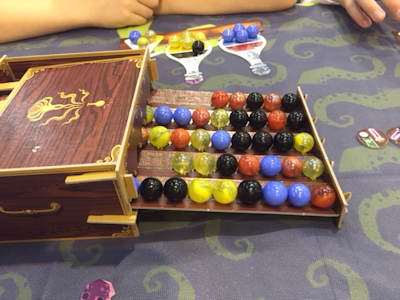 From a tank all marbles put into the dispenser roll down and fill five tracks of a slide. As a result you, in your turn can pick from eight marbles on each of the five tracks. Now the reason why Potion Explosion is a puzzling game is that whenever marbles of the same colour collide after the picking of a marble from a track, it comes to an explosion. The player who started this explosion must take all of the marbles of that colour, too. This of course initiates another roll of marbles down the track which can lead to further explosions again. So by cleverly choosing the first marble you can start a chain reaction that brings you a lot of new ingredients for your potions. 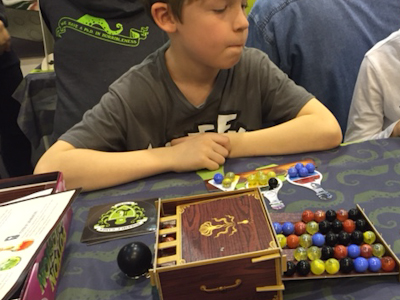 Once completed, potions are taken as victory points to the private area of the player. But that is not all. In later turns they can also be drunk which inducts special abilities which of course is pretty cool. 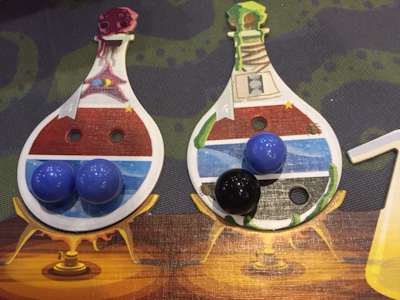 Playing Potion Explosion was really great. I love puzzling games and especially the dispenser seems to be a really new and funny element in boardgames. Again HORRIBLE GAMES seems to have created a very unique game. I am already looking forward for more potion brewing in the weeks to come. At the moment I think that Potion Explosion could become one of my favourite filler games for my various board game meetings. My family, especially my son, already expects to be included in further play-testing. After this first impressions for today, I had to run myself, too. There were only some minutes before my next appointment, so we better go directly to the next game: Introduction: Kumo Hogosha (Morning Players, Booth 1-F131)
Looking one last time through Eric's Essen SPIEL preview on BGG three weeks ago, Kumo Hogosha, a game with some kind of sumotori caught my eye, just because of the great cover. At the time I looked, I could not find really much information about the game. But I had a good feeling and so I wrote to the French publisher MORNING PLAYERS (that up to now only distributed games) to set-up a demo meeting during SPIEL. No sooner said than done and so I am sitting here with Valentin from the MORNING GROUP for an introduction to Kumo Hogosha. First thing I had to learn was that a Kumo Hogosha is a guardian of the clouds, a skilled man who is selected by the gods to become some kind of demigod. To find the right people for this, the gods have nothing else to do than setting up a tournament, in which strong warriors, called the Kumotori, fight against each other to find the worthy winner. 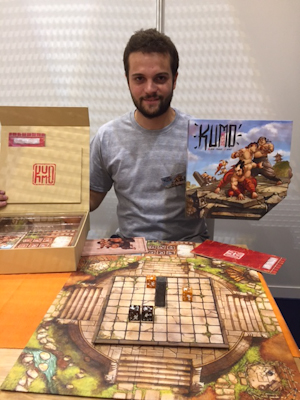 The game can either be played by two players or by four. I would say that is originally a two player game, for in the case of four players, you play in teams. And in fact Valentin told me that balancing the game for two players was quite easy, but for four players it was much more difficult. But in the end they seemed to be content. 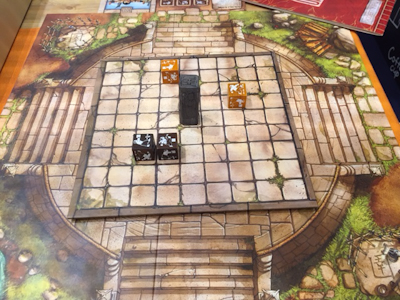 Each player has his own area in form of a small player board where he places his Kumotori. In the game these warriors are six-sided dice, each side showing a different movement symbol. These warriors are sent to the arena, a rotating board of 9x9 square fields, each big enough for one die, that is placed between the player boards. Once placed in the arena, the upper side of a die determines the possible movement of a warrior. It is the aim of each player to push the Stone of Balance (an impressive clay cuboid) outside the arena into an opponent's camp. Of course this Stone of Balance is placed in the middle of the arena at the beginning of the game. That sounds rather unspectacular, but easier said than done.  To push the stone the players have to enter the arena with their Kumotori, reach the stone and fight against their competitor(s), who are trying the same, only that they want to push the Stone in the other direction. Each turn, the active player has five actions. Most important, of course, is the movement. For this I can either move a Kumotori the simple way (move to an adjacent space) or I can use the advanced movements, that are shown on upper side of a die. There are indeed some very nice movements to push the stone and fight your competitors. Certain movements even allow to arrest your opponents, sending them to a prison zone at the edge of the game. These imprisoned warriors can be released again (1 action), but must enter the arena from the edge of the arena. So they loose a lot of speed and must laboriously reach the fighting zone again. Valentin explained that in the core game of Kumo Hogosha each player has the same set of dice, but maybe in the future there will be other clans with different abilities and movements. Of course it is also possible to change the active side of a die, but on the other hand this will lose time, because it costs you another action. This alone could be an interesting game, but what really ransacked my brain was the fact, that you also can rotate the whole arena by 90 degree for one action each. So you see yourself confronted with totally new game situations unless you are able to plan ahead and guess what your competitor(s) will do the next turn. Like Unita by HELVETIA GAMES in the year before, Kumo Hogosha uses the die as a game piece and not for rolling. The upper side gives the active strength of this game piece. It was this element and the idea of the rotating arena that tempts me in. I think that Kumo Hogosha is one of the games that needs to play in series. Like with chess it seems to be necessary to fully understand your availably movements in a given situation. I would think that the game has a steep learning curve, but I also think that it will be best, if you and your competitor(s) are at the same level and perhaps even have reached the top. It is a game without a luck factor, so you it really seems to be necessary to know what you are doing to win the game. Great design of game materials, beginning with the box and ending with the Stone of Balance. After this experience I once again had no time to rest, so let us right go ahead to the next booth: A game I still admire, although the first edition is already over ten years old, is the great War of the Ring. It is now produced by ARES GAMES and still fascinates many players. So I was very excited when I heard that Roberto di Meglio, author and publisher, announced the first expansion for the second edition of War of the Ring. Would it be like the first expansion for the first edition? I must be honest. I have played many games of War of the Ring and I also have the expansion Battles of the Third Age, but I seldom used the expansion. The core game seems to be so complete that, even you put some elements of the expansion to the game, you do not seem to need them. ![[SPIEL]](ess15096.jpg) So I had mixed feelings and I told my minds to Roberto. And he? He approved. So that is why they changed quite a lot in this new expansion. The basic idea of the expansion is to strengthen the individual characters and some of the minor units of War of the Ring, like the southern nations and the Ents. Of course also the Eagles may not be missing. Roberto said that they are now very content and proud and think that these new element will be quite more helpful and frequently used. To be sure of this, they also introduce a new die, that solely can be used for the new units. The new expansion will be released in the next spring, so this Christmas (my favourite time period for playing War of the Ring) I will still be alone with the core game... After this first glimpse of what expects us in the future, I looked for something simple. A word and a blow and Roberto showed me a new, fast and easy pirate card game that is suitable for larger groups (4-10 players). Review: Jolly Roger (Ares Games, Booth 3-E100)
Each player takes the role of a pirate on a pirate ship. One of us was randomly determined as captain who takes the control of the ship. So first task for this captain is to designate a quartermaster, who preferably should emerge as a good friend of the captain, because he is an important role on the ship and in the game. Eventually it is him who carries out the orders of the captain. And there are quite a lot of wishes that a captain has in a round of the game. It begins with the choice of the ship's destination. There are five available locations that can be chosen from a destination deck. Each location has its own deck of cards that is laid out face-down in the middle of the table. One location is for burying treasures, so they cannot be taken by other players any more until the end of the game. Another location is for getting new cards and three of the locations, forts, merchant ships and settlements will bring the pirates new treasures, if they defeat the local defenders. They all differ in strength of guns and melee combat and a skill of navigation required to get there. The exact values of each discipline is unknown, but the back of the card already tells us the range in each category, so we can prepare. 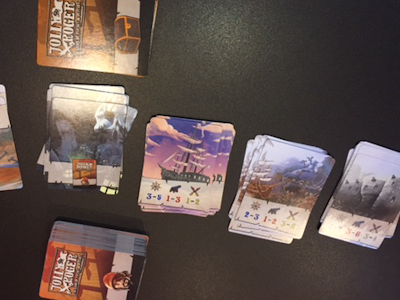 But of course for this all people on a pirate ship must cooperate, mainly because we only have a limited number of cards and it are these cards that must be played to meet the requirements of the chosen target. It is the quartermasters task to organize the attack and so he must convince other players to take part in the attack and help conquering the prize by playing cards. Of course in this phase a lot of negotiating takes place, because a player who has played more and stronger cards expects more of the prize, if the attack was a success. But it is only after the revealing of the card that we know for sure. So there is also a lot of speculation, because on the other hand it is not wise to play too many cards, because that weakens a player for the later phases. If however the attack was a success, the captain takes the prize (in form of a number of prize cards as indicated on the conquered card) chooses one of the cards and hands the rest of the cards over to the quartermaster who distributes them among all other players as he wants. So you see that the captain and the quartermaster work closely. This cooperation might work some rounds, but sometime the other players will mutter their discontent and sooner or later it will come to a mutiny in which the captain can be confirmed or unseated. Each player may play from his crew cards for or against the captain. The losers of the mutiny loose all of their prize cards (if not buried in treasure island), truly a hard penalty. 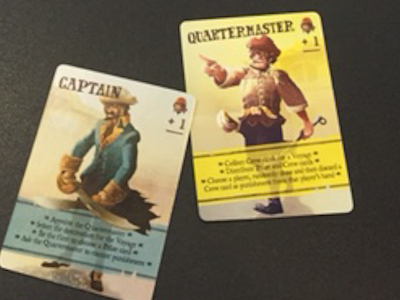 The game was quite easy to learn and I especially liked the negotiations and bribes (of course promises do not have to be respected in Jolly Roger) that were really very funny and entertaining in my testing group. Some elements reminded me of Junta like the distribution of the prize cards, the role of captain and quartermaster and the possibility of storing your treasures in a safe harbour. But Jolly Roger is much more simple, especially the mutiny is not comparable with the tactical battles of Junta. So it seems to be particularly suitable for larger groups. Special crew cards can alter some of the rules, make the game less predictable and seem to further increase the re-playability. So that is a game I will try in my larger game groups in the next months. Leaving the booth of ARES I, for the first time today, had time for drawing breath. But only soon after my wife called and told me to take over the kids, so that she could stroll. That of course changed my type of games enormously and I soon saw myself confronted with building houses of toy blocks, forming kinetic sand and other things like that. We also did try some of the children games, but I had plan to write about these games a little bit for Saturday and Sunday, so I will come back to this the other days. In comparison to last year I had the feeling that the convention halls were slightly less populated. Maybe this is the result of the additional hall 7 that I up to now have not even entered. Larp seems to decrease, too, so in passing I only saw few of the familiar equipment booths. ![[SPIEL]](ess15097.jpg) Review: Heroes (Lion Games, Booth 2-B110 / Rebel.pl, Booth 1-G141)
When I had left the booth of HISTORICAL GAMES FACTORY last year I left with mixed feelings. On the one hand I had just tried the interesting historical game (First to Fight) with comparable elements of one my most favourite games ever (Puerto Rico). On the other hand I had hoped to have a sneak preview of a game, that was promoted some time before, but had not managed it to SPIEL 2014. This game was Heroes. Now, one year later, it is presented by LION GAMES, a new brand of HISTORICAL GAMES FACTORY, because it is a fantasy game with heroes, creatures like dragon and magic. So it cannot have a historical background of course, but that is one of the significant features of the Polish publisher. LION GAMES did not do all the work alone, but looked for a bigger distributor. The result is that REBEL.PL, one of the established Polish publishers further developed the game and is now exclusively distributing the game. OK, so I sat down and began listening. First shock: Heroes is a real-time game. So how can I have a chance against the marketing chief of LION GAMES, a guy, who surely must have played the games a hundred times already. Not that you have a chance against these guys at a convention anyway, even if it is not a real-time game. They damn well know the game. They are the producers and you are playing the game for first time. But at least they make it look like you are also good, sometimes they even let you win (probably that is just a trick of marketing, you are feeling good, so you will buy...). But how can this work in a real-time game? OK, if it would at least be a cooperative game. But Heroes is bloody competitive. Its objective is to kill all other players, so you will be the last hero in play. I was curious... We started with preselected decks, but Piotr told me, that the real game begins with choosing starting spells and a hero as a starter deck (interestingly you may chose spells before you chose a hero in this clockwise starting phase). Also we had pre-defined starting armies, while in the advanced alternative you choose creatures for your army from a set of cards, geared to the needs of your hero. The battle ground on each of the player boards consists of two rows (front- and back-line) and four spaces each. Piotr rubbed my nose in the fact that it would be no good idea to send a hero to the front-line, because he would be exposed to nearly every spell of the opponent's creatures. So that is why he was placed in the second row and had some mighty creatures (at least I hoped so) in front of him as a protection. 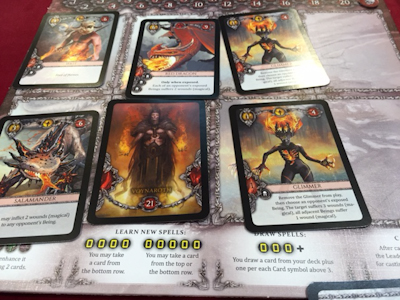 Then the nightmare began. At a command all players began rolling their own set of six dice simultaneously. Re-rolls are allowed until one of the players thinks his result is good enough and stops this process. With his result he then may take an action. But, pride becomes before a fall, first of all it is checked, if he must suffer wounds, because every hero has weak point, too. Whenever a symbol of the hero's weakness is rolled, he must suffer a wound. Luckily enough this only counts if you have stopped the game, otherwise I would have been nearly dead after my first round. Luckily enough also, that we played without this handicap of the heroes. Depending on the symbols of the dice, the player who stopped the game may then choose between casting spells from his hand that can also further be enhanced, that additionally enables him to order his creatures to attack (each creature has given way to attack), use special abilities of the creatures or move the beings to other places. The last action is quite important, because of the different ways creatures can attack. So you can block your hero by looking at the attacking ways of your opponent's creature and move your own beings as obstacles in this way. Finally there is also the possibility of randomly drawing new spell cards, learn spells from an outlay or dispel permanent spells by your opponents.  OK, Piotr was merciful and played quit slowly. Still I needed some time before I first cried stop myself (and believe me, it was not exactly what I would call a good result). But nevertheless the game let you take apart and I even had the feeling that I could win. The reason is, that - after the player who stopped the game has taken his action - all other player can take an action with their current roll-results, too. If they do not like it, they can pass and start the next round with their old results, so it is much easier to get a really good dice roll-result next round. Let us set aside my game result (I won, but - see above - I think, that Piotr let me win (although I am not absolutely sure about it)), I fell in love with the game from the first moment. Great fantasy graphics, that will thrill every RPG-player, an easy access to the rules and the game itself and a clever combination of approved game mechanics seem to form a very interesting, entertaining fantasy game. At the moment I would say that the different special abilities of the creatures and the amount of different spells will ensure many new games without replications. For my first try-out I was totally content with the two-player variant, but Heroes can also be played by 3 or 4 players and with other game variants. I would guess that this further increases the time factor in the first phase of the game, but maybe it even becomes easier, because the task to beat the fastest player is spread on many shoulders then. We will look at this detail in my final review, another time. Only one think you need: you must like dice games and games dependent from luck.. So, again I played some very promising games today. Either I was blinded by the pretty illustrations or my pre-selection was in fact very good this year. Of course I saw a lot of different type of games, so not every game will be for everyone. But there are more games to come, so stay tuned until tomorrow. |
After the lunchbreak I headed for the booth of IELLO in Hall 3 where I had arranged for a meeting with Matthieu in order to receive an overview of their new games. Matthieu took me into the press room inside the booth, and it was quite astonishing to see how many new products IELLO actually has been preparing over the last few months.
![[SPIEL]](ess15084.jpg)
One of the things new to me was the fact that IELLO actually is releasing a whole new series of micro games. Matthieu could show me a total of six gameboxes, among them a rather cute looking dungeoncrawler named Welcome to the Dungeon.
![[SPIEL]](ess15085.jpg)
![[SPIEL]](ess15086.jpg)
Played over a duration of several rounds, each round the players have to feed a dungeon with monster cards in order to put up a challenge for the hero chosen to enter the dungeon during this round. In a push-your-luck fashion, the players either have to add more cards, remove some equipment of the hero or declare that they will enter the dungeon, and then the monster cards sponsored by everybody will be revealed in stepwise fashion. If the hero survives the onslaught with the help of his remaining equipment, the player who declared to enter the dungeon will receive a Victory Point, and the player who first has gathered two Victory points will have won the game. The whole playing concept sounded rather easy going, and as it seems it had been taken up quite well by the visitor of the SPIEL, since all German copies available by HEIDELBERGER sold out today.
![[SPIEL]](ess15087.jpg)
Matthieu also could give me an overview on IELLO's schedule of upcoming games for spring next year, and among the different new games I found the rather intriguing announcement of Bunny Kingdom, a new game by Richard Garfield which unites both drafting an conquering in a coney-rules world.
![[SPIEL]](ess15088.jpg)
![[SPIEL]](ess15089.jpg)
After this tour through the vaults of IELLO, my adventurous spirit was quite high, and so I waited on the IELLO booth until I got an opportunity to sit down on one of the tables to check out a game I have been anticipating quite eagerly.
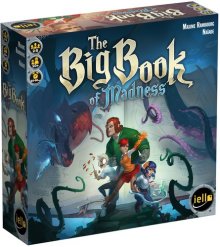
A group of aspiring magicians rummaging through the basement of their college, opening a dark tome named "The Big Book of Madness" and by doing so triggering a flood a monsters which must be defeated in order to save the world? No, I am not talking about Harry Potter and his friends, and the college does not even bear the name Hogwards, but nonetheless designer Maxine Rambourg must have been inspired by J.K. Rowling's heroes when she started designing her game The Big Book of Madness. Released by IELLO and lavishly illustrated by Naiade, today's most wanted artist, the game takes the players onto a cooperative adventure to defeat the monsters escaping the ancient tome, and to accomplish this task the player characters have to master the arcane elements water, fire, earth and air…
The Big Book of Madness runs on a simple but effective deck building mechanism, with each player managing his own character's deck. Since every character belongs to a different arcane field of study, the starting decks of each character slightly differ concerning the frequency of cards of each of the four elements. At the beginning of the game the player decks are mainly made up of value "1" Element cards, but during the course of the game the players also may spend cards from their deck to purchase Element cards with values "2" and "3", effectively increasing the power of their hand which is always restricted to a maximum of 6 cards. However, in the curse of the game the player decks will get polluted by Madness cards, generic cards without any function which must be added to the discard pile whenever a player's drawing pile is exhausted. These cards clog up the efficiency of the player decks and, even worse, a player who is unlucky enough to draw a full hand of 6 Madness cards will be considered to be gone insane and is out of the game.
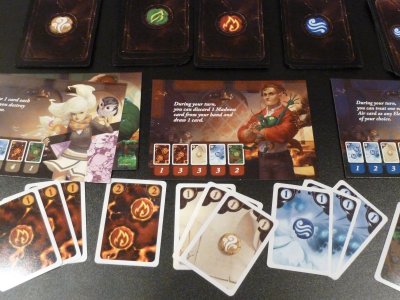
The Element cards on the players' hands will be used to power spells. At the beginning of the game each player is assigned an identical set of four beginner spells, and these spells offer some basic functions like drawing an additional card, destroying a hand card (possibly a Madness card) or allowing another player to perform an action out of turn. However, there also exists an open display of 4 spell decks belonging to the 4 elementary schools, and the players also can use Element cards from their hands to purchase new, more powerful spells from these decks, replacing some of their older spells when they have reached a total of 5 available spells. As indicated, the spells which can be bought during the game are far more powerful, allowing combinations of the basic actions and positive effects for other player characters. In addition, the spells usually have a variable efficiency, allowing a player to overpay the Elements needed to cast a spell by two or even three times. If such an overpayment is made, the spell's effect is doubled or tripled, and this allows the players to make some quite interesting decisions when enhancing their character decks with new Element cards.
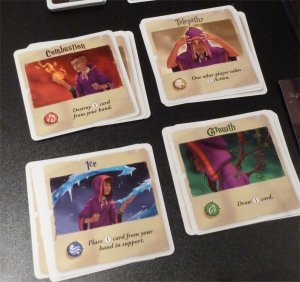
But what about the ole Big Book and the freaky monsters? Well, during setup the Big Book has been prepared as a stack by randomly assigning a cover card, five inner pages and a backside card, and during the first round of play the cover will be lifted and placed left of the rest of the book, thus revealing a new monster on the backside of the cover and some effects associated with winning or loosing combat against this monster. In effect, the Big Book is constructed similar to the books found in Valdora, since during the course of the game the pages of the book will be flipped one by one, and the contents of each double page will be similar to the first double page, always showing a monster and the rewards/detriments for winning or loosing against this monster. Due to the double pages, the game is far less repetitive, since each game will see the players facing different combinations of monsters and effects.
Each of the monsters will bring along a number of Curse cards which is depicted on the Monster card, and these Curses will be placed on a five-stepped circular track found on the main gameboard. During each player's turn an Invocation marker will be moved one step forwards on this track, and whenever the Invocation marker reaches a new Curse card the card will be triggered, resulting in some negative effects for the players (loosing hand cards etc.). The players on the other hand try to destroy the curses by discarding a combination of Element cards listed on the individual Curse card, and the removal of the curses is not only necessary to avoid their negative effects, but also to defeat the current monster, since each monster only stays for a total of 5 player turns. After 5 turns the round is over, and if the players have not succeeded in removing all Curse cards brought by the monster the negative effect shown of the right page of the Big Book will be triggered. If, on the other hand, all Curses were removed, the monster was banished and the players will receive a benefit.
Regardless of the fact whether the players or the monster were able to win the round, the next page in the Big Book now will be turned over, revealing a new monster and its curses. The game continues in this fashion until the sixth and final monster arrives. At this point there will be no backing down, since the sixth monster is the Overlord which the players must overcome at all cost since the defeat of the Overlord decides whether the players win or lose the game. Now it will show whether the players have played effectively, acquiring stronger spells and increasing the efficiency of their individual decks, or if they have tarried, being defeated by the previous monsters and collecting destructive Madness cards.

Apart from the interesting powering up of the Spell cards which gives the players a slightly advanced deckbuilding challenge, The Big Book of Madness also features a nice mechanism which results in increased player interaction. There exists a choice of spells in the game which allows the players to place up to three of their hand cards into a common Support Pool. Apart from the fact that cards placed in support will remain there until they are used (not counting against a player's hand limit), the Support Pool is open to all players, allowing them to draw on the cards placed their by their fellow magicians. This opens up a number of options unknown to competitive deckbuilding games like Thunderstone or Dominion, since the players now actually have the possibility to combine their forces to remove an especially nasty curse, or to heal Madness cards placed into support by another player. This also must be seen in consideration which the spells available to each player, since the Support Pool allows for a higher degree of specialization, allowing some players to play more aggressively whereas others might build up efficient healing capacities.
It is exactly this high level of player interaction which gives The Big Book of Madness a special charm, since the players effectively are given an additional strategic level which they can discuss. Due to this the cooperative approach as presented in the game feels more "complete" than in other, quite individualistic wannabe cooperative games. In such games it usually will be appreciated if the alpha-player takes a breather, but in The Big Book of Madness monster effects which force the players to remain silent really will feel like punishment.
So, let's give a warm welcome for Maxine Rambourg for a great debut game!
![[SPIEL]](ess15090.jpg)
For the afternoon I had scheduled one more meeting with yet another French publisher, and so I stayed in Hall 3 and went over to the booth of MATAGOT where I was set to meet Fabien later on for a tour through their new games. Once again I was early, and so I could marvel once again at the rather well-done super-size versions of some of the MATAGOT games.
![[SPIEL]](ess15091.jpg)
![[SPIEL]](ess15092.jpg)
I was quite lucky to get a free seat on a table which was about to embark on a game of Barony, and since I had read the rules I could join the game without further delay.
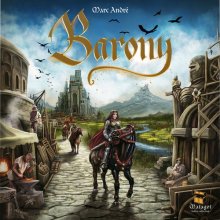
Over the last few years MATAGOT has presented several magnificently equipped boardgames which give the players a quite stunning impression when they have been set up on the gaming table. Games like Giants, Takenoko, Cyclades or Kemet come with beautiful playing pieces, and together with the nicely illustrated gameboards such games have become a trademark for MATAGOT's line of products.
In this company the new MATAGOT game Barony by Marc André stands out, since the game features an assortment of wooden playing pieces, and also the modular gameboard is different than the big, illustrated boards found in other MATAGOT games. Mind you, the wooden knights, villages and cities which can be found in Barony are quite nice and big when compared to the wooden components of other boardgames, but nonetheless the whole appearance of the game seemed a bit "traditional" if compared to many other games of this year.
However, a more traditional look does not always imply that the game itself is outmoded, and indeed Barony can score with a quite straightforward but nonetheless challenging set of rules. The game indeed deals with the traditional thematic background of medieval combat and conquest, but quite interestingly it turned out to be a purely tactical challenge with no factor of luck.
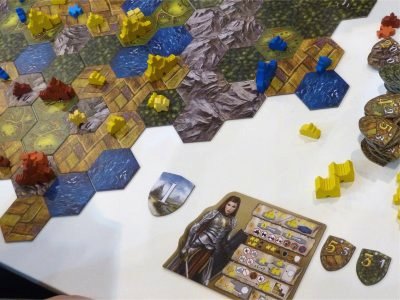
When the modular gameboard has been set up in a random fashion, each of the players is allowed to claim three hex-spaces as starting regions, and the players will place one each of their cities and knights into each of these regions. To mitigate the advantage of the starting player, the choosing of the starting regions follows an alternating player order which makes the last player the first to place all of his cities, and if everybody choses his starting regions wisely none of the players really will gain an advantage from his starting position. With the regions chosen, the game if ready to begin, and the plain straightforwardness of the whole playing concept becomes visible when looking at the composition of a player's turn.
During his turn, a player just may perform one single action, and so the game will move forward with considerable speed since not too many things will change on the gameboard between two turns of a player. The available actions are as follows:
The game is over when a player has reached the rank of "Duke", and when the round has finished all players will add up their victory points from ranks of nobility and remaining resource tokens to see who has won the game.

Can a game be traditional and modern at the same time? When first going through the rules of Barony I was doubtful whether the game really meets up with today's expectations concerning innovative rules and mechanisms, but already the first test game really woke up my liking for more. Even though the general conquest setting reminds of early-age computer games, the incredibly high pace set by the "one action per player" rule gives the game a rather unexpected addictiveness. Players with a liking for quick calculations and a good eye for tactical advantages certainly will perform quite well in a game of Barony, but especially in games with 3 or 4 players there will be some shifts in leadership since temporal alliances may form to show the leader his limits. This is more difficult in the two-player game since a player who has gained an edge over his only opponent is quite hard to catch up with.
However, irrespective of playing with a cast of two, three or four players, Barony is a game dominated by a player's ability to see tactical opportunities to gain valuable resource tokens which can be turned in for ranks of nobility. Apart from the position of a player's knights on the gameboard, there is also a high dependence on timing since a player must hold onto his resource tokens (i.e. not lose any villages) until they can be turned in.
If both timing and tactics are one of your favourite features of a good boardgame, you should go for Barony since it is a well-designed representative of modern strategy games!
After my game of Barony Fabien invited me to come inside and we actually had enough time to play a game, our first game ever after all those meetings here at the show. The game we chose was Raptor, a two-player game whose setting reminded me of Arthur Conan Doyle's novel The Lost World, and even though the game's authors Bruno Cathala and Bruno Faidutti chose to let Jules Verne's Professor Lindenbrock explain the setting, it could well have been Doyle's Professor Challenger who is leading the hunt for a lost species on this isolated island.
![[SPIEL]](ess15098.jpg)
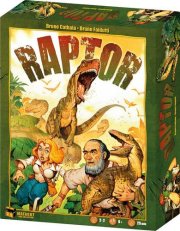
Both the setting and the rules can be grasped within a couple of minutes, and so the two players take the different sides in a savage struggle. On the one hand we have a full-size Velociraptor with her 5 Baby Raptors, and on the other side stands a team of 10 scientists who want to capture either the Mother-Raptor or three of her babies. I can already predict at this point that my wife Nicole always will play Mother Raptor, since she will not forgive those scientists their hunt for these "poor" baby raptors…
Anyhow, back to the game. Mother Raptor tries to help at least three of her babies to escape from the gameboard, and alternatively she tries to free the whole board from scientists since this is the second possibility for a Raptor victory. The game begins with all raptors and 4 scientists on the gameboard, but up to 6 more scientists can be brought into the game in order to intensify the hunt.
Each player possesses a deck of 9 cards, with each of the cards being numbered from "1" to "9" and also listing a special action. The players have a random hand of three of these cards, and the decks will be reshuffled if a player's draw pile ever runs out. During a round of play, both players simultaneously chose one of their cards, and the first thing they do when revealing their cards is a comparison of the cards' numbers. If both players should have chosen the same number, nothing will happen, but if they went for different numbers it will be the player with the lower numbered card who is allowed to perform the card's special action, whereas the player with the higher numbered card will not perform his card's special action, but instead he gets a number of action points equal to the difference of the values of both cards.
Depending on the side, the players can spend their action points for a number of actions. The scientists can move from one space to the next, they can put Baby Raptors on neighbouring spaces to sleep, they can capture a sleeping Baby Raptor, or they can even shoot Mother Raptor, resulting in the Raptor player taking one of five Sleep tokens which are necessary to put her down. Mother Raptor on the other side can move much quicker since she can move as far as she wants in a straight line, and she does not bother putting someone to sleep. If she stands next to a Scientist, she will simply kill him in order to save her offsprings.
Quite interesting is the choice of options available to the players on their playing cards. So, the scientists actually can make long movements using jeeps, they can use sleeping gas and they can even set a blaze, hindering the Raptors on their movement and forcing Mother raptor to spend action points to extinguish the fire. The Raptor player on the other hand can frighten Scientists into paralysis, call the Baby Raptors onto the same tile as their mother, or hide Mother raptor in the undergrowth, making her reappear at a different place.
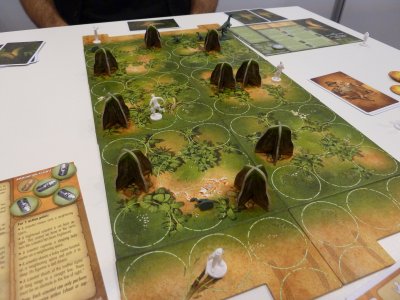
The game builds up tension right from the beginning, and after the first two or three rounds of cardplay the players are in the middle of a rather challenging duel with different possible actions on both sides. Since the cards used by each player in previous rounds remain openly on the table, there is a possibility to make some preditions which cards the other player might use next, and due to this strategic element Raptor is not really a luck-dominated game, despite the fact that the new Action cards are drawn at random.
Dense and full of action, Raptor is one of those games which can be learned by doing, and due to the different abilities of both sides the players will need to develop different strategies to have success in the game. The scientist player will try to delay the escape of the babies in order to get more scientists onto the board, whereas Mother Raptor usually is out for a lunch, trying to get one of these tasty scientists whenever possible, but disappearing in crucial moments just when the scientist player thinks he has set up a perfect trap.
by the way, this time my expedition was successful, and they will return home with a nice freight of three caged Baby Raptors.
![[SPIEL]](ess15099.jpg)
With my writing powers waning, let me tell you quickly of my last meeting today. At the CGE booth in Hall 3 I was met by Jana from the CGE team, and she gave me a rather quick tour of some of the new CGE games. Being a seasoned Galaxy Trucker, quite interesting for me was the new Galaxy Trucker Missions Expansion. Inspired by the Galaxy Trucker app, the players now can take a different mission card for each flight. On these mission cards you will find an assortment of the eccentric characters which the player meets in the app, and to allow a greater variety of missions the box also contains a good number of new spaceship parts, allowing each flight in the game to become a quite unique experience. This sounds like it is definitely a "must buy" for all fans of Galaxy Trucker.
![[SPIEL]](ess15100.jpg)
Apart from the new Nethervoid expansion for Tash-Kalar, Jana and I also inspected the new edition of Through the Ages. This second edition keeps the rules of the first edition, but it has been changed on a number of other factors, beginning with a major overhaul of the grafiks but also including some of the more fiddly parts of the game. So, the taking of Corruption now has been streamlined and put at the beginning of each player's turn, and in addition many of the cards had been tweaked on the basis of the statistics gained from hundreds of online games. It sounded like the game had been developed a bit further, and if you ever contemplated getting a copy of Through the Ages you should make sure to get the new edition.
![[SPIEL]](ess15101.jpg)
![[SPIEL]](ess15102.jpg)
But that's it - I am done for today! Greetings from me and Ping!!!!
![[SPIEL]](ess15103.jpg)
Ha, I have survived the second public day, so here we go once more: SPIEL '15 - Day 2.
Last night actually has been a horror for me. In the middle of the updloading process I got a total shutdown of my computer system, after getting a message that my webeditor has run out of resources. I have spent some quite frightened minutes during the reboot procedure, burt in the end all backups have worked and I could continue. However, this has cut 2 hours out of my sleepting time, since I couldn't quite find rest after the shock. Computers….
But anyway, you are here to hear about games and not about computers, and so let's jump right into my first meeting of the day. Remember that I told you yesterday that I had scheduled another meeting with Vangelis Bagiatakis from Greece? Well, today I went to meet him at the booth of DESYLLAS GAMES, a Greek publisher which is attending the SPIEL for the first time.
![[SPIEL]](ess15104.jpg)
The biggest game they are presenting at the SPIEL is another of Vangelis' designs, but instead of building a city this one deals with the hardships of pirate life, so let me tell you about Oath of the Brotherhood.
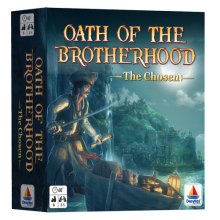
Inside the gamebox which is decorated by a Pirate looking suspiciously similar to Jack Sparrow (hey, that's CAPTAIN Jack Sparrow - sorry) you will not not a worker but a Pirate placement game. When I had studied the rules ahead of the SPIEl , I couldn't quite make up my mind what I should make of the game. Should I expect another relatively straightforward worker placement game, with the players just competing for resource spaces, using the resources later for fulfilling tasks assigned by the Pirate Brotherhood? Or are the different kinds of abilities available to the player's Captains, the quite interesting transition between resources and these abilities, and the possibility to discover new action locations actually hints at a game leaving the usual path? Well, all this had made me curious, and soon after starting our demo game I had to confess that the game and its considerable pace had captured my full attention.
As indicated, the players need to fulfil mission which they can get from the Brotherhood, and these missions usually consists of a combination of the three general types of resources (Equipment, Allies and Supplies) which must be delievered by the players to the Brotherhood building. Small amounts of these resourecs can be collected by the players at different locations on the board, and they can also be purchased at one location, the Black Market.
For acting on the board, each player has a figure for his Captain, and another 2 to 3 figures (depending on the number of players) representing his Mates. During a round, the players take turns to send their figures to free action spaces at the different locations, trying to interact with the places in order to gain resources etc.
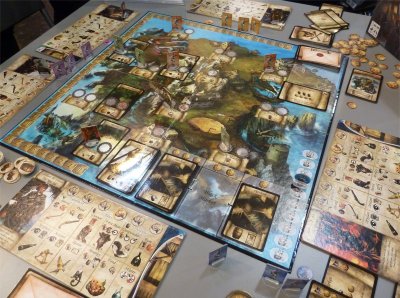
Whenever a player gains a resource, he has to place it on his player board, and that's the moment when things get interesting. Each kind of resources can be stored for up to five time's on a player's board, but onto one possibility to store a resource is a typical storage bay. The other four possibilities actually are four different kinds of improvements which correspond to the type of resource the player wants to store, and so a player can chose which type of improvement he wants to activate by placing the resource on the corresponding spot. E.g., if a player gains an equipment resource, he can place it onto a space depicting a Cutlass, a Pistol, a Spyglass or a Sextant, and as long as the resource is stored there the player will get the associated benefit. However, the Brotherhood missions usually require the delivery of more than one resource token per kind, and so the players often have to let some of their improvements go in order to fulfil a mission.
The improvements or special abilities which the players can gain through the resources are quite variable, ranging from an extra movement of the Captain to the opening of an additional action space on an otherwise occupied location. Other pieces of equipment actually deal with the fact that a player coming to a location already occupied by another player's figure actually has to loose a Toughness point, and so the Cutlass can be used to prevent this loss, whereas a Pistol allows the player who has arrived earlier to decide whether the newcomer looses a Toughness point or has to pay 1 Doubloon. Quite interesting is also the use of a keg of Gunpowder, effectively emptying all Action spaces in an occupied location.
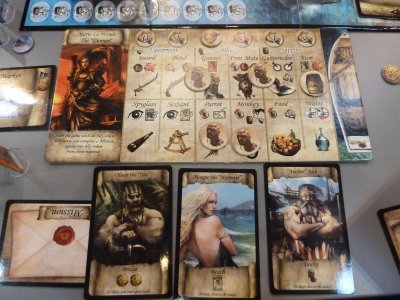
Apart from the board spaces dealing with the basic resources-to-missions "production chain", other locations give the players the possibility to gain additional Action cards or followers, piratish personalities which often give the players an advantage when dealing with a specific location. Especially the Action cards are really interesting, since they offer a wide range of one-time special effects, and they can also be combined to allow really interesting combinations of movement and actions. If combined with special abilities provided by resources, rather cool combos can be played, greatly enlarging the normal scope of one action per turn.
I remember surprising Vangelis with one of those combos of two Action cards and a piece of equipment shortly before the game was over, overtaking him at the last possible moment and snatching victory from his hands. As you can see, our initial demo session actually had turned into a full game, and this was mostly because of the fact that the high pace of the game and the always rather close rankings kept me right fixed to my seat.
Quite surprisingly, even locations like the Watchtower which allows the discovery of new locations are used quite frequently during the game. Before we started I asked Vangelis whether this location was that useful in a 2-player game, since the standard locations offer more than enough Action slots for two players. However, the Watchtower is also connected with the otherwise fixed role of first player, and so both of us frequented the Tower more than once to gain the advantage of playing first in the following round. As a windfall effect, the visit to the Watchtower also triggered the appearance of new locations, and these offer a quite interesting choice of actions on their own, often connected with the spending and gaining of resources in different combinations.
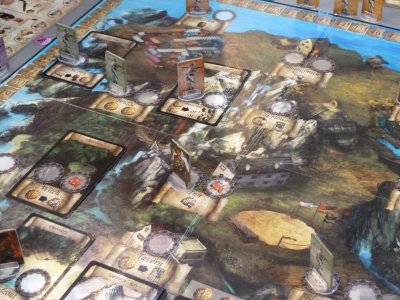
To keep the game from getting too streamlined, both the Location and the follower deck usually will not be fully used up in a game of Oath of the Brotherhood, and so the players always have to adjust themselves to the different opportunities found in the game.
As you might notice by my choice of words, the game certainly has surprised me as being much more entertaining than I suspected after reading the rules. Of course I knew that Vangelis always comes up with some nice design ideas, but the way he combined some known mechanisms into the well-working design of Oath of the Brotherhood is really remarkable.
![[SPIEL]](ess15105.jpg)
On a sidenote, it's actually quite funny that this morning here at the SPIEL was not my first contact with Oath of the Brotherhood. During our summer holidays Nicole and I visited Cretaquarium, the biggest aquarium on the isle of Greece, and in the souvenir shop I actually discovered a copy of the game. It was the Greek language edition, but I could recognize the game and so I had been curious all summer whether I would actually have a chance to see the game here at the SPIEL.
![[SPIEL]](ess15106.jpg)
![[SPIEL]](ess15107.jpg)
![[SPIEL]](ess15108.jpg)
But what's a real pirate without some loot, and so I am happy to announce that the managers of DESYLLAS GAMES actually have sponsored to of their new games for the
![[SPIEL]](ess15109.jpg)
With Crazy Bullets and OMG (Oh my Gods!) two rather cute looking games have been added to this year's stash, and all you have to do to get a chance to win a game is…
Next I returned onec more to the booth of SMOOTHIE GAMES where I had agree with Percy Chan from CRIMSON DESIGN PRODUCTION to check out his new game Magecraft. It's a game about battling wizards which is currently on Kickstarter, but Percy actually had brought a few production copies along from Hong Kong to see how the game would be received here at the show.

Two or more players can join the battle of wizardry unfolding in Magecraft, and at the beginning of the game the players set up a choice of possible Spell cards which will be available for learning during the game. Not all of the available Spell cards will be used for one game, and so the players usually will face different situations during every new game.
Each player starts the game with a set of three spells, and during his turn a player can trigger one of his spells by paying a combination of coloured gems corresponding to the requirements of the spell. Each player usually has a hand of four gems, coming from the player's bag of gems which has been filled during setup with a total of 12 gems, 3 gems of each of the basic colours. When a turn is over, the player has to discard all used and unused gems from his hand, drawing a new hand of 4 gems from his bag, and when the bag is empty all the used gems will be returned to the bag.
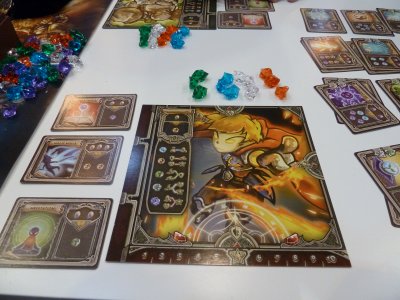
The gems available cannot only be used to cast spells, but they also can be paid for learning new spells, with each available spell from the common display costing its own specific combination of gems. In a quite crafty manner, new spells will not simply be added to the player's choice of available spells, but they must be assigned to one of the player's spell slots which were begun with the player's basic spells. From this point onwards to player can cast more than one spell during his turn since he can cast all the spells lying in the same slot, but this comes under the conditions that a newer spell always must be cast before an older one, and this fact is represented by the fact that each new Spell card partly covers an older spell. A full hand of gems actually can be spent to rearrange a player spell slots up to his liking, giving him the additional benefit to turn one of his spells to master level, effectively allowing a gem which is used to cast this spell to be carried forwards to the next spell in the same slot.
But what's the purpose of all these spells? Well, the spells can be used for gaining five different kinds of actions, and the higher the costs to learn a new spell the better the number and combination of available actions. Most straighforwards is an Attack spell, since this kind of action drains another player's Life points, effectively giving them as Victory Points to the attacker. However, a player actually may prepare against an attack by a Defensive spell, putting new gems from the common stockpile into an orb of defense which first must be overcome before an attack will drain Life Points. So, a Defensive spell does not only protect a player, but it actually gains the player new gems for his bag, including the rare violet gems which are not included at the beginning and which can be used for some advanced spells.
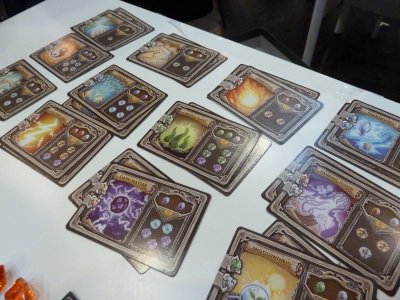
Other actions include healing, the gaining of Victory points by destroying gems and the possibility to draw additional gems during a player's turn, and due to the fact that the player's spells have been arranged into the three spell slots the players will strive to arrange their spells in well- fitting combos which allow the casting of multiple spells during the same round.
Magecraft is a rather straightforward but extremely tricky game in which the players strive to gain an advantage through better spells and by seeding their bags of gems with gems showing the required colour's to cast the acquired spells. Players do not always have to follow an outright aggressive strategy, but they also have the opportunity to concentrate on generating Victory points and putting up some defences, and much depends on a player's ability to see beneficial spell combinations in the choice of spells available in the current game.
What I really liked was the multiple ways of player interaction. Apart from the fact that each spell is available only in very small quantities, the players either can attack each other directly, or they can strive to beat the other players to gain gems of certain colour from the common stockpile for their bags. The common gem stock is limited, and so especially the violet gems needed to cast some of the complex spells are really sought after by the players.
Coming with a nice set of artwork and 5 different player characters with small special abilities, Magecraft offers a really high entertainment value especially for 2 players. With more players the game will be different since there will be a higher dependence on timing and on spreading damage among the opposing mages, but especially for 2 players the game is highly recommendable.
If this introduction has woken up your interest, you might wish to check out the Magecraft Kickstarter Page for some more detailed information.
![[SPIEL]](ess15110.jpg)
The morning had not yet passed, and so I headed over to Hall 3 to checkout some more games there. Upon entering the hall, my eyes stopped at the booth of LUDONAUTE (booth 3-S116), publisher of Colt Express. I still need to play my first game of Colt Express, but the item I saw at their booth was too cool to pass. Coming as a convention goodie, LUDONAUTE actually has created a new kind of vehicle for Colt Express, and its none less than Marty McFly's incredible DeLorean from the Back to the Future movies. I couldn't quite believe my eyes - what an incredibly fun idea. Being a fan of the movies, this was to good to pass, and so I ended up getting me a copy of the game together with this cute extra! (By the way, there is some hope: I overheard that some quantities of the DeLorean possibly might turn up in the Geekstore at BGG at a later point!)
![[SPIEL]](ess15111.jpg)
But now let's continue this morning of playtesting!
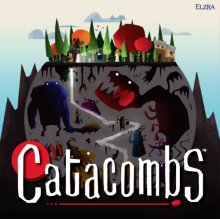
Classic fantasy games always feature a good deal of dice rolling, and so games like Talisman, The New Dungeon and many others have chosen dice rolling as the main engine for determining the outcome of almost every player action. Even role-playing games with their much broader storytelling approach refer to dice rolling when it comes to determining the outcomes of combat and skill checks, and so the many-sided cubes have become inseparably connected with fantasy gaming.
In the year 2011 Dungeon Fighter from Italian publisher CRANIO CREATIONS has enhanced the classic playing experience by hilarious, almost artistic dice-rolling variants which challenge the players to roll their dice using almost every part of their body, and even though you need to be a fan of dexterity games to enjoy this to the full extend, the Dungeon Fighter series can be commended for its new approach to a well-known thematic setting. However, quite unknown to the fantasy gaming audience due to low circulation numbers, A dungeon crawler without dice - how on earth (or below it) is this going to function?
Well, in case of Catacombs the heroes do not crawl through the dungeon, but they actually have found a more elegant way of movement - they will slide! Indeed, all heroes and monsters plus their archery missiles and spells all a represented by stickered wooden disks of varying sizes, and when the hero players start exploring a new dungeon room an assortment of monsters will be placed into the room by the Overseer player who is in charge of the Catacomb Lord's minions. Opposite to the monsters the heroes will be placed together with their familiars, and taking turns the heroes and the Overseer now will move their playing pieces by means of snipping, trying to touch opposing playing pieces in order to inflict some damage.
However, this type of a direct melee attack only is the most basic way to take action against opposing playing pieces, and so both the heroes and the denizens of the dungeon may employ their skills and equipment to shoot smaller missile and spell disks at the opposing teams. Depending on the items or abilities used, these shots may cause a wide range of effects, ranging from direct damage to stunning or freezing a creature in place. As an advantage, using such a shot means that the player can keep his character playing pieces out of melee combat, and so some members of the opposing forces will try to harass each other out of the distance as long as possible. However, as might be guessed this only is a sound tactical approach for some heroes and monsters like the Elf or a Skeleton Archer, and so other heroes/monsters like the Barbarian or a Swordmaster Ghoul will prefer to shorten the distance to their opponents, initiating melee battle to bring their better battle skills to bear.
This kind of "snipping battle" is the centerpiece of the whole playing experience offered by Catacombs, and so it's no wonder that quite a wide range of special effects and disks are at the player's disposal. To make things more interesting and to give both heroes and monsters some character traits, both heroes and monsters often do not have just a single shot for movement or other attack types, but instead they often are allowed to employ a shot sequence, made up from a combinations of movement, attack, spellcasting and archery shots. The stronger the monster (or the better the hero's equipment), the longer the shot sequence, and so a level 1 Orc with his one attack shot greatly differs from a level 3 Fire demon with its 3 Fireball shots or a level 4 Venomous Spider with two movement and two melee attack shots in just one sequence. Another special shot type are defensive shots which may be used by some characters, representing a shield attack which is aimed at pushing an attacker away. Once the shield disk has been used, it will be returned next to its owning character, offering some protection from attacking characters and incoming missiles.
Catacombs certainly is no static game where everybody remains seated around a gaming table, watching the events unfold. Instead, all players constantly move about, with the hero players discussing the best way to deal with the Overseer's monsters. Moving around the table is necessary to get the best aim and angle for moving the playing pieces, and to ensure good playability and to keep the playing pieces from flying all around the room the game also includes a barrier wall which is set up around the board. Another nice extra are some obstacle disks which are put into holes of the gameboard, making it more difficult to get a straight shot and often causing some interesting rebounds.
At the beginning of each adventurer's or Dungeon Lord's careers stands a period of learning, and as you can imaging it takes some time to get used to snipping the different sizes of disks on a comparatively small gameboard. Players need to get used to the feeling and weight of each disk, and so especially newcomers may make some quite awkward shots when they make a wrong estimation of the power needed for a certain snip. At this point is is up to the players to decide how seriously they should take the game, because some lenience will make the game much more enjoyable especially for beginners. On the other hand, player skills will progress quite fast, and so you will quickly see some fabulous shots, using obstacles and other disks to make some rather skillful actions.
Even though this snipping battle is the central element of the game, Catacombs is far more than a fantasy version of Carrom with monsters and magic. The creativity of the game's designers Ryan Amos, Marc Kelsey and Aron West becomes perceptible when you look at the way how the combat mechanism has been embedded into the whole gameplay, since Catacombs actually comes up with some other elements of a classic fantasy game. So, during setup preparations a number of room cards will be drawn by the Overseer, and these room cards are used to determine the heroes' route to the Catacombs Lord and the monsters they will have to face in each room. In addition, there are some special locations like a trader, a healer or an alehouse (all underground) which they may visit along the way, and at these locations they can spend gold which they have gathered from slaying monsters. A good choice of items, familiars, spells and skills completes the playing experience, but even though the basic rulebook has a considerable volume (23 pages) the game operates rather smoothly once the iconography has been understood by the players.
From my perspective a new release of Catacombs has been overdue for years, and now the new 3rd edition of the game does not only allow a broader audience to enjoy the game, but in addition the game also profits from a completely new set of colourful artwork which suits its light spirit much better than the darker illustrations of the previous editions. With these elements coming together, I have been quite unhappy when I discovered that I had missed the Kickstarter campaign for the 3rd edition of Catacombs, but now I am glad that the game finally is available!
This actually ended my morning round over the SPIEL, and I quickly returned home where one of Nicole's fabulous Beetroot cakes came was freshly out of the oven!
So, why not check out Ralf's report of the day while I am eating! And, if you haven't done so, you should really add his Twitter account to your list, since Ralf sends some splendid photos during the day!
Ha, Ralf has actually included the ceremony of the International Gamers Awards in his report, so I can directly continue with my next playtesting session which I embarked on after the ceremony. Being the No. 1 game on the current Geekbuzz ranking at BGG, I went to check out 7 Wonders Duel, the new 2-player spin-off game to 7 Wonders. However, I didn't get a free seat at the REPOS PRODUCTION booth, and so I went to see what new game Roman Mathar from ARGENTUM VERLAG has published for the SPIEL '15.
In these days of hundreds of new boardgames being released each year it is quite hard for small publishers to be successful because the comparatively low visibility of their games on the bloated market naturally results in few gamers noticing these games. However, there are some companies which have found a specific niche for their games, and one of these is ARGENTUM VERLAG. Over the last few years publisher Roman Mathar and his crew have released games like Yunnan, Desperados or Hansa Teutonica, and with games like these ARGENTUM SPIELE has established itself a name as a good source for strategically ambitious boardgames. So far Roman has shown a good hand in choosing games with some extraordinary mechanisms, and due to solid editing and well-chosen artwork and playing materials the games have been received quite well.
This year ARGENTUM has returned to the SPIEL Antarctica, a game about the exploitation of the Antarctic by Charles Chevallier. If you look at the gameboard after a game of Antarctica has finished, it looks like the players have covered the South Pole with some kind of crazy industrial complex. The eight areas around the pole now are filled with cranes, derricks, laboratories, dockyards, research stations, plankton farms etc, and around these buildings scurry dozens of scientists in the players' colours. As the game's story sets out, all this industrialization was aimed at improving mankind's technological progress, and the player who has performed best in the categories of scientists per area, progress on research tracks, and placement of new buildings will have won the game.
Building new buildings and placing scientists? This may lead you to the expectation that Antarctica might feature just another combination of resource management and worker placement mechanisms, but if you think back to my introductory notes about ARGENTUM VERLAG you shouldn't really be surprised that this expectation is quite wrong. Indeed, Antarctica is a game where good timing is a central element, and so the players need to have ships (their main playing pawns) in the right areas at the right time to take opportunities to set up new buildings.
At the beginning of the game each of the eight Antarctic areas just contains one of eight starting buildings, and each player has two or three of his ships docked at different areas. Each area features a harbor which can dock up to three ships, and the order in which the ships are docked will be quite important since the game proceeds with the sun moving around the gameboard, activating the Antarctic areas in counter-clockwise order. It is always the player with his ship docked in the first docking slot of the activated are who may now take a turn.
To take a turn, the active player now takes his ship and moves it to any of the other seven areas, provided the chosen area has at least one free docking slot. Once the ship has left, all other ships in the active "sun" area will move one slot forwards in docking order, whereas the active player must place his ship last in the docking order of the newly reached area. When the ship has docked at the new area, the player may perform some actions in this area, with the erection of new buildings being the most prominent action.
Buildings do not depend on resources, but instead three decks of Building cards are always available to all players, with the top card of each deck being revealed and showing which building can be built. To use a Building card and place a new building, the active player needs to have ships in areas containing all buildings which are listed as prerequisites on the chosen Building card, and when this condition can be met the player takes the card and places the new building plus a number of scientists (as listed on the card) into the area.
This may actually sound confusing, but in a nutshell the mechanism can be summarized as "have your ships at areas which contain certain buildings". If this condition is met, the player may chose and perform a fitting Building card.
Other actions available to the player depend on the availability of certain buildings in the new area, and so the player may take new scientist meeples into his stockpile of the area contains a camp or he may advance his marker on one of the research tracks if the area contains a fitting research station. The efficiency of the action depends on the number of the player's ships and scientists present in the area, and the more ships plus scientists are present the better will be the result of the action.
If a dockyard is available in the area, the player also may opt to build a new ship, thus increasing his number of playing pawns and overall his total number of actions. However, all other players will receive a compensation of one Dock card, and these cards will allow them some special one-time effects. Special effects may also be triggered by a player marker advancing on one of the research tracks, and in general these effects are quite beneficial like an additional ship movement, the recruitment of new scientists etc.
When the player has performed his action, play continues with the sun advancing one area counter-clockwise, and once again the player with his ship docking in the first docking slot will take a turn.
Over the years I have seen games like The Circlewhere a wheel-like mechanism of delayed availability of playing pieces takes a central role. However, in Antarctica the whole gameboard functions like a gigantic timer, with the players having control over the player sequence through the placement of their ships. This core element of the game is finely interwoven with the rules for placement of new buildings and scientists, and taken together these elements make for an interesting challenge in which the players vie with each other to see the best open opportunities for actions.
Quite interesting is also the end-game scoring which is triggered either by the erection of the last building or by a player placing his last scientist meeple on the gameboard. Every area and every research track is scored separately, and the player with most scientists (area) or most research progress (research track) always will score a number of victory points equal to sum of scorings reached by all players in this area/research track. This gives the leader a considerable advantage in comparison to a normal majority scoring, and players need to get used to this scoring variant since it may result in harder battles for certain areas.
With these elements keeping the player's minds, Charles Chevallier rightly has decided on limiting the number of available Building cards in order to keep the game from getting too complex. As a result, the players are confronted with a manageable amount of available actions, and so they can focus quite well on the game's core mechanisms.
To my mind Antarctica blends in quite well with ARGENTUM's portfolio of strategically challenging boardgames. The unusual combination of player order and actions gives the game a solid tactical emphasis, and together with other unusual games like Ginkgopolis it can stand its ground as a building game with a certain twist!
With still no luck at REPOS I made a quick pitstop at the Press loungy of PEGASUS SPIELE, checking out some of their interesting looking new titles, and after some refreshements I once again left for REPOS to see if I was lucky now!
Indeed my luck has turned, and having read the rules I was able to start a game with one of REPOS's staff members right away!
Have you ever tried playing 7 Wonders with just 2 players? Well, the rules state that the official 2-player variant is kind of a specialist game, and indeed the gameplay is unusual in so far as the setup for 3 players is used, with the third city (Wonder) being under control of a dummy player which is played by both players in alternating order. In effect, the dummy city of often used to remove cards from the game which would be useful for the other player, and while this variant certainly works (my wife and I have played it several dozen times) Nicole and I were more than just curious when we heard about the official 2-player game 7 Wonders Duel being under development.
In reference to the game's mechanics, many major features of 7 Wonders can be found in 7 Wonders Duel as well. The game is played over three ages, players need to collect different resources which enable them to build new buildings and Wonders, and even free construction is possible, linking new buildings to their older counterparts. However, the differences between both games quickly become visible during setup, since the traditional drafting process for the Building cards now has been replaced by a partly open, partly face-down display from which the players can chose their cards. A new display of Building cards is prepared at the beginning of each age, and during his turn a player is allowed to chose one of the available cards from the display. Since some cards are covered by others, the former only can be chosen if the latter already have been taken, and in addition the face-down cards also will be revealed only if the card(s) covering them have been taken.
Already this simple but effective replacement of the standard 7 Wonders drafting process has been brilliantly implemented. Due to the Building cards being arranged as a display on the table, the players feel a much deeper strategic impact since they now have constant information on many of the still available cards. Now the players actually can try to plan for getting the one or other card important for their overall strategy, and this approach is much more coherent than letting cards disappear in a dummy city. At first I was afraid that the removal of the drafting process would change the spirit of the game, but playtesting quickly revealed that this new mechanism feels almost natural and fits the 2-player game perfectly.
But let's now continue with the name-giving Wonders, since their handling also has changed quite dramatically. Instead of each player building just one Wonder, the players now draft a total of 4 Wonders each at the beginning of the game. Each of the four Wonders available to a player is a one-stage wonder, and it is up to the players to decide in which order they want to build their Wonders. Apart from some Victory Points, the Wonders provide a broad choice of in-game effects, and so the players gain access to special powers and benefits in a fashion similar to the recruiting of a Leader as known from the 7 Wonders Leaders expansion. However, there is one limit: once a player has finished building his 4th and last Wonder, the other player only is allowed to finish 3 Wonders. After all, it's 7 Wonders!
Trading for resources and discarding Building cards also has seen a major redesign. A player now can buy any resource he desires from the bank, but instead of paying a fixed amount the sum he has to pay is calculated on the basis of 2 Gold plus the total of the desired resource symbols available to the opposing player. So, if a player wants to buy a Stone and his opponent already has 2 Stone producing buildings in his city, the player has to pay 4 Gold to the bank to buy the Stone. This is a quite interesting new approach, preventing a player from being denied access to a specific resource, and at the same time introducing a rather pricey way to simulate a monopoly established by the opposing player.
When it comes to discarding cards to gain money, the role of yellow Commercial buildings has been enhanced quite dramatically. Apart from their standard functions, each yellow building present in a player's city increases the basic gain of 2 Gold for discarding a Building card by another Gold, and so multiple Commercial buildings now can produce huge monetary gains for a player who is in need of funding.
The range of available Science symbols on green Scientific buildings has been increased from 3 to 7, and this increase also is accompanied by a major rules change. Instead of the game end multiplication which always has caused some raised eyebrows when explaning 7 Wonders to a newcomer, the players now strive to collect green buildings featuring a total of 6 different Science symbols. A player who has succeeded in gaining 6 different symbols will have gained Scientific Supremacy and will be declared the instant winner of the game. However, collecting identical Scientific symbols also is beneficial, since a player who has acquired a matching pair of symbols now is allowed to take one of 5 Progress tokens which have been prepared during setup. Just like a finished Wonder, the Progress tokens give the players access to minor special abilities or effects, and in this fashion they are a nice representative of technological advances made by the players.
If the game is not ended by a player gaining Scientific Supremacy, there are two other ways to end. One is the traditional Civil Victory with both players counting their total Victory Points at the end of the third age, but there is also a possibility to win the game earlier by Military Supremacy, thus gaining total military domination of the other player. This victory condition is measured on a central gameboard which displays the balance of power between the cities of the two players. At the beginning of the game a marker for Military Prowess is placed in the middle of the track between the cities, but each time a player acquires a Building card, a Wonder or a Progress token displaying military strength the marker will be adjusted accordingly. The farther the marker is moved towards a player's city, the more Victory Points the other player will earn at the game's end, and in addition the player under siege also may have to face some monetary losses due to plundering. However, if the marker actually reaches a player's city, that player will be instantly defeated and loses the game.
Just like the new display for Building cards, the new rules for dealing with military aspects fit the game stunningly well. While a victory by shifting power levels certainly is not new in two-player games, the inclusion of this mechanism in 7 Wonders Duel fits the game much better than simply assigning Victory Points for military domination at the end of each age. In its simplicity and elegance, the new board which represents the balance of power between the two players is an ingenious innovation which increases the feeling of head-to-head confrontation in 7 Wonders Duel.
Along the course of this review you might have noticed some rather positive expressions which I have used to describe certain game elements. Those of you who have been following my reports and reviews for some years will know that I have no tendency towards exaggeration, but from my perspective 7 Wonders Duel really fulfills all benchmarks of a perfect game. Taking all well-fitting elements of 7 Wonders and enriching them by strategic and functional mechanisms specifically designed for a 2-player setting, Antoine Bauza and Bruno Cathala have created a game which feels simply right in every aspect. Beginning with the level of strategy and the possibilities for advance planning, 7 Wonders Duelalso comes up with multiple victory conditions, scientific development, perceptible competition and a moderate playing duration. Honestly, I have problems to come up with a single 2-player game which has succeeded in bringing together so many good features in a similar fashion, and so 7 Wonders Duel really is nothing short of a stroke of genius!
My timing this afternoon was quite perfect, since I could stay in Hall 3 and make my way over to the booth of LAUTAPELIT.FI. Tomorrow I have an appointment for a demo session of the new M.U.L.E. game with its designer, but today I was meeting with Rustan Hakansson, co-designer of Nations and designer of my last year's convention hit Nations - The Dice Game. We didn't playtest anything, but Rustan showed me the prototype of a new expansion for Nations - The Dice Game which will be released probably in spring next year. Seeverl new elements will be included into the game, and from Rustan's explanations I got the impression that the game will put on some strategic depth while at the same time not getting overly complicated and losing its tremendous momentum. One of the new elements is a new early ending reward for the first player to pass each round, but a good load of other elements will be included as well, with new Nation boards and Development tiles among them.
We also talked about the Nations boardgame, and here Rustand gave me an overview of the new Nations Dynasties expansion which also includes some new types of cards and Nation boards. The namegiving dynasties are special cards for each nation which can be used twice during the game to replace the special ability of a nation, and other new elements include Natural Wonders which take time to be explored, cannot be covered and sometimes even take up two card slots instead of one. Finally, Rustan also gave me an outlook on the future of Nations, and he told me that another expansion set was scheduled for release in fall next year.
This brings me to my final playtesting report for today, and so I headed once again for Hall 7 where I was scheduled to finally get a look at Guns & Steel from MOAIDEAS GAME DESIGN in Taiwan.
Last year I presented you a review about League of Hackers, an interesting cardgame about computer hackers battling each other in a virtual reality arena. The game was presented by Taiwanese publisher MOAIDEAS GAME DESIGN, and this year they are back at the SPIEL with Guns & Steel, a small civilization cardgame for 2 to 4 players. David from MOAIDEAS had contacted my wife Nicole during the summer, asking her to do a German translation of the rules which now will be used here at the SPIEL, and so I was really looking forwards to the convention because it was my first opportunity to play the game.
In contrast to many other civilization-type games, Guns & Steel is a pure cardgame, and with 45 Civilization and 10 Wonder cards even the total number of cards is relatively small. At the beginning of the game each player receives an identical hand of 5 starting cards, ranging from some basic cards for resource trading to comparatively weak Military and Tactics cards. During each turn, a player will be allowed to play two cards from his hand, one of them face down to represent a resource, and the other face up to trigger the effect printed on the card. So, Guns & Steel uses cards both for their effect and for the payment of effects or acquiring new cards, but when Resource cards are used to pay they will not be discarded (like in Race for the Galaxy), but instead such a Resource card is simply turned face up without triggering the card effect. This way a player slowly uses up the cards from his hand, and only when he is down to 0 or 1 card he will be allowed to take all of his face-up cards and any of his face-down (resource) cards back to his hand, giving him once again a broader choice of cards.
During setup the 25 Civilization cards which can be purchased during the game have been arranged in a "Tech Pyramid", with the inferior cards at the bottom and the advanced cards at the top levels. Each level of this pyramid also represents an age, and so the cards from each level have different resource symbols at their back, starting with "Horse Age" over "Gunpowder" to "Oil", Earth" (joker) and "Space" (2 jokers) symbols. Each of these Civilization cards represents a technology and also lists a purchase price in form of one or more resources, and the higher the pyramid level on which the card is placed the more advanced are the resources which are needed to purchase a card. One card can be purchased by each the active player at the end of his turn, and so the players will try to use their card actions to generate/trade the resources needed to get the desired card.
However, a card's price is not only determined by the resources listed on the card itself, but the players also have to check whether the cards aligned below the card in the pyramid structure have already been purchased. It is possible for a player to purchase any card from the Tech Pyramid, but if the cards below the desired card have not yet been purchased one additional resource must be paid for every card still aligned below the card the player wants to purchase. This nicely represents the fact that a real technological breakthrough comes at a high cost, whereas a stepwise process of development usually is cheaper. However, making an expensive breakthrough early in the game can have its advantages, since it is a way for a play to ensure that no other player will get this card. And since all cards in the Tech Pyramid are unique, a player's strategy really can be improved by getting the one or other crucial card.
As indicated, a player uses his turn to play two cards from his hand - one card as a resource and one for its effect. The available card effects vary from resource related trading and production to military campaigns which effectively trigger an attack against all other players. If an attack is made, the active player compares the combined military strength of all cards placed in front of himself with the total military strength of each other player, determine the outcome of the attack against each other player separately. The other players are allowed to play Reaction cards from their hand to add to their strength, since they just need to have a strength equal to the attacker to thwart the attack. However, if the attacker prevails against one or more players, he will apply the effects of his chosen Attack card against those players, resulting in a loss of resources (they are turned face up) or the stealing of Wonder cards.
A total of 5 Wonder cards has been added to the open display in the middle of the table during setup. Each wonder card lists a requirement which must be fulfilled in order to take the card (possession of certain cards, military strength level etc.), and a player who has fulfilled this requirement may take the Wonder card at the end of his turn. The wonders will remain with their owners and count for Victory Points when the game is over, but as described they may be stolen by an opposing player who has launched a successful attack.
The game ends when either the last Wonder card or the last top-level Civilization card has been claimed/bought, and the winner will be the player with most Victory Points from his wonders and Civilization cards. At this point it is of no interest whether the cards have been played or are on the player's hand - everything is taken into the calculation!
Sometimes civilization-type games tend to be a quite lonely matter with only some minor player interaction, and sometimes the playing length gets out of hand because it may take hours to develop a Stone Age tribe into a modern nation. Both of this is not true for Guns & Steel, because the game offers both a rather moderate playing time and some interesting means for player interaction by attacking other players.
Quite interestingly, there are several effective strategies which the players can employ to win the game, but they will hardly be able to totally disregard all Military cards. While it is true that a high production of resources helps to collect better Civilization cards and wonders, some military strength is needed in order to defend the valuable Wonder cards against the greedy neighbors who might have decided to take them by sheer force. Nonetheless, it is not really necessary for a player to get aggressive himself, since Military cards often can be played as a reaction to an attack, and it is even possible for a defending player to turn over and reveal a Military card which has been played as a resource in order to defend during an ongoing attack.
With these multiple card uses and strategies, Guns & Steel finds a very good, balanced approach to the question of direct player interaction. Whereas a lost war has devastating effects in games like Through the Ages or Sid Meier's Civilization: The Board Game, often robbing a player all chances to catch up again, the attacks launched in Guns & Steel are nasty but not decisive. Players can catch up again and Wonders can be taken back, and sometimes this just depends on a good timing because a player who runs out of hand cards needs to take back all his face-up cards in order to refill his hand. This may prove to be a good moment for a counter attack, since many Military cards do not have a "Reaction" icon which would allow them to be played in response to an attack.
Phew, this finally ends today's report, but my stay at the SPIEL took a bit longer than usual tonight. Friday is the night for the traditional booth party at REPOS PRODUCTION; and nothing's better than some chilling out after a long convention day. So, I grabbed myself a bottle (or two) of Belgian Kriek (Cherry beer), and I teamed up with my friend Fabien from MATAGOT!
Cheers!
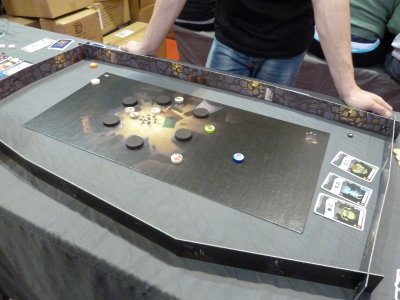
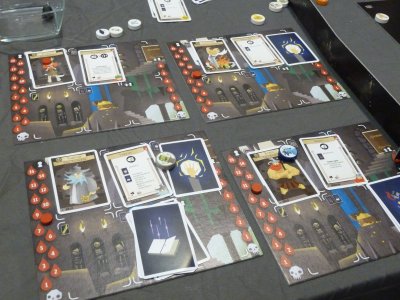
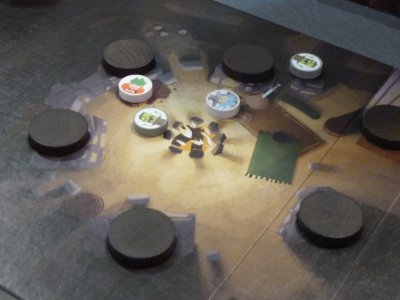
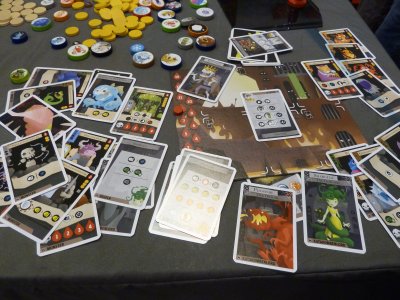
![[SPIEL]](ess15112.jpg)
Review: Antarctica (Argentum Verlag, Booth 3-F103)
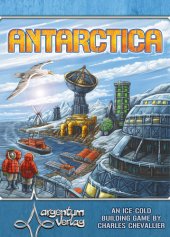

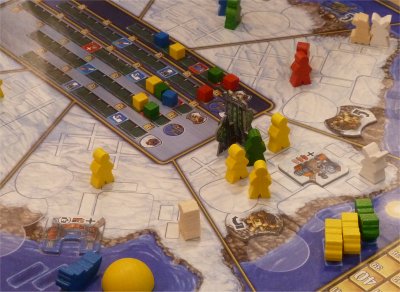
![[SPIEL]](ess15113.jpg)
![[SPIEL]](ess15114.jpg)
Review: 7 Wonders Duel (Repos Production, Booth 3-B109)
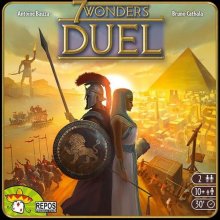
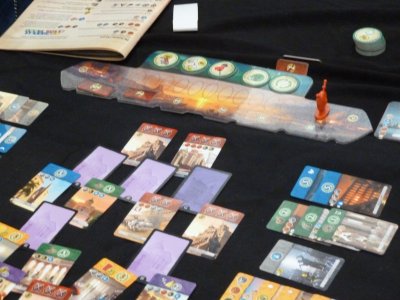
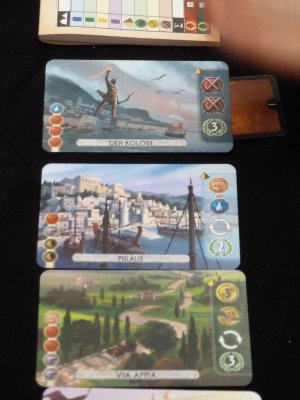
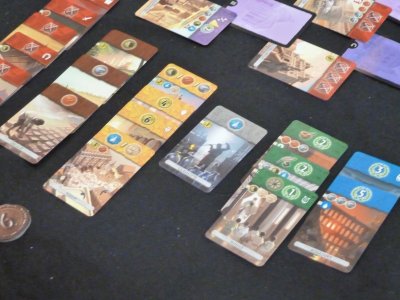
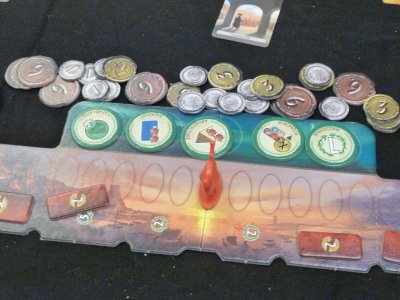
![[SPIEL]](ess15115.jpg)
![[SPIEL]](ess15116.jpg)
Review: Guns & Steel (Moaideas Game Design, Booth 7-B102)
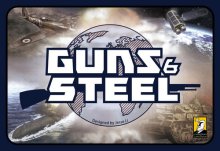
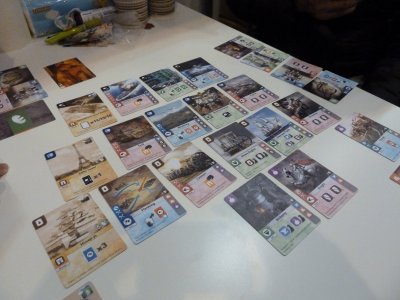
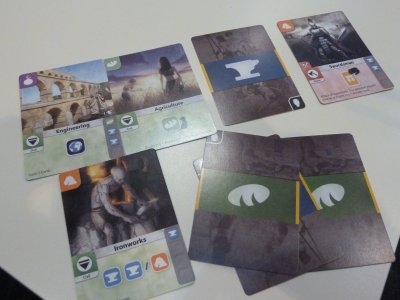
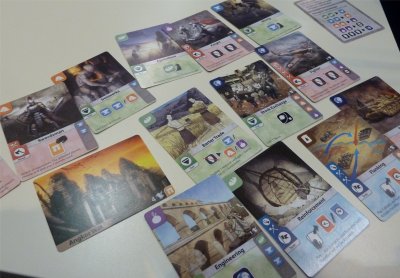
![[SPIEL]](ess15117.jpg)
![[SPIEL]](ess15118.jpg)
![[SPIEL]](ess15119.jpg)
![[SPIEL]](ess15120.jpg)
Saturday, 10th of October 2015
Welcome back everybody! You are in for a great ride today - that's a promise!!! So here we go: SPIEL '15 - Day 3.
Well, this was my last day of scheduled meetings, but since I still had to talk to some of the publishers I began my day at the show with a visit to two publishers - HEIDELBERGER SPIELEVERLAG and ASMODEE. It's a great thing that the bigger publishers have press rooms or even lounges. This gives me a possibility to check out some of the new games in a more quiet atmosphere, and it's certainly also more quiet in there.
![[SPIEL]](ess15131.jpg)
![[SPIEL]](ess15132.jpg)
However, today it was not as easy as it might sound to get to these two locations, since the SPIEL was even more crowded than the days before. Despite all speculations about the currently ongoing school holidays, it's rather hard to predict whether the weekend or the weekdays are better for a visit. The last two or three years I had the impression that the weekend had been less crowded, but today it was sometimes a bit difficult to get to all booths in time.
![[SPIEL]](ess15133.jpg)
However, as you might have noticed during all those years, nothing can ever keep me from getting a possibility to playtest a certain game, and so I was able to get myself a seat at the booth of 2F-SPIELE, getting ready to playtest the No. 2 game from the Geekbuzz list at BGG!

Whenever I hear the German term "Spielesammlung" (=games compendium) I remember my early childhood afternoons which I spent together with my grandfather. My father was off to work while my mother worked in my grandfather's mom-and-pop grocery store, and so my grandfather spent the time with me playing games. Apart from Monopoly and some children's games, his household featured one big box containing a games compendium, and this was composed of other all-time classics like Don't Worry, Chess, Checkers, Pick-up Sticks, Yatzhee etc.. Mind you, we are talking about the 1970ies here, and this kind of games collection was quite typical for many a household, since the evolution of modern boardgames as we know them today still was decades away. Nonetheless, these games offered some moderate gaming fun, and due to no real alternatives the games were played by us quite often.
I have often asked myself how a "Spielesammlung" would look like in our present time. It might contain a collection of Settlers of Catan, 7 Wonders etc., but one of the factors on which a classic games compendium is built is the versatility of the playing materials, often allowing the use of some of the contained materials in more than one game. So, a collection of modern all-time favourites would not really qualify as a "games compendium", but instead the concept would require some kind of modules.
Some years ago Friedemann Friese has released Fremde Federn, a game which has been designed on the basis of playing mechanisms imported from half a dozen successful other titles like Agricola or Through the Ages. The concept was quite interesting, since Friedemann proved that a totally new product could be designed by "borrowing" other playing mechanisms, and it also showed that Friedemann already was experimenting with the idea of combining different kinds of mechanisms. With this basis, Friedemann was the natural candidate for the creation of a modern age games compendium, and with his new creation 504 he has not just created 504 games in in one box, but he has actually given us 504 worlds to explore!

Building on a total of 9 different modules, 504 allows the players to create exactly this number of different games by using all possible combinations of 3 of these modules (9 times 8 times 7 = 504!). In its core, all 504 games/worlds included in the game use a modular gameboard of different landscapes on which the players can act, but the setup, the different types of available actions and the winning conditions are determined by the three modules which the players have decided to use for their game. The available modules can be roughly categorized as follows:
It may sound unbelievable, but it is possible to combine any three of these nine modules into a new game, and the most important resource for playing the game successful is the so-called "Book of Worlds". Close to a stroke of genius, this book is split into three sections of nine cards each, and so the players will be able to open the book in a way to display the rules and functions for each of their three chosen modules. This way all essential rules will be visible, and even the general turn structure, income and other extras are easily accessible.

However, I will give some additional kudos to Friedemann because the different modules do not only work together, but he actually was able to take into account a priority ranking for each of the modules, so that the rules for a module slightly differ in respect to its use either as primary, secondary or tertiary module. The primary module always is used to decide about the game's end and the victory conditions, the secondary module has a strong impact on the players' income, and the third module always adds additional gaming flavor by adding variable aspects. As a result, each different combination of modules really guarantees a quite unique game.
However, the variability of 504 certainly comes at its own price, and with so many possible combinations it could be expected that the general rulebook for the game certainly would be more difficult to read than any "normal" rulebook. Indeed, the general rules of the game and the rules for each module are initially difficult to grasp. Friedemann and his team have done their best in writing a structured and concise set of rules with examples, a turn structure and a starting world, but it still takes a bit of time to get a grasp for the different references and module combinations which must be taken into account when reading the rules. Coloured markings make it easy to identify which parts should be read and which parts can be skipped, but the combinations of modules and priorities still can make you a bit dizzy on first contact with 504. However, this is partly mitigated by the usefulness of the already mentioned "Book of Worlds" which proves to be an invaluable playing aid once the general playing principles have been understood.
But how does the game play? If you check out the initial combination of modules 1, 2 and 3, you will get to play a world named "The world of the travelling trailblazers with a liking for individualism". In this game you will combine transportation, racing and privileges, resulting in the players travelling around with their trading carts, trying to be the first to found new settlements and to deliver goods to cities. The players can purchase different kinds of improvements (the privileges), allowing them faster travel, bigger transportation capacities etc., and everything is run on an income which is generated from the delivery of goods. In the end, the game is won by the player who has collected most victory points by the delivery of goods.
In the combination I playtested, the game runs smoothly and the players get a quite easy grasp of all playing principles, and this observation pobably will not really change much with other worlds because it is always just three of the modules which will be used at the same time. Concerning the game's entertainment value, from my perspective 504 will appeal most to serious hobbyists, since the whole games compendium derives a lot of its attractiveness by the fact that players are challenged to discover and adjust strategies for each new combination of modules. This target group of players will appreciate the level of abstractness which was necessary to allow a smooth combination of the different modules, whereas "normal" family gamers might be put off by exactly the same level of abstractness.
At this point it must also be mentioned that a lot of the playing material included in 504 needs to be quite versatile in order to be used in all different worlds, and even though all components are nicely designed the general look of each world is more or less similar, regardless of the fact whether you have travelling trailblazers, militaristic explorers or productive investors. In this context once gamers with a big games collection may get more playing fun out of 504, because they will be able to resort to playing materials from other games to "pimp up" each world they will play. If 504 should be successful, I am certain that 2F-SPIELE will release an upgrade pack with additional playing materials to replace the generic meeples and square city tokens, but until then I can well imagine the use of tanks and industrial complexes from one game, or trucks and towns from another.

After 3.5 years of development, Friedemann once again has come up with an absolutely unique playing concept. The modular rules system employed in 504 is far more sophisticated than some of the self-proclaimed "sandbox" games which have appeared in recent years. To my mind the invitation to players to experiment with rules and mechanisms in order to improve a game often is a rather blatant way to say "sorry, but we couldn't really finish the game before its release", but any fear of such an effect is absolutely unnecessary when dealing with 504. All rules and mechanisms have been finetuned by Friedemann to create a rather harmonious final product, and gamers really should feel encouraged to take part in this outstanding gaming experiment.
With the rest of the morning not being planned in any way, I next made my way over to Hall 7 where I wanted to visit my friend Servando Carballar from Spain. Some years ago he had designed one of my all-time favourite games, Luna llena: Full Moon, and this year has returned to present Enrique Duenas' London after Midnight under his GEN-X publishing label.
![[SPIEL]](ess15134.jpg)

On a total of just 30 character cards the game brings together the who-is-who of Victorian age London. There is Dr. Jekyll, Dr. Van Helsing, Arsene Lupin, a Priest, a Damsel in Distress and a Brave Young Man, whereas on side of the monsters you can find Mr. Hyde, The Mummy, Wicked Servants and his Lordship Count Dracula. Drawing secret Faction cards at the beginning of the game, the players either take side of the heroes or the monsters, and at the game's end they will score a Victory point for every matching character card in their own playing area, but they will loose a point for every card they have played of the other faction.
At the beginning of the game, each player receives just one card from the deck, and during a turn the active player must choose between two simple actions: playing a Character card or drawing a Character card. If a player already has three cards on his hand, he cannot even draw a card anymore, but he will have to play one of his cards in order to make room once again to possibly draw a card.
When playing a card, the card will be placed in in the player's area (called Neighborhood) and the special ability of the card will be activated. These abilities are fairly straightforward, allowing the players to draw a new card, to steal a card from another player or to force the discarding of a character. Some card actions also can be used to discard cards from the player's hand, a quite useful action if the player has his hand filled with cards of the other faction. However, quite often the players will have to make a compromise, playing a card of the other faction even if this will cost them a Victory point when the game ends. The reasons for doing so are variable, either to hide the player's true alignment or to use the card's special ability, hoping that another chance still might come up to get rid of the card.
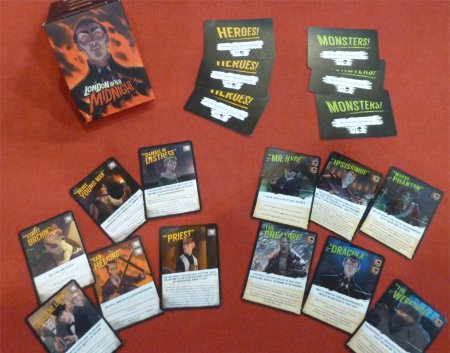
The game ends when the 30th and last Character card has been drawn, and the quick and direct way of playing reminds me quite a bit of Seiji Kanai's and Hayato Kisaragi's Lost Legacy. However, London after Midnight does not contain any cards which may cause a sudden death like Lost Legacy does, and even from playing it only shortly here at the SPIEL I could quickly discover that the game offers quite interesting room for speculation and misleading the other players once the players have gotten familiar with the composition of the Character deck. During first play you will only learn how the characters work, but already during your second game you will start to expect the arrival of certain characters later in the game, and so you will try to include this information in your cardplay for the next round or two.
Of course, there is luck involved when it comes to drawing a new card from the deck, but as described the cards offer enough special abilities to give the game some quite entertaining twists of fate. With a short, brutal playing time of about 10 minutes, the game played extraordinary well with just two players, and even though it can be played with a cast of 6 players I would think that the total deck size of 30 cards can be best enjoyed with 3 to 4 players, leaving each player enough possibilities to act.
Coming with a set of rather nice illustrations, London after Midnight certainly has been a rather nice find, and I am certain that the little deck of cards will be taken along on the one or other holiday trip by Nicole and me!
![[SPIEL]](ess15135.jpg)
Looking through the Meeple Times leaflet from the TAIWAN BOARDGAME DESIGN GROUP, Nicole yesterday has discovered a rather cute looking game about cats. The game is called Kitty Paw, and for today I have been given the mission to get one of these games home to her. Going down the isle from GEN-X GAMES to the TAIWAN BOARDGAME GROUP, I purchased one of these games and took it home, playing it for quite a bit during a slightly prolonged lunchbreak. Nicole actually was so fond of the game that we now have a debut here at Kulkmann's Gamebox, my wife's first review in 19 years of SPIEL reporting!!!
|
So, what can you do if you indulge two passions - felines and board games - at a time and it's Convention time? Well, you'll try to find the best of both worlds, obviously! So, I kept looking through the different leaflets which Frank has brought home during the past few days, and I discovered what? KITTY PAWS, a nice, clever and quick game for 1 to 4 players by Aza Chen. The game consists of 28 Kitty tiles featuring quite cute kitties of seven different types, showing the front or the back of the cat, respectively, on either side. It is the players' task to build specific "Kitty-Designs" using these tiles according to the patterns on the Kitty cards of which 48 are included in the game (24 easy design patterns, 16 intermediate patterns and 8 difficult patterns). ![[SPIEL]](ess15136.jpg) The game starts with all the kitty tiles on the table. The players each draw a kitty design card, reveal it simultaneously and start building their respective designs by grabbing the kitty tiles. The player who is the first one to finish his design screams "Meow!" and the round is over. Now everyone checks whether the design is correctly build. In that case, the player scores the number of victory points indicated on the card. If not, he/she suffers the penalty shown on the back of the Kitty card. All this is difficult enough but becomes even more complicated and brain-twisting if you have to take into account whether the design you have to build also features a cat in the litter box or in a cardboard box (every friend of felines' will notice immediately that this game is all about real life!!). In that latter case, you pimp your design by including a cat box card drawn from a different stack which has to be combined with the Kitty tiles in order to create the matching design pattern. ![[SPIEL]](ess15137.jpg) In sum, at first sight, this little game looks sweeter than sweet (the box has ears!!!), but make no mistake about it: It is no easy task to get the design patterns right (especially the level 2 and 3 patterns) and the very effort will make your head spin. But this game also gives you a good lesson in three-dimensional thinking and certainly is very, very addictive - catnip for humans, indeed! |
During my lunchbreak Nicole and I actually played a round of London after Midnight as well, and so I think that it's the best time to find out what Ralf has been doing all day long!
|
Again my day at SPIEL began quite early and before the official opening time. Elad Goldsteen from GOLDEN EGG GAMES had asked me to reschedule our appointment at Friday afternoon, because he needs every seat for the interested public. As I am a nice guy, I said yes, although this meant that instead of having a good night's rest, I would have to set the alarm quite early again. But who needs sleep when it is SPIEL time? So let us see what Elad had prepared to show me: Introduction: Prime Time (Golden Egg Games, Booth 1-D146)
Does anyone still remember Mad TV? Back in the 90s of the last century I have spent some time with this management simulation computer game. In the game the players were in charge to set up the broadcast for the day and on the same time attract a woman, who also worked in same station. When I first heard about Prime Time by GOLDEN EGG GAMES I at once was reminded of this quite popular video game in Germany. And indeed the board game has some remarkable similarities with Mad TV. But of course from today's point of view I would say that it is much better, because I like it to compete with human beings instead of trying to finesse a computer programme. So this could already be my final words about Elad Goldsteen's new game, right? Not? OK, let us carry on: As in Mad TV, we take the role of executives in a broadcasting network each. In the game we are asked to set up a broadcasting schedule for a whole week, trying to fulfil the wishes from the audience that can roughly be derived from a forecast table. Each round begins with a development phase in which players choose new shows and talents and determine the order for the rest of the round. Also it is possible to take cheap "re-runs" and invest in public relations to influence the forecasts. There are some tricky decisions to be made, because most spaces are limited and going for new shows and talents is resolved in a bidding. 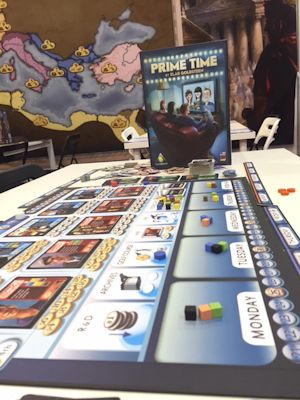 Equipped with new talent and show cards in our hand, we can go on to the next phase in which the broadcast is set up and resolved. First of all the now static forecast in form of demographic cubes (each colour of a cube representing a specific genre) is added to four randomly drawn demographic cubes for the day. So in the end each day has 4-7 demographic cubes that determine the genre wishes of the audience. Now that all players know what the audience like - it is time to set up the schedule. In turn order each player can add talent or show cards from his hand to the schedule. Talents can only be added to shows, at least to series . When all players are finished setting up their schedule, it is time for the rating, in which the players take from the demographic cubes and place these cubes on corresponding genres of the day's shows or talents. Finally talents and shows that did not attract any demographic cubes are fired respectively dropped. Then it is time for awards and income. At the end of the round all single shows and talent cards are removed from the timetable. Series stay in the schedule unless nobody wanted to watch them. So it is extremely important to place them right to attract as many demographic cubes as possible in every round of the game. 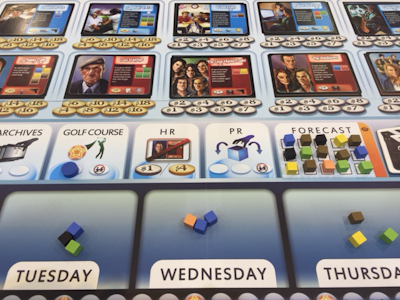 Prime Time seems to be easily accessible, but Elad told me that it is definitely no family game. There are a lot of decisions to made that further influence the game. I think the forecast mechanism is quite straightforward and helps a lot predicting of what will be the wishes of the audience in the rounds to come. Shows as well as talent cards are funny illustrated (similarities with VIPs cannot be ruled out) and the game looked very entertaining to my mind. And yes it should replace the typical Saturday-evening-family-TV-show or movie. As said before, it is much better to play a board game about television than watch television... Elad introduced me also to his newest game that only last month finished on Kickstarter. It is much more a family game and is called Rome. Elad was especially proud of the unique dice placement system in the game. At the moment I do not have enough time for writing about it, so I just show you some pictures. But I got a copy of the game and so I will do a review in the next weeks. 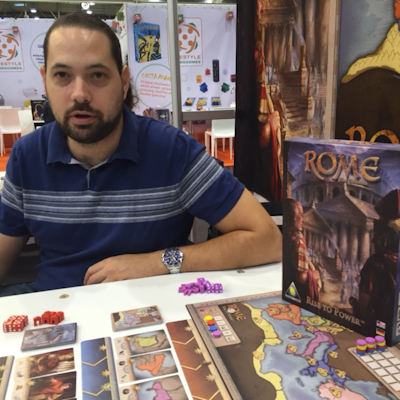 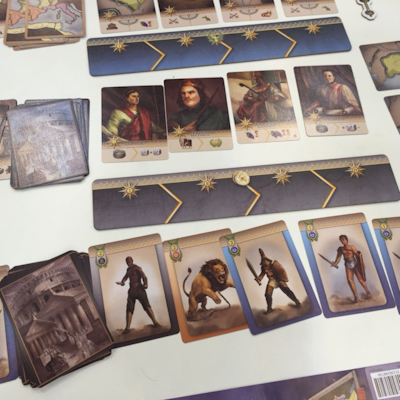 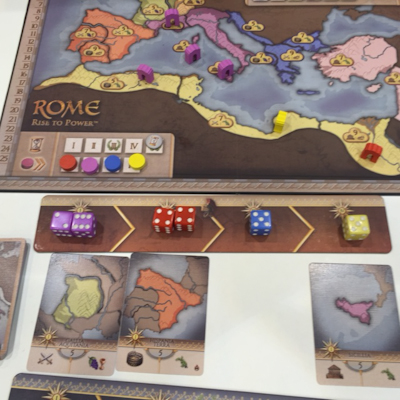 Time was passing by and after I had left the booth of GOLDEN EGG GAMES I came to the conclusion that this day would be the most crowded one. I tried to meet some friends of one of my gaming groups, but the crowd would not let me pass. So I came there quite late. OK, maybe the counter of KOSMOS was not excatly what you can call the best meeting point... ![[SPIEL]](ess15145.jpg) On my way to hall 7 again I came across a weird gathering of people, holding up papers with one or two words on it. I had no clue what that would mean, so I asked one of the security guards and was told that this is kind of a swap meet. People had set up this appointment via Facebook and were looking for their partners to exchange eagerly anticipated games. ![[SPIEL]](ess15146.jpg) I also had a look at the place where everything was already prepared for the world record of Settler of Catan. ![[SPIEL]](ess15147.jpg) But there was still some time left, so I decided to have a closer look at one of the games on BGG's TOP 50. Two years ago PORTAL published the game b>Legacy: The Testament of Duke de Crecy, a game about building dynasties through several generations by making beneficial marriages. At the very moment we can find the first expansion for this successful game, again published by Portal. So I was quite curious when I read that the Danish publisher AMONG MEEPLES announced the game Among Nobles that - after reading a short summary - had some remarkable resemblance to the game by PORTAL. So I wrote an e-mail to the publisher and was immediately invited to a demo session. So here it is: Introduction: Among Nobles (AMONG MEEPLES, Booth 7-D104)
Among Nobles plays in feudal Europe. So we find famous characters like Charles I of England, Isabel de Portugal, Napoleon Bonaparte or Henry VIII of England as characters in the game. Like in Legacy our objective is to expand our family over three generations. Also comparable we build a kind of family tree before us by adding marriage partners or children to our family cards by different actions. But with this the direct similarities between the two games end. Among Nobles is no typical worker placement game. Every player chooses his actions by activating a character or a couple of his family. There are no general board or other actions to choose from. So you are focused on your abilities alone. And these are given by the cards themselves. Each card of the game represents a lord or a lady and has four rows of action series to chose from. So once the person is activated you can choose which row you want to perform. Each action series is comprised of one or two single actions. But that is not all: if you activate a couple, the chosen action series of each partner can be carried out. So up to four actions by a single activation can be achieved. The possible actions vary from gaining gold or prestige points, inducing labour (taking a character from a display line), marry a partner from one of your opponents to warfare. With the last action armies are sent to provinces, that are scored at the end of every round. 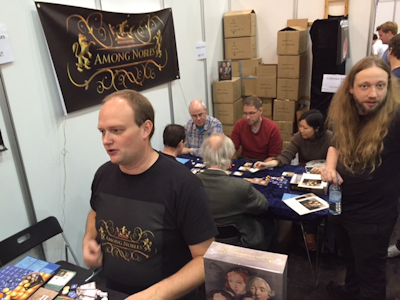 All characters also have a special rule either when it comes to birth or marriage, in case of a generational change that occurs three times in the game, an intrigue or even have a permanent special ability. So different strategies can lead to success in the game. You can either go for the region majorities or see that you will get the best marriage partners. Sometimes it even seems to be better to take a person you actually doesn't want, only to prevent that one of your competitors will get her. I really liked the idea of Among Nobles. From what I heard and saw I would say that it is feeling quite different from Legacy. I especially liked the mechanics of extending your actions series by marriage. OK, not everything fits to our time. In the game there is no indication of gender equality. Male characters are clearly in favour. But then, it is the feudal Europe. What do you expect? So although I guess some people might be offended by these rules, I personally had no problems with it. 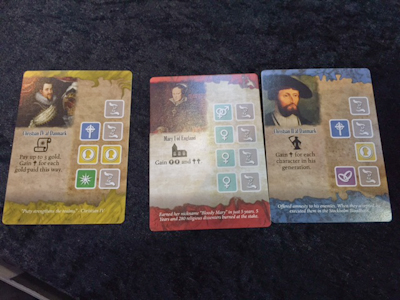 I had more problems with the fact that in the game you can marry Napoleon to Catherine the Great and Mary I to Christian II. But then I thought about some other strange marriage promises of that time and I said: when nearly every marriage during that time was an arranged one, why not? From the point of my first try-out I would say that Among Nobles compared to Legacy further expands the game mechanism of building your own family tree. But which game is the better one? To be honest, at the moment, I do not know. Both games have their specialities. Perhaps there is room for both games, but, of course, Legacy has a certain starting advantage. And it is already given a G@mebox Star so let us see, if Among Nobles can reach that, too... So now it really was time for the world record. And right I heard that over 1000 people were playing Settlers of Catan simultaneously, Klaus Teuber among them, so congratulations from my side and the whole Kulkmann's G@mebox team. ![[SPIEL]](ess15148.jpg) Time was flying by again, but this afternoon I got the chance to test something very special: the prototype of 7th continent, an adventure boardgame with a very unique development system that is quite successful on Kickstarter at that very moment. Introduction: The 7th Continent (Serious Poulp, Booth 7-J113)
I was introduced by one of the authors, Bruno Sautter, who did an excellent job explaining the rules and conveyed a sense of the game. That was quite necessary, because it would have been impossible to play a whole game. Believe it or not, but this game will take you hours and hours to end. Bruno said that a normal game will last longer than 10 hours, sometimes even 24 hours. You can play the game solo, but if you are playing with other players, you play as a team, so you either loose the game or not. The basic mechanics are based on those fantasy books, in which you take the role of a hero and must decide - normally after one page of reading - what you are heading for or how you react in a given situation. Depending from your answer you are told to continue reading on this or that side of the book. With 7th Continent you get the same feeling, but it is much more. You also can really see what you are doing and you must pay attention on every detail on the cards you use as landscape of the 7th continent. The game starts with you (and your party), knowing nothing of the 7th continent, on a lonely location card in the middle of the table. A curse has afflicted the players and it's the player's aim to lift it again. Every location where your party can go, tells you what you can do there and normally there are also some directions to explore, where you can find new landscapes that further expand the land. Whenever a new card is added, the game tells you which card you should take exactly from a story deck (so for example number 25). This new card adds more details to the storyline, but you must conclude from what you already know what leads you further and which way is a deadlock. 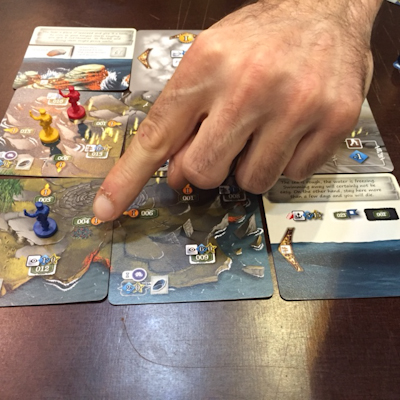 Every decision you make in the game influences your further game play. So if you are not able to build a raft, because you can't find the material to do so you probably won't be able to cross a river. So you might try to climb a mountain that leads you to another direction, but you may fail there, too, and have to find a new way for going further. In the game, depending on the locations, there are many actions you can choose from. So you can spot for new elements in the game, make fire for cooking your foot, rest, climb, dig and so on. Every hero comes with a set of different ideas that can be found and learnt during the game. 7th Continent also uses a clever save system (which is also necessary regarding the average playing time). All of your heroes equipment and skills are saved by collecting the cards in a strict order. The landscape you already have explored on the other hand, is discarded and only the landscape tile you ended your session is saved for the next day. So, like in real life, you may forget where to find a mountain or a lake. But due to the clever game design, the game still knows that left to your current position there is a mountain, because again the game would tell you which card to take when you are going there. But some details could change. So on the one day, you could find the farm house abandoned, while in the other day a robber band might try to hack you to pieces in this house. 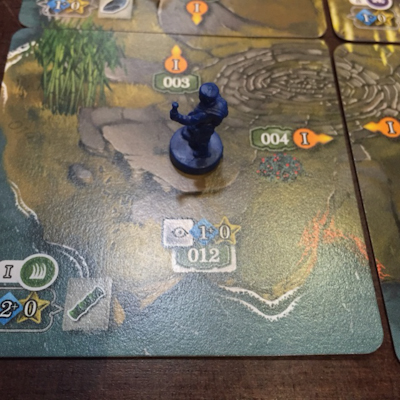 I was deeply impressed by the game design. This is something really unique and special. At the moment I cannot believe that there won't be any logical mistakes, but Bruno swore that he had spent two years night and day to prevent this and will have another year before the game will be published. I will be back in the next year, too, to have a look at the final production. After this great experience I once again met with the friends of my gaming group and we tried one of the new games by G3. Review: $tinky Busines$ (G3, Booth 1-F139)
Although we all know that money does not stink, the Polish publisher G3 and its brand ST Games tells us something else. In one of their new releases at this SPIEL, they exactly take the waste management as subject. OK, you must confess that waste is not comparable with perfume when it comes to odour. But when you see the business behind, it is all about money again. Here in Germany in most regions we have 3-5 different dustbins, that are collected by different companies. Every few years the collection must be advertised for bids again and if you know that only few placings are carried out without a claim you can conclude that there lurks a lot of money beneath of what you can see. Although or maybe precisely because waste is not what you would call a popular theme for a board game, I was quite interested about how Piotr Jesionek, the author of the game, has managed to find mechanics to set up an interesting board game. $itnky Business$ has five different waste processing facilities and each player chairs a company that covers the whole process of the different waste processing and collections. Of course waste is not waste and so we find valuable things (in form of cards) like aluminium and glass as well as garbage. For all of these types of waste different waste processes are necessary. Only if a player possesses the appropriate processing facilities, he will be able to completely commercialize his collected waste. 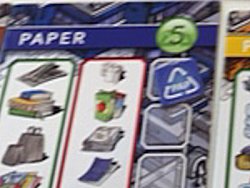 Each round begins with a littering phase, in which players choose a waste card from four randomly cards of the draw pile. This card can either directly be sent to a waste processing facility of the player or be taken in the hand (up to hand limit) for later rounds. All other cards go to sector I at the main board. In the following investment phase, players can buy recycling plants that are placed on the three different sectors on the main board. These recycling plants determine the number of cards a player may draw from the sector's drawing pile of waste cards in the next phase of the game. But to recycle the waste he must also have the appropriate processing facility on his own player board that he can also buy in the investment phase. Finally left over waste can be sent to incineration if the player owns incineration plants and there is enough waste left. Of course all these contributes to the player's income in the next phase in which the garbage card can be recycled or incinerated - depending on whether the player have corresponding facilities or not . 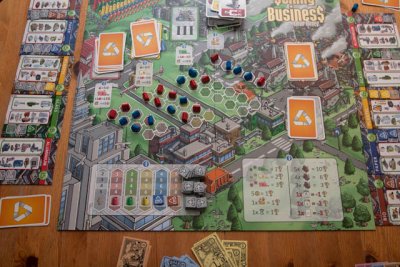 Piotr Jesionek and $itnky Business$ do not have an easy job. Garbage is not fantasy, not science fiction, not the Middle Ages nor the Roman Empire. It is just waste. But I think the author has made a very good fist of it. After some problems with the rules in the first two rounds, the game felt very straightforward. Although simplistic the game roughly shows the players how the waste business works like. Further information about the time of decomposition and the possible recycling type on each waste cards are for educational reasons. So you can see that $tinky Business$ was designed to work as a game for the whole family. That nearly ended my day at SPIEL, but there was one thing left to do: Update: Conan (Monolith, Booth 1-F100)Conan by the MONOLITH team was the most successful boardgame on Kickstarter for nearly half a year. It is still second, only the new Zombicide campaign was more successful. I already had played the prototype last year, so maybe you want to check how it works in our reports from SPIEL2014. At the convention 2014 they also got me in and I took part in the kickstarter campaign, so I am expecting the game in early 2016. The campaign, although delayed due to the massive amount of pledge levels, is the best I have seen so far. This week we already got the 138th update with new pictures of what expects us. In this message they also told us that here in Essen they would have the production models and some of the great painted models by Martin Grandbarbe. I did not want to miss this and so I approached the booth of ASMODEE where the Monolith team was running two tables with 3D sceneries and the announced models. Here I also met again with Itaï Perez, who is part of the MONOLITH team but also helped developing The 7th continent where I had met him before (Thanks again for setting up the demo!!!). He willingly showed me the new models, so here are the pictures: 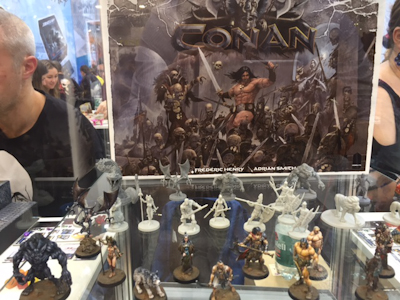 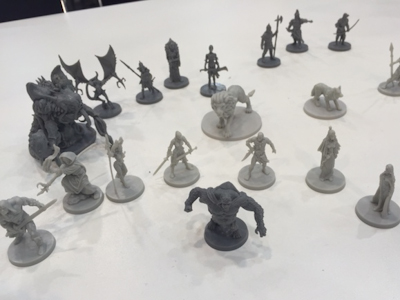 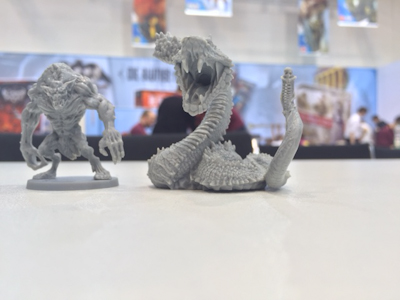 But with this I really end my day for today. One day left to follow, so I will try to get some sleep. |
So I am back after my lunchbreak!
For the afternoon my last meetings were scheduled, and so I first headed for the business lounge at the end of hall 3 where I wanted to meet with Rob van Zyl from South Africa. He is the co-designer and artist of Ancient Terrible Things, and after a successful Kickstarter project the new Ancient Terrible Things: The Loster Charter expansion has been finished and is about to be delivered. PLEASANT COMPANY GAMES does not have a booth at the SPIEL this year, but Rob nonetheless has come for a visit to discuss with publishing partners and to be available for the launch aof the German version of Alte Dunkle Dinge by FEUERLAND SPIELE (booth 3-D100). Rob has brought a copy of the freshly printed expansion set along for me, and we spent a bit of time going through all the included components and ideas.
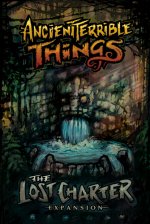
At the SPIEL '14 PLEASANT COMPANY GAMES first presented their pulp horror dice game Ancient Terrible Things. Going on an expedition in a remote corner of the Amazon basin, the player characters have to face different encounters, solving them by rolling ever more difficult combinations with their hand of different dice. Four different colours of dice exist in the game, and each colour represents a certain type of dice, with some of them being able to be influenced by different kinds of tokens, whereas others will lock on their result once they have been rolled. In the end, the player who has successfully solved the most difficult/valuable encounters will have won the game, and so the players have to balance their chances carefully whenever chosing a new encounter for their current turn.
Even though the square sized box of the expansion is comparatively small, it is not only the new playing components which enhance the game, but the box itself also serves a very special purpose. As a matter of fact, the gamboard of the basic game is relatively big, and so the expansion comes with 8 small Location cards depicting the locations from the gameboard. Using the small box which can store all game components and serves nicely for rolling dice, Ancient Terrible Things now can be carried along in a travel-friendly version, allowing the game to be tasted in locations as exotic as the game's theme…
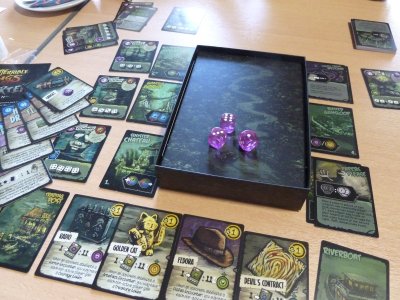
But let's now have a look at the new playing components offered by the expansion. Coming with a deck of approx. 50 cards and 3 purple Revelation dice, the expansion is meant to be completely mixed with the components of the base game. Apart from the Character board and pawn which can be used to include a fifth player, the new cards cannot be added on a modular basis, but instead the new Encounter, Feat, Equipment and Achievement cards must be used together because the functions and effects of the new cards are partly interrelated.
The major portion of the stack of new cards is made up by new Encounter cards, and on these cards three new types of encounters are introduced. Quite interesting are the Revelation Encounters which require the player to add one of the new purple dice to his roll, giving him an additional chance to reach some dice combos, but also including some especially nasty combos using more dice than usual. The more careful adventurers probably will welcome the new Warning Encounters, having a comparatively low value but not requiring the player to take a Terrible Thing token when the combo is failed. In terms of variation, the included Event Encounters will offer some unexpected effects, since such an event will cover the location where it has been placed, and they often bring along a lasting effect changing the normal course of the game.
A completely new type of cards are the Character Obsession cards, assigning each player character a specific obsession which he must try to get rid of before the game is over. These cards challenge a player to try an encounter failed by another player, giving him a chance to get rid of the obsession and gaining him the benefits associated with the encounter. Similar effects can also be triggered by some of the new Feat cards, allowing a player to step in and rescue someone who has miserably failed rolling a required combo.
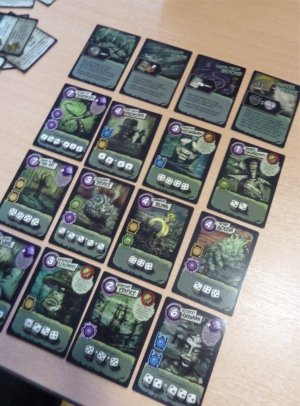
Apart from being a handy travel edition, Ancient Terrible Things: The Lost Charter nicely increases direct player interaction without resorting to harsh effects which would unbalance the game. Rescuing a player, following up on an event or making a trade offer are the gateways which Simon McGregor and Rob van Zyl have employed to give the players an increased possibility for interaction, and with these enhancements they have made a nominable effort to tackle one of the soft spots of many tactical dice games. In this type of games the players quite often will concentrate on their own turns, trying to get most out of their dice rolls without caring too much about the activities of their fellow players. Competition remains mostly indirect, focusing on reaching certain things first. Even though Ancient Terrible Things: The Lost Charter does not introduce any dramatic innovations, the players still will keep a closer watch on the things happening out of their own turns, and this nicely increases the playing experience for all participants.
From my perspective, Ancient Terrible Things: The Lost Charteris an expansion which nicely evolves the basic game, including a good load of ideas which offer new ways to enjoy the basic game. Once you have added the new cards, you will not want to miss them, but you can rest assured: the game's complexity does not increase, and so Ancient Terrible Things remains being a game which can easily be taught to newcomers.
![[SPIEL]](ess15139.jpg)
Leaving the business lounge once again with a bit of free time, I turned into aisle which I hadn't visited before, and here, at the booth of French publisher SWEET GAMES I actually had one of the most emotional moments during all those years of SPIEL reporting.
![[SPIEL]](ess15140.jpg)
SWEET GAMES is presenting here at the SPIEL a small game names Les Poilus ("The Grizzled"), a game about the Great War. I first thought that the game actually about the spontaneous Christmas Truce which had been happening at different parts along the Western Front on Christmas 1914, but it is actually a cooperative game about a group of young French men who has been drafted by the French government to join the army in 1914.
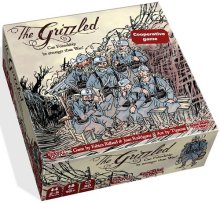
As indicated, the players will take the roles of a group of French soldiers, and as the subtiles of the game suggests, these men have sworn that their friendship will be stronger than the war. So, the will go on a number of missions, and these will be simulated by a variant of a push your luck mechanism in which the current mission leader (=active player) first assigns a freely chosen number of Mission cards to each player and afterwards the players try to play all these cards from their hands. If the players can successfully get rid of all or most cards assigned to them, a number of Mission cards from the deck will be discarded, whereas a mission going awry will result in new cards being added to the Mission deck. These cards come from a second deck which is positioned on a Memorial card depicting the names of the group of friends, and if the Memorial deck runs out of cards the game will be lost by the players. So, the players will strive to get rid of all their Mission deck, signalizing the end of the war and the winning of the game.
The mission deck shows a combination of weather conditions and traumatizing symbols like a shell, a gasmask and a whistle (which stands for a call to attack). In turn, each of the players will add one of his hand cards to an open display, always keeping an eye on the fact that the adverse weather conditions and the symbols may not be shown on more than two of the cards. A third card of this type would cause the mission to fail, thus adding new cards to the Mission deck. A player actually may withdraw from the mission if his hand-cards would cause him to trigger a Mission failiure, but if too many cards are still on the player's hand this also may cause new cards to be added to the deck.
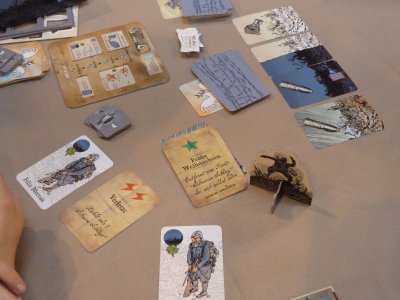
Another type of cards included in the Mission deck are Moments of Fate. These mostly negative events will be placed in front of the player, causing some long term restrictions on his cardplay or other playing conditions. If a player collects too many of these cards his character will die, once again resulting in a loss of the game. For this reason the players have markers for backing each others, and after a mission is over these markers will be secretly assigned in order to help wounded characters to get rid of their Moments of Fate.
The game plays fairly easily, but the cooperative elements have been implemented quite well, and the scary scenario will grip the players right away. Even though the war itself remains mostly abstract, the game draws a very intense atmosphere from the players trying to assist each other, and the fact that communications about hand cards and Backing markers are restricted all adds to a quite unusual cooperative experience. The push-your-luck variant chosen for the game leads to an interesting dilemma, since the players want to get rid of their Mission cards as soon as possible, but on the other hand too many cards on hand may cause a severe mission failure and additional Moments of Fate. It's up to each player to decide whether he is in or out, and this once again adds to a quite unusual teamplay.
![[SPIEL]](ess15141.jpg)
Designed by Fabien Riffaud and Juan Rodriguez, this game certainly is my most unusual find quite a few years, but this story of hope and friendship gets outright scary if you look at the name of the artist who has illustrated the game. The drawings have been done by Bernard Tignous, and it was actually his last work before I got killed by the terrorist attack on Charlie Hebdo in January 2015. The game's spirit stands in strong contrast to exactly this type of terrorism and madness which has caused the shooting at Paris, and in this way Les Poilus stands as a memorial against all kinds of war and fanatism.
Brrr, it actually took a bit of time and a slow stroll through the courtyard in order to get back into SPIEL-mood after this somewhat depressing story, but nonetheless I went on to the booth of GRANNA where I was scheduled to meet Filip Mi?u?ski to check out their new game CVlizations. So, it's once again gaming time!
![[SPIEL]](ess15143.jpg)
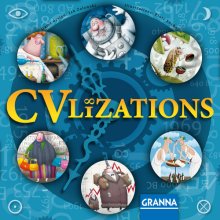
Whereas Filip tactical dice game CV focused on the way of life of a single person, the new GRANNA game CVlizations by Jan Zalewski takes the whole issue onto a larger scale, giving the players a possibility to develop the achievements and traits of whole civilizations. However, despite the similar sounding name which has been chosen to put both games into the same series, the playing mechanisms found in both games do not really correlate. So, CVlizations totally forgoes the use of dice, but instead the game belongs to the modern species of micro-civilization games in which the players have to manage a rather straightforward amount of resources to develop their nations.
During the game the success of each player will be measured in form of Happiness, and so the game will be won by the player who has managed to create the happiest nation. Happiness points can be gained through Ideas, the game's collective term for cards displaying developments in the fields of buildings, tools, inventions and ideologies. These cards can be acquired from an open display, with the players making payments in different combinations of the game's resources Food, Wood and Stone. When acquired, each of these cards will count for some Happiness points at the game's end, with some of the cards having a fixed value, whereas others display conditions or action possibilities to gain bonus points. Apart from the Ideas, Happiness tokens also can be gained during the Action phase if a player has chosen the "Slacking" order card for this round.
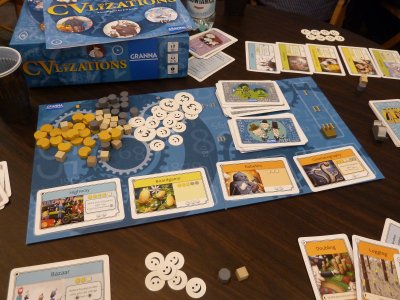
Let's examine these Order cards a bit closer since their usage forms the central mechanism on which the game operates. Each player possesses an identical set of 8 Order cards, and each of these cards allows the player to perform a specific action for his nation. So, a player can generate a certain amount of one resource, collect a minor amount of a freely chosen combination of resources, trade resources, steal some resources from another player, gain some Happiness tokens or even double the effect of another order.
At the beginning of a round, in player order each player will chose two of his Order cards to play during this round, with one card being face up and one card remaining hidden for the other players. Since the Order cards are chosen in player order, the later players have the advantage of knowing (at least in part) which cards have been chosen by their competitors, and it is necessary to make best use of this knowledge because the effectiveness of an Order card actually depends on the number of players who have chosen this order for the ongoing round. So, an Order card will have a minor effect if only one player has chosen it, whereas the effect will be much better if it has been chosen by two players. However, since too many cooks spoil the broth, three or more players chosing the same order will strongly devaluate the card's effect, giving those players either some very small benefit or none at all. On a sidenote, it should become obvious at this point that the game is played best with a cast of 3 or 4 players. The rules include a quite strategic 2-player variant, but in case of CVlizations it's certainly the more the better.
But back to the orders. The players only will get back their full hand of Order cards at the end of an Age after three rounds of play, and so everybody will face an interesting challenge to guess and counter-guess which cards will have been chosen to be played faced down in the current round. During an age, a good estimation for timing and also some tactical considerations are quite important, since the players need to chose between gaining some resources on their own or possibly sabotaging an action by chosing an order which also has been chosen by some of the other players. Since the game only runs for a total of three Ages (which is 9 rounds), a good pokerface to pull off the one or other bluff also is important, since only a player who can gather a good amount of resources will do well in CVlizations.
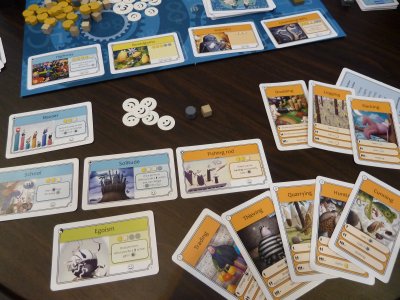
As you can see, CVlizations is a good representative for a minimalistic approach to the civilization-theme, but the game nicely brings together some straightforward resource management with a good degree of player interaction. On the one hand the mechanism associated with the playing of the Order cards ensures that the players keep a rather close look on the ordering activities of their competitors, but on the other hand the players also compete for the most lucrative Idea cards, since these cards do not only provide happiness, but each Idea also comes along with a special ability which allows its owner to perform orders with an even higher efficiency or to score additional points at the game's end.
The off-mainstream, comic-like illustration style chosen for CVlizations actually is the same as in CV, and even though the playing mechanism is distinctively different Polish publisher GRANNA actually was right to make an association between both games by use of a similar sounding name. Both games are based on development, and the degree of complexity found in both games is comparable as well. So, if you are looking for civilization in a nutshell, you might wish to check out CVlizations due to the well implemented, quite interactive approach to the theme.
![[SPIEL]](ess15142.jpg)
The last playtesting round today was something I had been looking forwards to for quite some time, and so I had reserved a longer time-slot in order to play a game of M.U.L.E. at the booth of LAUTAPELIT.FI together with the game's designers Heikki Harju and Tuomo Mattila, and we were also joined by Christian Schiller, manager of the World of M.U.L.E. fan community.
Some of you might actually remember that during my reports from the SPIEL '10 and '11 convention I was telling you a bit about an upcoming boardgame version of Dan Bunten's classic computer game M.U.L.E.. 5 years back Heikki had presented the prototype for a boardgame version of M.U.L.E. at the booth of Finnish publisher TUONELA, but it took some more years and a publisher change until the prototype finally was ready for production. Now Heikki Harju is back with the finished game, and LAUTAPELIT finally invites me and many other old school gamers to return to Planet Irata.
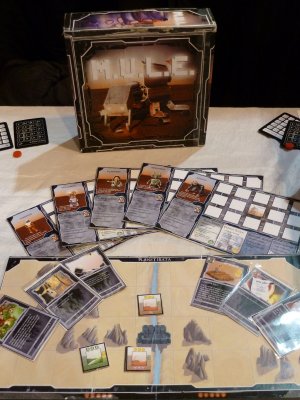

So, what's the hype about? What was so innovative about this dusty old computer game that players still go crazy when it is mentioned over 30 years later? Well, you must remember that this was a time still well ahead of the internet, with pixel graphics and a maximum of 16 colours on screen. At that time playing a computer game was a quite lonely experience without any kind of audio or video interaction, and so players spent lonely hours in front of the screen. If you imagine this setting, it was almost revolutionary that a computer game actually required 2 to 4 players to come together, going for a colonization and mining project on Planet Irata in the far reaches of the Universe. The game was quite famous for its market algorithms, determining all resource prices on offer and demand, but apart from the highly economic orientation it also had some cute funny moments with crazy special events and a possibility to hunt the Wampus, some kind of strange being living on Irata.
Even though M.U.L.E. always had been considered being an almost natural candidate for a boardgame version, Heikki was facing a quite difficult task since his design would have to bring together different generations and playing aspects. On the one hand computer game veterans always would judge a boardgame version of M.U.L.E. on basis of the computer game, whereas modern boardgamers - quite unaware of the computer game - would evaluate the game purely on the basis of its playability. Another point are the market mechanisms. Since the economical aspect was the crucial element in the computer game, a boardgame version certainly would have to recreate the market without getting too fiddly or too boring. And finally, the humor of the computer game also would have to find a place in the boardgame version, and bringing all this together certainly was a major task for any boardgame designer. But now, after years of development, M.U.L.E. finally comes to the tables, and so let's board a spaceship, buy some M.U.L.E.s (Multiple Use Labor Elements) and start mining for Smithore and valuable Crystite!
Depending on the choice of the players to play the slightly easier Beginner Game or the full Tournament Game, a game of M.U.L.E. will run for a total of 6 or 7 rounds. During this time, each player will try to establish a fully grown mining and production chain using the Land tiles which he has acquired and placed on his player board. The Land tiles can be claimed for the surface of planet Irata, and at the beginning of the game the Land tiles have been spread out on a major gameboard which depicts the planet and the Store, the only major settlement on Irata. Four different commodities can be produced in the game, and these are Food, Energy, Smithore and Crystite. All Land tiles possess different production capacities for these four commodities, but whereas the possible yield of Food, Energy and Smithore can be seen on a tile's front side, the production capacities for valuable Crystite are printed on its (secret) backside, only to be revealed if the tile is assayed or if a player tries his luck and simply starts mining for Crystite on the tile.
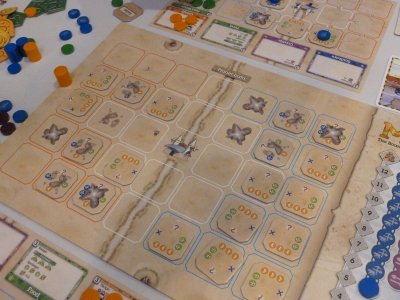
For the production of all four commodities the players need the name-giving M.U.L.E.s, robotic machines which can be installed on a land tile to produce one of the commodities which can be found there. Since each player begins the game with one meagre M.U.L.E., they will require more of them to start working on more land tiles, and for this they can turn to the Store where new M.U.L.E.s will be produced from Smithore sold to the Store. However, in order to operate, a M.U.L.E. also needs Energy, and so the players have to balance their production capacities between producing Energy to power their M.U.L.E.s, Smithore to get more M.U.L.E.s, and Crystite which can be sold at high prices in order to become rich enough to win the game.
But what about Food? Well, in a way Food can be considered to be a second currency. Whereas the players need money for all purchase transactions with the Store, they need food to perform all actions like buying M.U.L.E.s or assaying land. It is also possible to change the commodity produced by a M.U.L.E. or to move a M.U.L.E. to a different Land tile, but this costs Food as well, especially of the Land tiles in question are situated on the outer borders of a player's board.
In order not to overburden the playing mechanism, the basic structure of each round is fairly easy. The players first have a possibility to acquire new Land tiles, before they start spending Food for buying and refitting M.U.L.E.s, assaying lands, gambling in the pub (small monetary gains) or trying to hunt the Wampus (luck based medium monetary gains). Next follows the spoilage of surplus stocks and the production of new commodities, and each production step is also enhanced by a randomly drawn Production card which will list some kind of special event for the phase. This is followed by the Market phase before finally the round ends with the players' ranking and personal events.
Let's look a bit closer at the Market Phase. As indicated, the players can buy or sell all four commodities available in the game, and the prices for which the Store buys or sells are determined on a price track before the individual sales start. From my perspective Heikki has found a quite good solution for importing the market mechanisms of the computer game into the boardgame, since the price level for each commodity can be determined rather quickly, following a few simple rules. The Smithore prices in the Store will increase if the Store does have less than 12 M.U.L.E.s in its "for sale" pen, whereas the price will decrease for each surplus Smithore unit in the Store if the pen is full. It's as simple with Food, since the Food price will increase for each unit of Food each player is below 4, whereas it will decrease for each unit of Food in the Store's warehouse. And Energy also is dealt with in a similar fashion, since a price increase is triggered if the Energy in the players' stocks is not sufficient to power all their M.U.L.E.s, whereas the price decreases for each unit of Energy available in the Store. Finally, the prices for Crystite are determined by a simple randomizer, using a value shown on the current Production card. Following these simple rules, Heikki and Tuomo really did the trick of bringing together well-working market mechanisms and a degree of simplicity which is needed for the smooth running of a boardgame. Kudos!
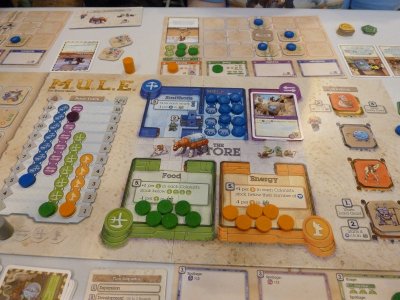
Returning the end of a round, another quite important element in the design of M.U.L.E. is the fact that a player ranking is established and adjusted at the end of each round, based on the players' wealth. This does not only serve as a leaderboard, but instead M.U.L.E. actually incorporates some playing mechanisms which will make the game a bit harder for the current leader. So, The leader will be allowed to draw a Lucky Event card which he has to hand to another player (usually someone who has fallen behind), whereas the player who has been the target of this Lucky Event will be given an Unlucky Event which he may assign to a player of his choice. This quite often will be the current leader, and so a player who does economically well may have to face some detrimental effects.
Talking to Heikki about this balancing mechanism, he pointed out that the way the player ranking works in conjunction with the events, effectively helping those who are falling behind, was a specific feature of M.U.L.E.. Heikki is quite aware that such a design is quite unique in the world of board gaming, but in his opinion it addresses a typical problem. When playing with 4 players, it is a quite common situation that not everyone will play with equal skill, experience and knowledge of the game. Due to the very strategic orientation of M.U.L.E., someone who has fallen behind might want to give up halfway through the game. At this point the special features of the players' ranking come in, equalizing the game without just increasing the element of luck, but actually mitigating the effects of both luck and overburdening skill. To Heikki's opinion, it's something that makes the game different, but if some players should not like the way ranking works the rulebook also contains some optional rules that lessen the effects of the player ranking.
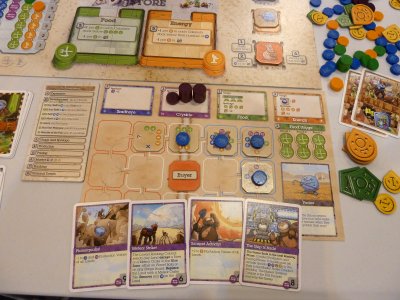
All in all, this do not just sound quite intriguing, but to my opinion Heikki's and Tuomo's approach will ensure that everybody has a chance to enjoy the game from start till end, keeping at least a slight chance to turn the table. In a game which relies heavily on economics, one or two wrong decisions might prove disastrous, and it stands in line with the spirit of Dan Bunten's computer game that such harsh effects are softened in the boardgame. Of course, as the rules state there will always be some gamers who like full and absolute control, and this species may be put off by effects counterbalancing their economic feats, but in the end it is up to the players to decide whether they want to use the ranking effects described in the main rules or one of the variants.
An incredibly cute graphic design gives M.U.L.E. it's final polish, and if you want to join a colonization project with a humorous streak at the brink of the universe, you really should board the next spaceliner bound for Planet Irata!
See you all tomorrow - I am off to hunt the Wampus!!!
![[SPIEL]](ess15144.jpg)
I can't believe it! The SPIEL '15 is already over, and once again it will be another year until the gaming world will meet at Essen. It has been a great week for Ralf and me, and it's always say when the show if over, but today there are still some cool games to talk about! So, let's go once more: SPIEL '15 - Day 4.
As most of my longtime readers will know, the last day of the SPIEL always is Ladies Day, meaning that my wife Nicole will accompany me into the convention halls, and since I have no more scheduled meetings we can stop to play wherever Nicole finds a game which piques her interest.
![[SPIEL]](ess15152.jpg)
Since we wanted to say goodbye to or friends the Lamont family before they returned to Scotland, the first booth we visited was FRAGOR in Hall 1, and arriving at the booth Gordon just had set up a table for a demo round. Seeing The Game of Gnomes in all its splendor, Nicole and I couldn't resist to sit down and simply start playing, and so we remained at FRAGOR for the next 90 minutes.

No, the gnomes in A Game of Gnomes do not travel using the metrognome, but instead they have to use plain feet to get around the villages of the Gnoman Empire. Of course, there is no place like gnome, but just like good old Bilbo some of the gnomes have developed an adventurous streak, and so the story behind the new FRAGOR game from Gnordon and Fragner Lamont (sorry, got carried away…) could have been named Gnome and Away!"
Up to four gnomes/players may join the game which takes them onto 52 weeks of travels, and on their travels the players will try to collect Victory Points by gathering valuable gems, acquiring Treasure tokens, climbing Mount Gnome and plucking the famous mushrooms of the Montane King. The players also can travel into Gnome Man's Land, asking for quests at the Wizard's Tower, but unlike unfriendly Baba Yaga in Spellbound the sorcerer who dwells here will pay them an instant reward when taking up a quest, and the gnomes only will be penalized if the game is over and they still have unfinished Quest cards in their possession.
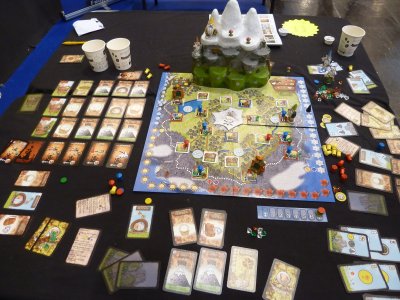
As the mentioning of 52 weeks of travelling time might suggest, A Game of Gnomes is run on a mechanism which is based on time consumption, with the players consuming one or more weeks of playing time during their turns. Most prominent among the time consuming activities is travelling between the different locations on the gameboard, and for this action the players have to use Travel cards which allow them to move across the three types of landscapes which can be found in Gnomeland: meadows, forests and mountains. The different coloured pathways form a gridwork connecting the different locations on the gameboard, and a gnome can travel most efficiently if he uses Travel cards showing the exact type of landscape through which the gnome wants to travel. In case such a card is not available to the player, other card combinations or Free Travel cards (jokers) also can be used for movement, but these cards usually will consume more than one week for getting from one location to the next.
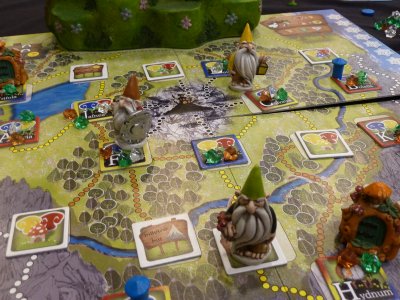
All the time consumed by the players will not directly be recorded on the main Calendar Track (like in Thebes), but instead the time which a player spends during his individual turn for travelling and other activities first will be noted on a separate Timing Track which limits the amount of time a player can spend during his turn to a maximum of 7 weeks. Once all players have finished their turns, the time spent by the Gnome who has advanced farthest on the Timer Track will be transferred over to the Calendar Track, but depending on the relative positions of the other players' individual timers on the Timer Track those players who have spent less weeks during their turns will be allowed to rest, effectively gaining them some additional Travel cards. In this way the game balances between spending time for activities and the players' need to gain new Travel cards, and due to the shifting player order the players will be faced with some quite interesting tactical considerations based on timing issues.
The gnomes travel around the board to pick mushrooms and take them back to villages in exchange of valuable gems, but instead of fixed prices the villages will pay most for the first mushroom to be delivered, less for the second and even less for the third. After the third mushroom, a village looses interest in mushrooms altogether, and so the players strive for making the most valuable deliveries. However, the mushrooms are not simply growing everywhere, but instead mushrooms in different colours grow at some locations when the Main Timer on the Calendar Track comes to a new season, and so the players have to take into consideration the different seasons and the travelling times which it takes to get mushrooms to villages buying this type of mushroom.
Make gnome mistake, the players also face some restrictions which they can tackle by acquiring better equipment. Each gnome starts the game with a tiny rucksack (limiting hand size for Travel and Treasure cards) and a tiny basket (limiting mushroom carrying capacities), and in some shops around the gameboard the gnomes can acquire better equipment which increases their hand or carrying capacities, makes travelling more efficiently or even allows water travel. Apart from the already mentioned items each gnome starts the game in possession of one Tunnel Key which can be used to open the tunnel leading across the gameboard and one Pond Pipe which allows the temporary replacement of the standard gnome figure by an easy-travelling Froghopper, but since each of these items only can be used once other equipment cards will be needed for efficient play. In addition, the shops also offer Treasure cards, useless bric-a-brac which clogs up a player's hand, but these cards will count for additional Victory Point at the game's end
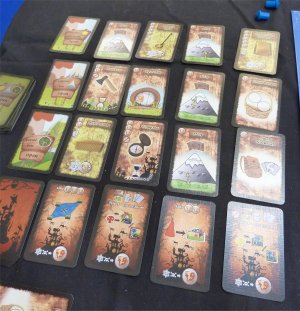
Overshadowing most of the gameboard, the dizzying heights of Mount Gnome challenge the players to make a mountain hike, since the highly valuable mushrooms of the Montane King grow only at the high cliffs of Mount Gnome. Movement to the foot of the mountain is made by standard routes using normal Travel cards, but to climb from one mountain level to the next the players need to use map cards which can be purchased in the shops. These maps offer movement possibilities between different positions on the mountain, and the players need to plan their mountain hikes in advance because each gnome only can carry a maximum of two maps. It is also possible to make normal movements on the mountain itself if the gnome stays on the same level, but due to the narrow mountain pathways it's possible here to get displaced by another gnome. This puts up an additional challenge for players out to collect a Montane King mushroom, and it allows for some minor direct player interaction. However, this gets a major issue when you actually dare to displace a Scottish Gnome!
![[SPIEL]](ess15153.jpg)
As usual for a new FRAGOR game, A Game of Gnomes at first draws a good degree of attention just by the spectacular playing pieces, and this time the Lamont brothers have outdone themselves by including a whole mountain in the game. However, the splendid outer appearance of the playing components is not the only thing shared by FRAGOR games, but in addition the games created by Gordon and Fraser share the common trait that every one of them comes up with some quite interesting mechanisms. Sometimes the designs are a bit fiddly, sometimes on the edge of craziness, but a good entertainment value it's always a safe bet.
In case of A Game of Gnomes, the highlight of the game certainly is the mechanism which the Lamonts have chosen to represent the passing of time. Refining the basic mechanism which can be found in other time-based boardgames like the aforementioned Thebes, the connection between the Main Calendar Track and the time spent by the individual gnomes requires the players to think quite economically when it comes to the spending of time, and even though A Game of Gnomes runs for a total of 52 weeks this time may be spent rather quick if a Gnome is too careless when planning routes or dealing with shops. But what is more, the passing of time on the Calendar Track also has been interwoven with different seasons, and here some fitting in-game effects like the growing or shriveling of mushrooms, the freezing of the rivers or even the wizards footprints in the snow (easier passage to the Wizard's Tower) all contribute to the general challenge of becoming a successful gnomad of Gnomeland.
In fact, due to the amount of tactical considerations which are necessary on side of the players, it is a bit difficult to categorize A Game of Gnomes by a single term like "travelling game" or "adventure game". If compared with other FRAGOR titles, it is certainly less complex than Spellbound, but at the same time it offers more predictability and tactical stability than Dragonscroll. Due to this medium degree of complexity and the cute thematic setting, the game certainly will appeal most to family gamers, and with this target group in mind the Lamonts once again have succeeded in creating a unique, quite charming game with a good entertainment value. All in all, a typical FRAGOR game!
We next made our way over to Hall 3 where Nicole wanted to check out the new game in KOSMOS' Andor-series, but while still in Hall 1 we stopped over at the booth of FUNFORGE where we had seen sales posters announcing the availability of the Deluxe version of Tokaido
![[SPIEL]](ess15160.jpg)
We have actually kickstarted Tokaido Collector's Edition in February 2014, and ever since we have been waiting for the arrival of this edition which will contain painted miniatures, larger and better components, new characters and a small expansion. Following the Kickstarter Updates, I was aware that a Deluxe version of the game with unpainted miniatures now would be available here at the SPIEL, and so we stopped for a minute to take a look at the quality of the miniatures. Not only the figures but the whole game looks rather nice, and a FUNFORGE representative told us that they are awaiting the final samples of the painted miniatures any day now in their office. So, Kickstarter backers of "Samurai" pledges for painted figures will get an update soon, and once again we can start to hope that the game might arrive before Christmas.
![[SPIEL]](ess15161.jpg)
![[SPIEL]](ess15162.jpg)
Crossing the courtyard, we entered Hall 3, but before getting to KOSMOS we actually stopped at the booth of ZOCH where a group of people was handling some strange looking devices.
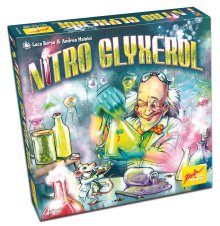
As it seems, crossovers are not only en vogue in the world of cars, but also in the world of gaming. Over the course of this week I have presented you Space Movers 2201 and Catacombs, two games which have their playing mechanisms at least partly based on a player's dexterity. As indicated earlier, this species of games seems to have seen a reanimation with the release of Dungeon Fighter, and today I would like to continue the series with another game fitting into this category.
When dealing with the German ZOCH VERLAG you can always expect something unusual. Apart from their long-standing series of entertaining microgames with animal illustrations and some lavishly equipped big boardgames, over the years Klaus Zoch and his team also have created games using building blocks, crazy riddling games or even balancing games like the great Bamboleo. Today ZOCH is back at the SPIEL with Nitro Glyxerol, another act of daring mischievousness in which designers Luca Borsa and Andrea Mainini challenge the players to go into the lab, take their testing tubes in mix their individual Glyxs-Formula.
The general setting of the game actually resembles the use of a puzzle toy in form of a competition. Most of you will remember that at some time in the past dexterity labyrinth puzzles have been quite popular, shifting boards or walls to move a ball from start to finish without dropping it into one of the many holes along the way. The flat testing tubes of the players - fittingly called "Myxer" - do not have any holes, but there are some walls which will serve as obstacles. Each round of play the players put an assortment of ingredients in form of coloured cubes into the starting zones of their Myxers, and they try to get these cubes into the slim finish zone, moving the cubes by shifting the whole Myxer.
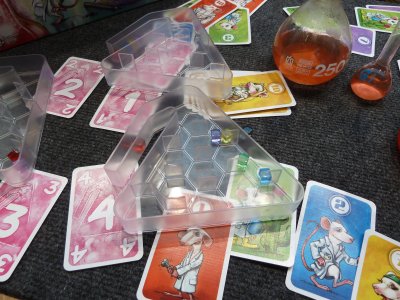
The gaming aspect behind this dexterity task is determined through the use of playing cards, the "Glyx" cards, which define the order in which the cubes must come to rest in the finish zone, and as indicated the players will simultaneously try to solve this task as fast as possible. To increase the stress factor even more, the game also comes with a sand timer, and the players must stop mixing if the sand has ended. However, the players are free to stop at an earlier moment, even if they have not succeeded in getting all cubes into the finish zone, since they may have a chance to claim some of the Ingredient cards if they got the first part of the sequence right.
When everybody has stopped and taken a Ranking card, the Myxers of the players will be evaluated, starting with the player who has stopped first and taken the lowest Ranking card. This player will be entitled to take all Glyx cards for which he was able to arrange his ingredients in the correct colour sequence, beginning with the first ingredient and then checking each subsequent ingredient. If any colour is wrong, this player will not get any of the remaining Glyx cards after the error, but instead the player with the next Ranking card now will be checked whether his colour sequence was longer, entitling him to the Glyx cards which could not have been claimed by the player with the lower Ranking card. In this fashion the evaluation continues until all Glyx cards of the sequence were claimed or all players are out due to mixing errors.
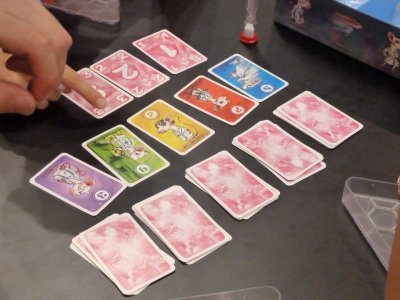
The game runs over a total of 7 mixing rounds, and to give the quickest player of each round an additional handicap he must place an additional Contamination cube into his Myxer for the following round. This Contamination cube must be the first cube in this player's finish zone, because otherwise the regular ingredients will not be scored.
Being noticed by Nicole on our walk through Hall 3, Nitro Glyxerol is outright addictive, keeping the players frantically mixing their ingredients and building up tension till the end of the last round. With Karl-Heinz Schmiel, Daniel Danzer, Walter Scholz and Walter Obert the game designers credit four well-known gamers and designers for their valuable input for the design of Nitro Glyxerol, and the outcome is as entertaining as it is unusual. Taking the idea of crossovers even further than the aforementioned other games, Nitro Glyxerol wakens the ludic drive in all participants. The easy combination between goals which must be reached through dexterity and a card driven challenge and scoring system has been implemented rather well, giving the game a quite unique feeling. After all, when dealing with ZOCH, always expect the unexpected!
After this visit to ZOCH we continued to, the KOSMOS booth, and here we were lucky, since we could indeed get a seat at a table where the new 2-player game Die Legenden von Andor: Chada & Thorn was available for playing!
![[SPIEL]](ess15155.jpg)
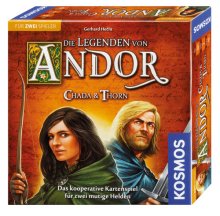
The popularity of fantasy adventure boardgames has seen a considerable comeback in 2012 with the release of Michael Menzel's award-winnig The Legends of Andor. Apart from the quite stunning artwork which was done by the game designer himself, the game offers a quite interesting cooperative strategic approach, challenging the players to think quite well which steps they should take with their adventurers. Even though dice are used to determine the outcome of a combat, there is no simple hack'n slash like in 1980's adventure boardgames, and so it is no wonder that the game has seen one major expansion, two smaller add-ons and nearly a dozen promo items. The big Legends of Andor: Journey to the North expansion has seen the group of adventurers travel northwards to help rescue the far-away Kingdom of Hadria, but now the new 2-player spin-off game Die Legenden von Andor: Chada & Thorn sees the two main heroes, Chada the archeress and Thorn the figher, on their voyage back to Andor to answer a call of the King. In addition, the first Andor-novel also will be released in a couple of days, written by Michael Menzel's wife Stefanie Schmitt who had also been responsible for all the atmospheric card texts in the boardgame. The book will deal with the prologue of the Legends of Andor boardgame, and as a nice sweetener it will also contain an extra card for the game.
![[SPIEL]](ess15156.jpg)
As indicated, Die Legenden von Andor: Chada & Thorn is a spin-off of the Andor-series, meaning that it develops the story further without actually expanding the main game. This can also be seen by the fact that this game has been designed by Gerhard Hecht, thus giving Michael Menzel a possibility to return to the role of illustrator and creative director. Once again, the game is purely cooperative, putting the two players up to the task to guide Chada and Thorn through 4 arduous stages of their homeward voyage. Although the general course of each of the four stages is similar, there is no need to play them all at once as each stage is a game of its own. In addition, just like the big Die Legenden von Andor game, Die Legenden von Andor: Chada & Thorn features some additional Adventure cards for each stage, thus allowing the game to be replayed without becoming too repetitive.
Quite unexpectedly, the Adventure cards used for each stage of the journey do not list any kind of events which the heroes will have to solve. In this game the role of Event cards has been assigned to a deck of Fog card, listing an assortment especially of monsters and other enemies which the heroes might encounter. The Adventure cards on the other hand are used to depict the route of the heroes, with four cards coming together to form a small gameboard showing the possible routes the characters have to take and the events which may happen along the way.
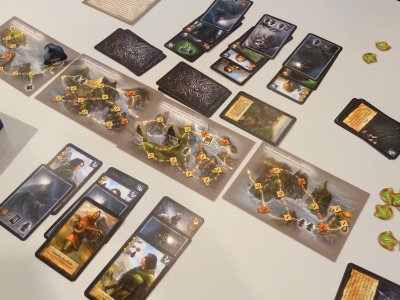
Each player begins each stage in possession of three Hero cards showing his chosen character in three different poses. These cards will be placed next to each other in front of the player, thus marking the beginning of three individual card rows held by each player. Behind each Hero card, with a slight shift to remain partly visible, a randomly drawn Curse card will be placed, and apart from some Will-point markers these sets of six cards per player are all they get to start on a stage of the journey. Both Hero figures then will be placed on their starting positions on the first of the four Adventure cards, and the game begins with the first player turn.
Using a mechanism similar to the one Gerhard Hecht had employed in Kashgar: Händler der Seidenstraße, during their turns the players always are obliged to use one of the three cards at the beginning of one of their card rows. During the first turn of each player this will be one of the three Hero cards, but after the card is used it will be moved to the end of its row, now moving all cards which have been behind one step forwards. During the start phase this means that one of the Curse cards now will be the top card of its row, and sooner or later the players will have to play one of their Curse cards in order to get back the Hero card behind it.
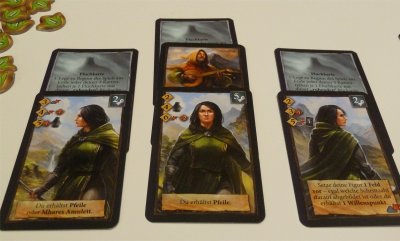
As can be suspected, the Hero and Curse cards are not the only cards forming the three card rows, but during the course of the game the players will add Enemy cards appearing on Fog cards, allies or useful equipment, and all these cards will be added to the back of the card row from which the top card has been used for the player's current action. This way the card rows will get longer, challenging the players to coordinate their cardplay in order to run the game efficiently.
The Hero cards are the centerpiece for a player's actions, since they can be used for moving the Hero figure on the gameboard, for fighting against Enemy cards and for activating the special abilities listed on the card. A well timed use of the three abilities of each hero card is quite essential, since the game puts several challenges against the heroes which need to be overcome in due time. On the one hand, the Hero figures need to keep moving on their travelling route over the four Adventure cards, since a Curse figure - triggered by the Curse cards - will keep moving behind them, making the players loose the game if the Curse figure ever catches up with one of the heroes.
Like in other adventure games, quite a few things may happen along the route, and so the players have to spend varying amounts of movement points for each step, and they will have to face events like the drawing of Fog card, the loss of Will-point markers etc. as depicted on the Adventure cards. As indicated, the Fog cards usually trigger the appearance of enemies, and at the same time they also serve as a timer since only a limited amount of Fog cards is assigned to each Adventure card. If this deck runs out and the players have to draw another Fog card, the game will be lost as well.
Enemies depicted on Fog cards will be added to the end of the card row from which the player has used the top card for his current action. Later on, such Enemy cards will be available for combat at the beginning of their card row, and they must be defeated to keep the card row from being blocked, ending the game if all three of a player's rows are locked up this way. Now the player can use a Hero card lying on top of one of his other rows to defeat the enemy, provided the Hero card is strong enough to do so.
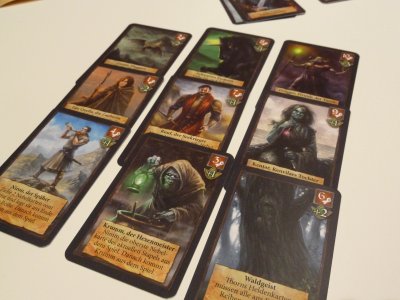
At this point the game gets highly interactive, since the relative positioning of the two Hero figures on the "gameboard" allows the players to defeat an enemy in one of the other player's card rows if the two Hero figures are on adjacent spaces. Likewise, the heroes can join forces or exchange Will-points and Equipment cards if they are on adjacent spaces, and so the players have to strive to stay as close together as possible. While this may actually sound easy, the composition of the routes and the abilities of the Hero cards often may force the one or other hero to take a detour, and so it becomes an interesting challenge to adjust cardplay and timing to get the heroes back together.
As can be imagined, the level of complexity grows with each new card added to one of the players' rows, and the players will have to keep their card rows in balance by adding valuable Equipment cards and other cards with positive effects. This is essential since each new card added to a card row actually will delay the reappearance of one of the three Hero cards, and so the Equipment cards with their limited field of use can partly replace the Hero cards when it comes to defeating monsters or moving.
A stage of the game is won if both Hero figures are able to reach the final space on the fourth Adventure card before the game tips against them due to one of the ending conditions. As indicated, each of the four stages can be played separately, and indeed the players will not take anything forwards from one stage to the next.
Die Legenden von Andor: Chada & Thorn is not only a nice continuation of the story begun in Die Legenden von Andor, but it actually puts the players to solve a puzzle of similar complexity. Just like the bigger game, timing issues are really important here, but instead of spending time for actions the players now will have to focus on coordinating their cardplay, keeping an eye on the cards which will sooner or later re-appear in each of their card rows. Due to some special cards and conditions each of the four stages of the game has some minor unique elements, and the replay value is increased due to the alternative Adventure cards which can be used on a random basis. Fans of the world of Andor will greatly appreciate this atmospheric new chapter in the stories of the main heroes, and also other players with a liking for cooperative adventure games should not shy back from giving the game a try. For players being new to the world of Andor the setting may be a bit unusual since it only covers part of a major story, but the game offers an interesting challenge and enough atmosphere to be played for its own merits.
Having a chance to check out the contents of the Machi Koro Großstadt Erweiterung here at the KOSMOS booth, I had to get a copy of this expansion set, since it features a card depicting my office. Now I can finally tax the rich citizens of Machi Koro!
![[SPIEL]](ess15157.jpg)
Next stop for Nicole and me was a short breather at the Press Gallery at the end of Hall 3, and here Nicole and I took the opportunity to check out the new expansion set for one of our favourite games, Takenoko by Antoine Bauza.

Cute Panda babies - who doesn't simply love them? Well, I know a certain Gardener in the Imperial Gardens of Japan who is not really fond of Pandas, and the reason of his deep-rooted antipathy is connected with the Panda's love for his prized bamboo plantations…
Do you remember Takenoko, Antoine Bauza's epic duel between Panda and Gardener released in 2011? Well, in the game the players try to score by fulfilling Objective cards showing certain arrangements of Garden plots, groves of Bamboo sprouts and bamboo sections to be eaten by the Panda. The players can control both the Gardener who is responsible for growing Bamboo and the Panda who is eating it. The player who has most efficiently managed both figures to fulfill most Objective cards usually is declared the winner of the game, but now the balance of power in the Royal Gardens will be shifted heavily towards the Panda side, since the new Takenoko: Chibis expansion does not only include a new "Miss Panda" figurine, but also 9 new tokens for Panda Babies. I somewhat pity the poor Gardener…
But what's new in terms of gameplay? The expansion set comes with 6 new garden plots, each bearing a small symbol of Miss Panda. Whenever a player adds such a plot to the Garden, the figurine of Miss Panda will be placed there, but the players also may opt to move her in normal fashion instead of the Panda. Whenever Miss Panda moves onto a plot with the Panda present, Miss Panda may bring a baby into the world, provided the active player spends a Bamboo section of the same colour as the plot where the Pandas have met. If the player does so, he will receive a Panda Baby token of this colour.
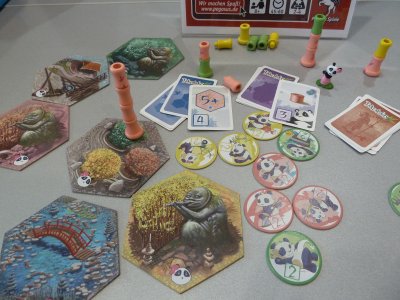
Each of these Panda Babies will count for 2 Victory Points when the game is over, but the babies also provide for a small in-game benefit. So, depending on the Panda baby token chosen, the player will receive a free Irrigation Channel, an Improvement or he will be allowed to exchange one Objective card from his hand for a new one.
The new Garden plots also have some special functions. Three of them show sacred hills, and if the Gardener is moved onto such a plot not just the Bamboo on this plot, but the Bamboo on all irrigated plots of the same colour actually will start to grow. Concerning irrigation, the new tile set also contains one Celestial Pond tile, and just like the Central Pond in the base game this new pond can be used to automatically irrigate all surrounding tiles. The Gardener also gets a tile with his cabin, and if the Gardener figure is moved to this plot the active player will be entitled to draw the top card from each of the three Objective decks and keep one card of his choice.
Apart from the fact that Miss Panda and her Babies offer some nice extra options for scoring, especially the possibilities to chose or replace Objective cards introduced in Takenoko: Chibis seem to partly deal with a problem which has been identified in issue 4/2012 of the SPIELBOX magazine. Here it was observed that the element of luck when drawing new Objective cards is relatively high and can lead to slight imbalances when the game is in its end phase, and so the new options which provide possibilities to exchange and redraw Objective cards can be appreciated from a gamer's perspective. In consideration of the fact that the expansion also includes some new Objective cards, this phenomenon has been partly mitigated, but it should be kept in mind that Takenoko still is a game with a comparatively high luck factor.
![[SPIEL]](ess15158.jpg)
With me and Nicole taking a short break to munch some sandwiches, let's check out what Ralf has been doing on this final convention day!
![[SPIEL]](ess15171.jpg)
|
Welcome back for the final day of SPIEL2015. For four years now sunday has been my children day. So I came to SPIEL with my older son today and together with two friends of mine - who also had come with a child - we looked after interesting children and family games. It is always amazing where the children are heading. You can have visited the fair on all other days (like myself), so you would think that you have already a good overview and had a look at all the different booths, but when you go with your children they move you to locations and games you have never seen before. It is not that you had not passed the corresponding booths, you just hadn't recognized that the one or other game might please your children. So this day every year is a new experience for me. First stop for today was the booth of CRANIO CREATIONS. I really like this Italian publisher. In the past they always did something unpredictable, sometimes even crazy. So let us have a look what they offered for my family my children and my other gaming groups: Before we begin I have to say that since the beginning of this year I am a member of a large gaming group. When we meet, we are normally six players and more and even with my huge amount of board games, I am getting short presenting new games to this group. Most games I possess are designed for 2-5, sometimes for 6 players. This is the moment when a lot of deduction games come into play. And indeed, this group likes playing Werewolf games, Krimi total and comparable games designed for really big groups. I must confess that I personally don't get the excitement of all those Werewolf games. You can be thrown out of the game without ever having a chance to prove you are innocent and no hint declares you to be the bad player (OK maybe one player knows: but he convinces the other players purely by palavering...). When it comes to a deduction I normally prefer games with subtle hints like the great The resistance. Review: Unusual Suspects (Cranio Creations, Booth 1-A118)
Now the first game we played at CRANIO CREATIONS was - of course - a deductive game. When I heard that Unusual suspects is designed for 3-16 players, I said why not, maybe just the right game to satisfy me, my family and my new gaming group. The story of the game is quite simple. A witness has seen a thief but does not really remember all details about him. But he can tell a lot of the thief's habits, tastes and opinions. How he exactly know these details, but not his look, nobody knows. Anyway, someone will know... So this witness is played by one of the players. Only he knows which of the 12 possible suspects, that in kind of suspect cards are placed on the table, is the thief. But as he cannot describe him, he must be interrogated by all other players (who present the police) and asked about the preferences of the thief. Now how does this work? Well, first thing we had to learn is that all players, with the exception of the witness, form the investigative team and work together. So in reality the game is independent from the player number, the investigative team only discuss about the suspects, but there are no individual turns of the single team members. The questioning itself is done by drawing cards from a question deck and reading out loud what the card says. In return the witness answers with yes or no. It is the task of the investigative team to discuss about who of the suspects might correspond to the answer. At a result they have to eliminate at least one card from the suspects (who (they think) does not correspond to the answer) for each round of questioning. But they may also eliminate more cards. If one of the eliminated suspects was the guilty, they have lost, if not, the questioning takes on until only one suspect card remains on the table. Of course, this final card must be the guilty. 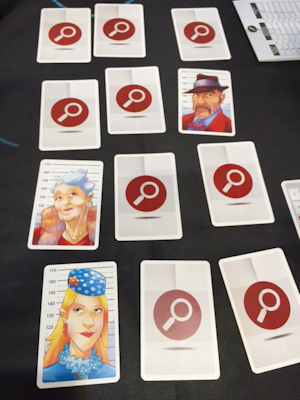 Quite a simple game and perhaps while reading this you might think: is this enough? At least this was my first thought after I had heard the rules. But on the other hand: what are the rules of those Werewolf games? And in fact, the game play was much more fun that I had thought. Together with the guy who explained the rules to us, my son and I had a lot of laughter in the discussion phase, because each team member had different ideas about who of the suspects correspond to the answers and who do not. All the different opinions were amplified with a - sometimes very strange - story about why a suspect should answer yes or no. My son loved the game and I also decided that Unusual suspects would get a chance in my large gaming group. For me the game had the right mixture between free discussions and subtle hints (the faces on the suspect cards). It is a family and a party game and I think that a lot of casual players will love it. 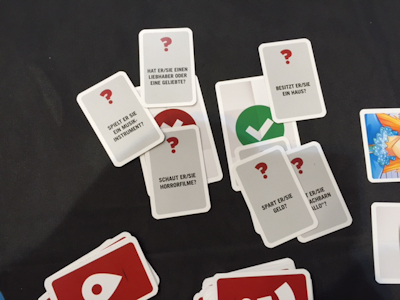 After this experience I led my son to the booth of MATTEL where we had a closer look to their fourth game in a series for families and children. I got the chance to meet the two authors of the game, Jens-Peter Schliemann and Guido Hoffmann yesterday, so I wanted to see how the game would be taken on by the children. Introduction: Das Geheimnis der Zauberer (Mattel, Booth 2-C121)
In the game the players are magicians who gather together to decide who of them will be worthy to enter the fraternal order. For this the young magicians must pass a test. One by one they have to go to a hall of mirrors and all other magicians must try to discover the magician's secrets. But they may not be distracted by all the illusions they see in the mirrors. The game is very material-intensive. The walls of the great hall of the game consists of 12 mirror walls that are put into slots of a castle that is put on top of the box of the game, so that everyone has the game at eye level. On the inside of the wall tiles there are real mirrors that play a major role in the game as you will see. The rules of the game are quite simple: One by one of the eight magician figures are placed in the great hall. So in the end all of the 9 magicians are inside the great hall. To identify the last magician, who was sent there, you use a hut, that is passed on to the next magician after the test of the magician again. 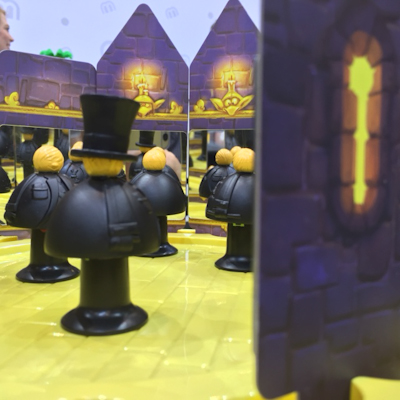 Now, by command each of the 2-4 players remove one of the mirror wall tiles from the side they are sitting and tries to look under the magician's cloak. The reason for this strange process is that the the magicians have symbols on both sides under their cloak that reveal their secret spell (one symbol in front of the figure and one in the back). The rules do not explained why the magicians have their most precious secret right under their cloak, but I guess they are so nervous that they needed a crib sheet for passing the test of something like that. 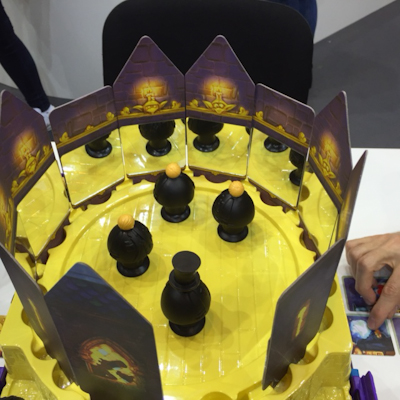 According to where the magician has precisely been placed in the great hall, a player may see more or less what the magician is hiding. In most cases however, it is necessary to look from various angles. Sometimes it will be quite easy to see the front symbol and you with the help of only one mirror you also can see what he is hiding at his back. So in this case the player will be able to know exactly which spell the magician is hiding. But sometimes you also have to guess, because you only can see glimpses of the one or other symbol. It is quite helpful, that the symbols have also colours and each player has the symbols with the same colours on his deck of spell cards. So once all players think they have seen enough, they take the two corresponding spell cards from their hand that have the same symbols a player has seen on the figure. Again at a command they show their guess to the other players and speak the spell out loud (so for example a fire symbol on the one side and a shield on the other side would be the spell fireshield). That all seems to be quite simple, but it is much harder when you are sitting there with the great hall face to face. Not all positions of a magician in the great hall will be good for every player. It all depends on the angle a player is looking from. So there might be a game situation, in that one player perfectly sees the front and the back symbols on the magician, while another player only can see the symbol at the front. In the latter case, it is time for guessing. This guessing becomes easier with progressing time, because every spell combination can only be found once in the game. 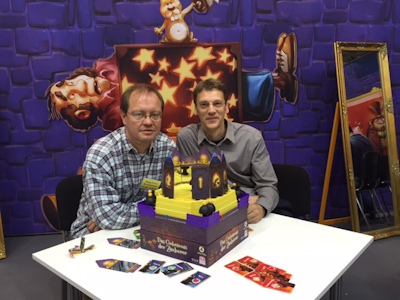 Still the difficulty level raises during the game, because magicians stay in the great hall after they were tested and can reduce your field of vision. The simple rule: an angle of incidence is equal to the angle of reflection only helps partly in the game. Of course it is still right but in most cases it will be necessary to look through more than one mirror to see the both symbols of a magician. With four players there are still eight mirror walls with different angles to a player, so looking in one mirror will often lead your eye to the next mirror again. So this is a great experience for children and grown-ups likewise. It is a little bit like really standing in a hall of mirrors. A perfect condition for immersing in the game. The game ends after all magicians have been added to the great hall and the last spell was guessed. Jens-Peter and Guido told me that it took them a lot of time before they finally had the idea of the 12 mirrors to form the great hall. They wanted to create something very special, haptic and challenging for children and parents likewise. It not only had to be simply a three-dimensional game, but they wanted to create a unique game atmosphere. That's why they moved away from their first idea of just using one mirror. They wanted to have the game much more unpredictable, but at the same time they wanted to encourage the children and their parents to explore their surroundings more precisely and by this to stimulate them to look in the great hall from many different angles. Das Geheimnis der Zauberer seems to be a wonderful game for children. There is much to be discovered, the children pretty much like the story of the game and the beautiful mirror walls create a unique game atmosphere. Jens-Peter and Guido also assured that it would be a game for the whole family. I will try this with my family and tell you about it in a few couple of weeks. But by now I am already quite sure that my children will love it, at least that was what my older son told me after playing the game. There were a lot of other games the children were interested in, but in most cases we only played some round. So just have a look at the pictures. ![[SPIEL]](ess15172.jpg) ![[SPIEL]](ess15173.jpg) ![[SPIEL]](ess15174.jpg) ![[SPIEL]](ess15175.jpg) ![[SPIEL]](ess15176.jpg) At some point the children got tired and wanted to play just with building bricks. So we went to the booth of CUBORO and to the gallery afterwards, where they had plenty of bricks by KAPLA. ![[SPIEL]](ess15177.jpg) ![[SPIEL]](ess15178.jpg) While all the children were happy I together together with the other fathers had time to do a last test for today. Introduction: Baby Blues (Tenk, Booth 7-A104)
After the birth of my second child we decided that this would definitely be our last one. You know: one child is nothing, but two are a hard challenge for your daily routine. If you - like me - are playing and writing reviews of board games in addition to your daily job, you - after nights of crying- find yourself some days on your last legs. I do not know how many reviews I have written in the morning hours between 5 and 7 am, because I was called by my younger son and could not find back to sleep afterwards. Partly this could be the reason why I passed by the booth of TENK up to this moment. As the artwork is quite simple I even had problems convincing my friends, also fathers, to play a round of the game with me. But this day I had to try it and so I was stubborn. In the end they agreed and did not regret this decision. But why had I chosen to play this game now, while on the other days I went by without even having a closer look? The reason was definitely that this simple game was in the TOP 5 of BGG' s buzz from the SPIEL. So there should be something special with the game. 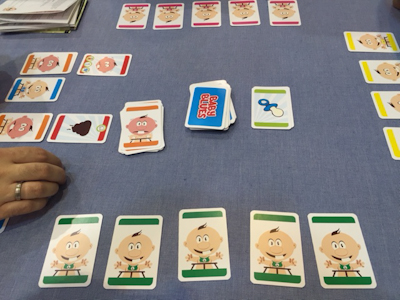 In fact the game turned out to be very simple. Each player has a set of five happy babies. Happy? Well that pertains for the start of the game but will be changed soon after, as you will see. Each player is equipped with five cards that my have negative or positive effects. Negative effects to a baby are all the things that make a baby unhappy, so it soon after will start to cry. Basically these things are poo in the diaper, a stolen pacifier and hunger. Of course you are not forced to play these negative effects to your own babies, but you will better like to play them to the babies of your competitors. Each turn one of these bad cards can be played.  Unhappy babies are not good. So a player must get rid of all these bad cards until the end of his turn or his baby will start to cry. This is the end for the baby in the game and so it cannot contribute to the player's victory points any more. Now what do you do with an unhappy baby? Of course you calm it by giving him or her what he or she is longing for: a new diaper, a pacifier back in the mouth and bottles of milk or food, that take the babies several rounds to consume. Temporarily music will also work. In his turn a player may play this good cards additionally to the bad cards to quieten his babies and make them happy again. Each matching good card cancels the effect of a bad one. That are the basic rules but there are also a few more complex cards to further cause disturbances to your competitors. So you can play empty bottles or cans to cancel the good cards a baby drinks or eats from. And you can play a nervous baby above an already crying one, to start a chain reaction to the adjacent babies. Baby Blues is a mean game. It is simple, fast and will be played by men and women likewise. To my astonishment we all liked the game. I can't even say exactly why. Maybe it is because we all had our experiences with crying babies, maybe it is because it is brilliant suitable for giving your friends a wipe. But it works. I saw a lot of people leaving the booth with more than one copy (me included). So I guess it is in the TOP 5 with good reason. I will check this with my wife and my various gaming groups, but I am already quite sure, that this will be of the most successful filler games for the next months. So with this small surprise I come to an end of my daily reports from SPIEL2015. I am leaving you now with mixed feelings. On the one hand I am glad that I will get some sleep, on the other hand I would like to continue playing at this great fair. But remember: There are only 367 days left until the next SPIEL by now. So stay tuned, a lot of reviews wait to be written. I hope you enjoyed our experiences. Bye-bye and see you back for the next SPIEL reports in 2016!!! Yours truly, Ralf Togler |
After our break Nicole and I returned to Hall 3, and as it turned out this Hall was quite a treasure trove for today's visit at the SPIEL. Nicole kept her eye out for extraordinary looking games, and she stopped at the booth of LUDONAUTE where there were some supersize-versions of Colt Express available for playtesting. We arrived at the train station when the train was just about to leave, and so Nicole and I hopped aboard for our first Colt Express trip!
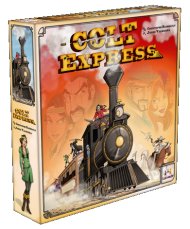
A game about a Wild West Train Robbery? Now, that's a fresh theme indeed, and even though LUDONAUTE's Colt Express was already released in 2014, the sight of the 3-dimensional train and the winning of the prestigious Spiel des Jahres 2015 awards was enough to win Nicole and me over to sit down at the ASMODEE booth and try the game. In addition, we had gathered as bystanders that the game was based on a programming mechanism in which the players have to plan the next few moves of their characters, and since both Nicole and I are great fans of Roborally this was another fact which had attracted us to check the game out.
Two to six players can participate in this holdup gone boardgame, but whereas the two-player variant sees each player taking control of a team of two outlaws in a more strategically orientated game, games with five or six players will follow a slightly more unpredictable but entertaining "the more, the merrier" approach. So, the players Start with their outlaw figures being positioned in one of the last carriages of the train, and during the game they will try to move through the train, trying to collect valuables like purses, jewelry and rather valuable strongboxes.
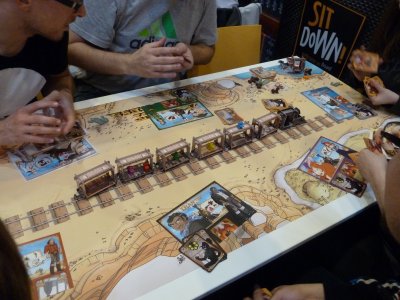
Each player possesses an identical deck of 10 Action cards which he will shuffle at the beginning of a round, and from the shuffled deck each player will draw a hand of six cards which he may now use to plan his actions. Unlike Roborally where always a total of 5 programming cards is placed face-down in front of the players, Colt Express uses a deck of randomly drawn Round cards to determine how many Action cards each player will be allowed to play during a round. In addition, the Action cards will be played one at a time in player order, and all cards will be combined in a face-up deck which is turned face-down once the programming phase of a round has been finished. Then the cards will be revealed one at a time, allowing the player who has played the revealed card to perform the corresponding action.
The choice of available actions ranges from collecting valuables in the carriages, moving from one carriage to the next or climbing on top of the train to more nasty tricks like the movement of a Marshal or hitting/shooting at opposing characters. The valuables need to be collected in order to win the game since the player with the biggest loot after 5 rounds of play will be declared winner, but shooting at another character or sending the Marshal to catch someone will result in the assignment of Bullet-cards. So, if a player's character is shot at, he will be assigned a Bullet-card (either from the firing player or from the neutral Marshal-deck), and these Bullet-cards will be added to the victim's deck of Action cards. During the course of the game the player now may find Bullet-cards whenever he draws cards from his Action deck (either at the beginning of a round or when he spends an action to draw additional cards), and these cards are troublesome in so far as they just clog up the player's Action deck without any further use. So, the more Bullets a deck contains, the higher the chance to find Bullets instead of normal Action cards, and this may result in a player having a smaller choice of available actions.

To offer a versatile playing experience, the Round cards do not only specify how many Action cards will be played each round, but instead they may also bring along events like a tunnel which may result in the face-down playing of Action cards or an uproar among the train's passengers, resulting in every outlaw in the train being assigned a Bullet card. Additional spice and variety is added by the fact that each outlaw has a special ability which may prove helpful when performing the one or other action, and taken together all these elements make up a quite entertaining gameplay with many funny, unexpected turns.
Unlike other programming-games, the players usually will reveal their Action cards when they place them into the common Action deck. This open placement procedure gives all players some ideas on the course of action chosen by their competitors, but it is nonetheless a rather interesting challenge to try to gain an advantage out of this knowledge. Some unexpected turn of events may be triggered by many situations, for example if one player uses a "Punch" Action card on another outlaw in the same carriage. The victim of the blow does not only lose something valuable, but he will also be relocated into a neighboring carriage, and since all victims are chosen only when programming has finished and the card appears in the common deck, actions like this may have a great impact on another player's planned course of action. It is exactly due to the frequency of possible interruptions that the programming mechanism is much less strategic in Colt Express in comparison to other games like Roborally.
At this point it should be kept in mind that Colt Express has won the "traditional" Spiel des Jahres awards which always was meant to distinguish the best "family game". If taken for its interesting but not overburdened playing mechanism, the catchy theme and the high entertainment value, the game excels all expectations and guarantees hours of playing fun. In addition, our gaming groups often are attended by a total of six players, but since many light strategy games are limited to a cast of five, Colt Express is one of the more rare gems which can be played rather well with 5 or 6 players. With all these elements falling in place, I fail to see any contestant which may have beaten Colt Express for the family version of the Spiel des Jahres awards.
Are you in for a trip of madness to a lonely island? Well, if this should be the case, read on about Nicole's and my next gaming experience, a 15-minute trip to the island of the Penguin cannibals…
![[SPIEL]](ess15159.jpg)
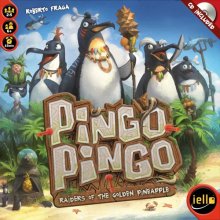
Do you know what a dart gun, penguins and a golden pinapple have in common? Well, they all come together in Pingo Pingo, a crazy idea gone boardgame which has been designed by Roberto Fraga. So, welcome to the Bedlam!
To be honest, when I first saw a glimpse of the tribal penguins drawn on the cover of the new IELLO game Pingo Pingo, I expected some sort of light board- or cardgame since these kinds of games have been IELLOs most prominent trademark, but as it was this assumption turned out to be wrong since the game belongs to the broad category of speed and dexterity games.
Hunting for the famous Golden Pinapple and other treasures, the players have anchored their ship in a bay of a mysterious island, and they have 15 minutes of real time to find and salvage as many treasures as possible. Just like Zombie '15, the passing time is represented by a soundtrack, and the game ends when one of the soundtracks on the included CD is over. Apart from the general function as a timer, the soundtrack also differentiates between daytime and nighttime during the game, since two different tunes alternate approximately every 30 seconds, interrupted by the frantic "Pingo Pingo" cries of the native penguins who make hunt for the players.
The game itself is driven by a deck of Adventure cards which has been split evenly among the players. Each player has received a random share of these cards which he has placed face-down in front of himself, and during his turn the player will turn over the topmost card from this deck and show it to the other players. This revealing of the card should be done in a fluid motion, since the card's front side quite often will trigger some kind of hectic reaction from the other players.
If the card shows a treasure, it may be claimed by the first player who succeeds in tapping the card with a finger. But beware! Each Treasure card may only be claimed by day or night (depending on the card's background colour), and a player who taps the card at the wrong time of the day will lose a Life Point instead of getting the treasure. Likewise, there exist some Treasure cards which have been trapped (shown by a small variation of the picture on the card), and a player tapping a trapped card will receive a wound as well. Players who have received a total of 7 wounds are out of the game, and so some care must be taken not to lose too many Life Points in the hectic rush for the Treasure cards.
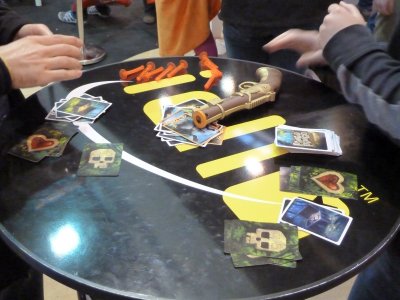
However, even a correctly claimed Treasure card is not really save from the greedy hands of the competing players. The deck of Adventure cards contains Camp cards as a second category, and once again these cards exist in day and night versions, trapped and untrapped. A player who correctly taps with his finger on a Camp card will be entitled to steal two Treasure cards from players of his choice, and so even the already collected Treasure cards keep changing hands.
These two categories of cards set the game's basic pace, but Roberto Fraga's special wickedness enters the game by some nasty specialties. For one, all cards which cannot be claimed due to traps or wrong daytime are left on the table, and at least the cards which are untrapped still can be claimed when the daytime changes. So, apart from concentrating on the upcoming new Adventure card, the players also need to be aware of the other cards left on the table, since the change of daytime triggered by the frantic cry of "Pingo Pingo" may bring up some opportunities which have been blocked so far.
Want some more action? Well, here we go, since the deck of Adventure cards also contains some Event cards which will bring even more kinds of craziness. Comparatively harmless is the Monkey Sorcerer who will grant the first person tapping him to heal one Life Point, and also the Penguin Rampage card can be dealt with quite easily since the active player just has to collect all revealed Adventure cards form the table and re-distribute them amongst the players. However, the player must be quick to do so, because the ringing of the "Pingo Pingo" cry before the player has finished will result in the loss of a Life Point.
Real action comes up when one of the other three kinds of Event cards appears. Before the game begins, stand up targets showing a Pirate hip, two ends of a Rope Bridge, a bear-rider Penguin and the fearful Space Penguin have been distributed among the room, and depending on the Event card revealed the active player now may be challenged to run and touch some of these targets (Pirate Ship, Rope Bridge) or to shoot them with the pirate dart gun which has been placed in the middle of the gaming table (bear-riding Penguin, Space Penguin). If the player fails to solve his task before the "Pingo Pingo" cry rings out, another Life Point will be lost.
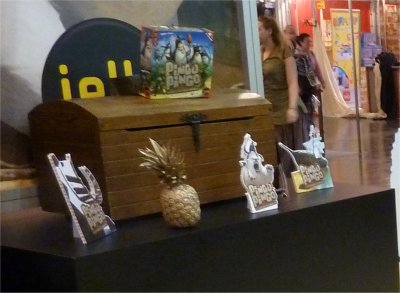
The penguins on the box cover look as crazy as their movie counterparts in the Madagascar movie, and indeed Pingo Pingo follows the same tune since the players are challenged to 15 minutes of madhouse mayhem. The game is a happening - there is no doubt about it - and if played with the right minded group of players groans and bursts of laughter will be heard all along the way. An uncommon factor certainly is the fact that the players really have to move and run to reach some targets, and especially if played with younger treasure hunters (6+ is the age recommendation) it is a must to get breakable furniture and other delicate items well out of the way. Due to this additional action it seems that Pingo Pingo actually is mostly aimed at an audience containing a majority of children, since they will certainly enjoy all this running and shooting to the greatest extent. Older players may be more careful, since the old saying goes: "The worst accidents occur at home!"
Thinking back about the use of dart guns in boardgames, two titles spring to my mind. One of them is Supergang, a classic mobster game which has been released by LUDODELIRE all way back in 1985. The other game, Cop & Killer was done in 2007 by GAMEHEADS, a small publisher located in Berlin. However, whereas both of these games tried to embed the dart gun shooting into a somewhat strategic gameplay, Pingo Pingo does not even try to make the difficult combination of shooting and tactical gaming. Instead, Pingo Pingo positions itself clearly on the light fun and action side, a decision which greatly enhances the overall playing experience. In addition, the dart gun included in the game is not only fashion made just for Pingo Pingo, but it actually seems to be a high quality toy. I had discussed my good impression on the workmanship with Matthieu from IELLO on thursday, and he had confirmed that the game had been sold in France since summer and only two guns had been returned to them with a defect.
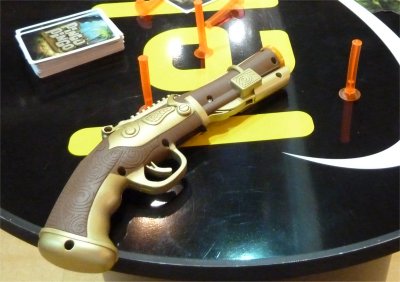
Once again we rounded just another corner, and this time Nicole and I stopped at the booth of BLACKROCK GAMES in order to take a look at Aya, a game Nicole has descried in the Press Gallery.

Once again, Aya is a gaming crossover with dexterity elements, belonging to a species of games which we have seen quite a few times here at the SPIEL '15. In the game the players take the roles of photographs exploring the course of a river, and during the game the players will cooperate to build up a branching river using Domino-like River blocks, trying to mount a chain of blocks which will fully fall over when the game is over.
Taking turns, the players have to place River blocks from their stockpiles to build up the river, and they will strive to include elements of scenery in order to take pictures. Some of the River Blocks show a photographers' icon, and if such a Block is placed the players can try to include these scenery elements in their buildup, but with the requirement that only Blocks belonging to this type of landscape may be used for placement on the scenery boards. In likewise fashion, the players also can take pictures of animals, placing the animal disks on top of fitting River blocks which have been placed after a camera.
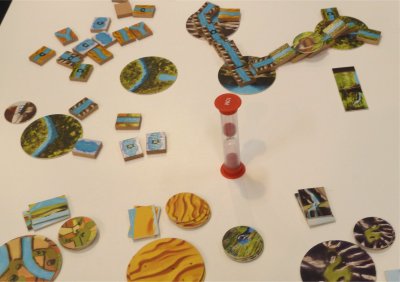
The players try to build as much as they can within a time frame of 20 minutes, and everyone who has event built a chain of Domino- blocks knows that it's sometimes a difficult task to include bents and branchings in the course of blocks. In the end, the players will see how much of their construction chain really will tip over, and only these parts will be scored. Playing against their highscores, the players are challenged to get better each game, and they get some scores for orientation how their current score can be ranked.
Aya sounds like a quite unusual concept, and I know that my wife has a liking for games which leave the well-trodden paths of strategy boardgames. Even though the game had not quite made it to the show, the graphics and playing components of the final production copy available for playing convinced us to order a copy right here at the SPIEL, and BLACKROCK GAMES promised that the game will be delivered to our home without any surcharge within the next two weeks. Well, it sounds like this will not end up like the Tokaido Collector's Edition…
![[SPIEL]](ess15163.jpg)
As afternoon had progressed quite well with all this playtesting, and we were taking a final round through the halls, saying goodbye to some friends and getting ready to get home where our cats were waiting to get something to eat. However, while crossing Hall 2 we once again were stopped on our way, and this time we came across the booth of French publisher SUPERLUDE, a distribution partner of IELLO who had been responsible for the design of Night of the Grand Octopus. At this booth we saw a column of square advertisement boxes, showing comic images which might right have come from Disney's Mulan animated movie. Ever since our working time in China Nicole and I are quite fond of Asia-themed games, and especially this advertisement of Kenjin forced us to make a final stopover!
![[SPIEL]](ess15164.jpg)
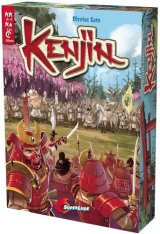
In Kenjin two to four Warlords of feudal Japan are waging war on each other, and each player is separated from his neightbours around the table by two Landmark tiles of differing Victory points for which the neighbouring players will fight. For this reason each player receives a set of 14 Army cards showing some different kinds of units, but apart from some minor variations in artwork all the cards in each player deck are identical, without any special abilities for each player.
Taking turns, the players now have to assign two of their Army cards to one or two of their neighbouring Landscape cards during their turn. Some of these Army cards will be placed openly, whereas others can be placed faced down, leaving the opposing player(s) to speculate which card the player might have used for this placement. When all Army cards have been placed, all cards will be revealed and battles will be carried through for each Landmark card, with the card going to the player who has placed Army cards with a higher strength value on his side. However, the battle is the place where the special abilities of some army cards are triggered, and these abilities may give a player a quite decisive advantage. So, a Samurai card actually will remove some opposing units before the strength values of the cards are compared, but on the other hand the Samurai can be countered by the Archeress, removing the Samurai before his ability comes to bear. Quite strong is the player's Warlord card, since it will add one additional Strength point for each Army card which has been placed at the same Landmark card afterwards.
Other characters on the other hand have special abilities which will be used during the builup phase before battle. So, a Spay or a Wizard can be used to inspect or turn over a face-down enemy card, a General can move a facedown Army card to another Landmark card, and an Assassin actually can remove a freely chosen face-down card from the game, taking its place in the other army instead.
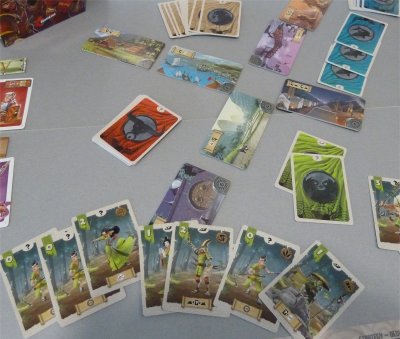
As the game can be played with two two four players, a player either will have one or two opponents which he must take care of at the same time, and each of these settings has its own challenge since the player may have to chose quite different strategies depending on the cast of players. Nicole and me played a two-player game here at the SPIEL, and it quickly developed into a game of wits where both of us where trying to bluff and outwit each other. The factor which makes the setting interesting is the fact that both of us have the same set of 14 Army cards at our disposal, giving us knowledge about the units available to each other.
The hand of 14 cards is quite manageable, and once you get used to the 10 different types of units the game plays rather smoothly without seeing too much downtime. In order to keep the clashes between the players interesting, it's the Landmark cards which offer some variations, not only in terms of Victory Point value but also concerning the battleground depicted on those cards. So, a Supply Base Landmark card actually will bring the winner of this battle an additional Strength point for two of his other battles, whereas a bridge may restrict both adjacent players to a maximum placement of 3 Army cards.
Kenjin actually has given Nicole and me the perfect conclusion for a great SPIEL week. Coming with great artwork in a small box, the game was a must-buy right away, especially since it's once again a perfect game to take along on a holiday trip!
![[SPIEL]](ess15165.jpg)
It's unbelievable, but we are homing in on the end of this year's SPIEL reporting, with Ralf and me having covered slightly over 50 (!!!) games this year. Well, this is a meagre 5 percent of the gamea published here at the SPIEL '15, but if you substract the children's games and many of the small cardgames we certainly have succeeded in presenting you a quite broad choice of interesting games.
When the show draws to its end, I am always quite interested to see the results of the public polls, even though we usually fail to have covered many of the high-ranking mainstream games. Looking at the Fairplay final ranking, it's certainly not different this year, since the only game from their high ranking positions which has been included in our reports is 7 Wonders Duel.
![[SPIEL]](ess15166.jpg)
![[SPIEL]](ess15167.jpg)
7 Wonders Duel actually has won first place at the BGG Geekbuzz poll here at the show, and from the Top-10 of the Geekbuzz list we also had included two more titles in these reports - 504 and Baby Blues. On the one hand this once again confirmes my general impression that our reports usually are meeting gamers' tastes more than the ones of occasional players, but with so many of our covered games falling out of both lists I am also quite happy that we once again have presented a broad bandwidth of games which otherwise would have fallen below radar. Highlights and Hidden Gems - we have them both!
![[SPIEL]](ess15168.jpg)
Well, I am almost done with my reporting as well, but a good tradition which remains for me to be done is the announcement of…
![[Unicorn]](../../../technik/headpage/unihead.gif)
If you look at the stacks of high-class games in my dining room, this is one of the years in which it's especially hard to decide. With 7 Wonders Duel Antoine Bauza and Bruno Cathala have created a game which shines on every aspect, combining a great strategic potential with good player interaction and a gameflow which provides tension from begin until the end. From my perspective the one game which actually beats 7 Wonders Duel for me here at the SPIEL is M.U.L.E., the rather congenial revival of a computer game which I have known from the days of my youth.
![[SPIEL]](ess15169.jpg)
Of course there was a bit of emotion involved when I have decided to give my Convention Hit to M.U.L.E, but Heikki Harju and Tuomo Mattial have not only created an economy game which succeeds in translation a computer-based market-mechanism on a simple but brilliant way into a boardgame, but they have also included many of the wacky moments which have made the computer game such a wonderful experience despite its Stoneage 8-bit graphics. Even the illustrations of M.U.L.E are a great image of the humor found in the game, and - last but not least - the designers have given the players a choice whether they just want to enjoy the atmosphere and play a hardcore economic version, or whether the players actually want to know what kinds of hardships living on Planet Irata can bring along.
Due to these factors, I happily congratulate Heikki, Tuomo and the Wampus to being my SPIEL '15 CONVENTION HIT!
![[SPIEL]](ess14170.jpg)
And here we are - the End has come. It has once again been a pleasure to entertain you for a whole week with news from the world of boardgaming, and once again both Ralf and I hope that you will have found the one or other suggestion on our reports for the coming winter days. Quite a lot rather good games have moved from the convention halls into our homes, and I guess it will take quite a bit of time to just play everything once or twice in the coming weeks. However, there certainly are harder chores…
I am hoping to meet you all back here for the next SPIEL from 13th to 16th of October 2016, and of course we will once again start a few days earlier to build up some momentum for the show. However, don't forget that 2016 actually will be the 20th Anniversary of Kulkmann's Gamebox, and after some chats here at the SPIEL '15 I am rather hopeful that next year we will have some quite extraordinary things happen around here. But I am afraid you will have to wait until next SPIEL for more information!!!
As a final footnote, during our Game of Gnomes this morning first me and then Nicole sometimes looked like we were in front, but in the end Gordon shamelessly used the "Hey, I am one of the designers!" rule on us, snatching victory in the last moment by plucking a Montane King mushroom. He even wanted to get the end game bonus for being highest on the mountain at the end of the year, but at least I could beat him there, displacing his gnome one level downwards. Hah, at least I won the Gnome of Honour for outstanding Mountaineering Mischief!
![[SPIEL]](ess15154.jpg)
Game on!
And see you all back here for another week of SPIEL reporting in October 2016!!!
Greetings from Essen!
Frank Schulte-Kulkmann
P.S. The Prize Draw still will be open for a few more days! All winners will be notified! And once again THANKS for all those great guestbook-entries. Reading them in the middle of the night after finishing a day's report it is just the motivation I need for the next convention day!
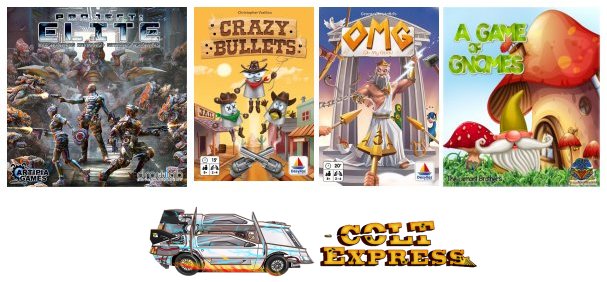
And the Winners are:
Project Elite: Flavio
OMG: Mario
Crazy Bullets: Jacob
A Game of Gnomes: Birgit
Colt Express DeLorean: Tim
All winners have been notified! Congratulations!


You can also go by train to Essen Central Station. If arriving there, go to the basement and take the Subway U11 directly to the Messe Essen.
If you want to arrange lodging at Essen, you best contact the Essen-tourism-center by phone 0049/(0)201/19433 or 0049/(0)201/88720-46 or -48. Perhaps they know where some Hotel-rooms are left...
If you travel to Essen by car, please notice that Germany restricts access to many cities (including Essen) for older cars. While the convention area does not fall under these environmental restrictions if you follow a specific route, you might want to check out the route details at the official Messe Essen website. An even better alternative (especially for those of you having a hotel in Essen) would be the acquiring of an Envirnomental Badge which can be ordered at the offical website of the German Technical Inspection Authority.
If you want to have a look at my coverage of previous conventions, follow these links. But you should bring along some time, especially of you want to read the younger reports...
|
| ||

|
|

|
|
| ||
|
Kulkmann@aol.com
Copyright © 2015 Frank Schulte-Kulkmann, Essen, Germany | ||